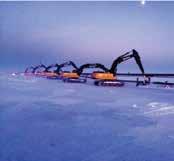











Learn more about what powerful, fuel efficient Volvo haulers can do for your operation.
















Rachael Kvapil

Vanessa Orr

















Learn more about what powerful, fuel efficient Volvo haulers can do for your operation.
















Rachael Kvapil

Vanessa Orr




In Alaska, running a business is as unpredictable as the open sea. With First National, you’re equipped with an experienced team of local experts and innovative tools to navigate toward a bright future. From facility financing to payroll processing, we’re here to help Alaska businesses succeed.
Shape Your Tomorrow






















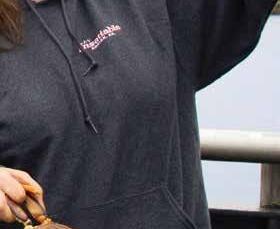






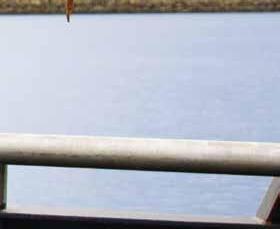

Discover how First National empowers businesses like Insatiable Fisheries to thrive in Alaska’s



48 A POSITIVE OUTLOOK
Spending strong, with a few bumps in the road
By Rindi White
54 TOMORROW’S TECHNOLOGY TODAY
Future-proofing homes for rapidly changing technology
By Rindi White
68 ANCHORAGE AIRPORT INFRASTRUCTURE
Projects moving forward
By Alexandra Kay

40 WOMEN AT WORK
NAWIC builds community in construction
By Jamey Bradbury
Accomplishing a lot with a little
By Nancy Erickson

From left to right, Kim Drake Watson of STG Inc., Lori Kropidlowski of Ahtna Diversified Holdings, Randi DelReal of STG Pacific, Heather Marshburn of Cadence General, Misty Cain of Drake Construction, and Dora Mae Hughes of Knik Construction re-create “Lunch atop a Skyscraper,” the 1932 photo of ironworkers building Rockefeller Center in New York City. Just out of frame, Brianna Carlson of UIC Nappairit supervises. Learn more about these members of the Alaska chapter of the National Association of Women in Construction in this month’s cover story, “Women at Work.”
Special thanks to John Hamilton, a senior estimator and project manager at JD Steel, for helping to supply the girder and the location at the JD Steel yard in Palmer, in the shadow of Pioneer Peak.
Photography by Kerry Tasker
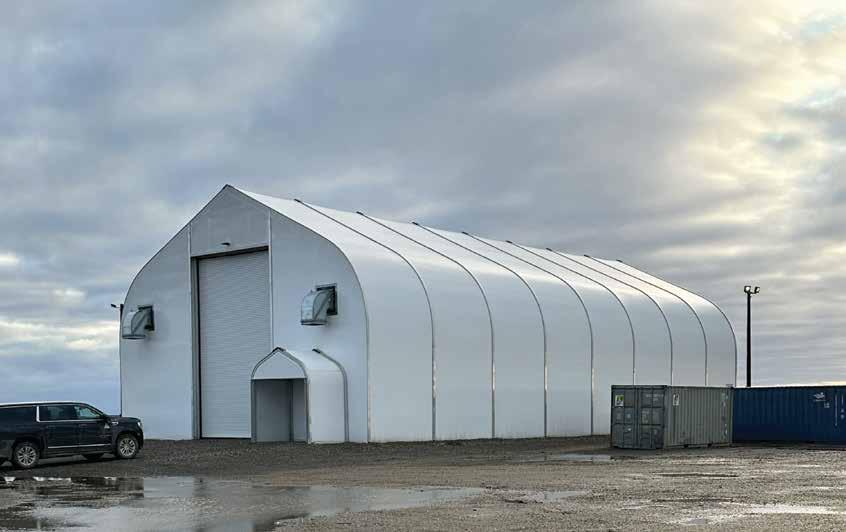
Frac Sands Logistics Storage for the ConocoPhillips Willow Project, Alaska - Sprung designed and delivered a 50’ wide x 99’ long structure that could withstand Prudhoe Bay’s extreme weather conditions.
ConocoPhillips Warming Mud Plant Structure

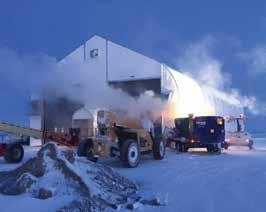
ConocoPhillips KIC Equipment Storage Warming Equipment Warehouse Santos Drilling Warehouse

Backed by more than 130 years of experience and innovation, Sprung Structures is an industry leader in the production of tensioned membrane buildings. Durable, versatile and energy-efficient, our structures have minimal foundation requirements and are carefully engineered to withstand the most extreme weather conditions, making them the ideal building solution for Alaska-based projects. For more information call 1.800.528.9899 or visit sprung.com
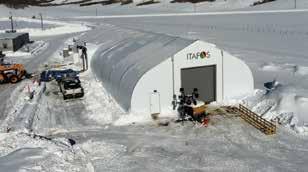

Sprung - Oil and Gas

The rise of AI is a hot topic right now, with many trying to anticipate how it might shape our future, and I think the surest bet is that we don’t really know.
Science fiction of fifty or sixty years ago imagined colonies on Mars and flying cars, milestones we haven’t hit. (Griping about the lack of flying cars always reminds me of a joke my dad used to tell from his US Air Force days about how anything can fly with enough big engines, as proved by the F-4 Phantom. I’d bet good money someone could probably get a car to fly if they were determined. As with so much engineering, the question isn’t always “Can we?” but “Who’s going to pay for it?” or “Is someone going to lose an eye?”)
Society has advanced in numerous ways, with computers not just in every home but at our fingertips and many other advances in technology, manufacturing, and construction.
One result of AI that farseeing minds did anticipate is already rising up: it makes us question what’s real. Our capacity to trust what we read and what we see, if presented on any digital format, is being eroded. As we build our ability to mimic life, we naturally are confronted with our inability to easily parse a photo from a fabrication.
As a fun side effect, this natural skepticism will, of course, be applied to images or videos that are fantastic and factual.
Which leads me to this month’s cover. Believe it or not, the biggest challenge we faced with our cover photo this month was not finding a way to suspend several amazing women in the air on an I beam in front of Pioneer Peak (thank you again, JD Steel!).
No, the biggest challenge was that when our incredible photographer Kerry Tasker turned over the photo, we all thought: “Oh no, it looks Photoshopped.”
At the photoshoot, we emphasized lighting our cover subjects’ faces to make sure we were showing them at their best, but that lighting ultimately flattened the image, making our photo look manufactured. Our incredible art director applied her magic and made a few subtle changes to ground the image—that’s right, we had to modify our very real cover photo to get it to look like an actual photo.
Welcome to the future.


Tasha Anderson

VOLUME 41, #5
Tasha Anderson, Managing Editor
Scott Rhode, Editor/Staff Writer
Rindi White, Associate Editor
Emily Olsen, Editorial Assistant
Monica Sterchi-Lowman, Art Director
Fulvia Caldei Lowe, Production Manager
Patricia Morales, Web Manager
Billie Martin, President
Jason Martin, VP & General Manager
James Barnhill, Accounting Manager
Charles Bell, VP Sales & Marketing 907-257-2909 | cbell@akbizmag.com
Janis J. Plume, Senior Account Manager 907-257-2917 | janis@akbizmag.com
Christine Merki, Senior Account Manager 907-257-2911 | cmerki@akbizmag.com
Tiffany Whited, Marketing Assistant 907-257-2910 | tiffany@akbizmag.com
akbizmag.com | (907) 276-4373
Press releases: press@akbizmag.com
Billing: billing@akbizmag.com
Subscriptions: circulation@akbizmag.com alaska-business-monthly
akbizmag
AKBusinessMonth
AKBusinessMonth
Alaska Business (ISSN 8756-4092) is published monthly by Alaska Business Publishing Co., Inc. 501 W. Northern Lights Boulevard, Suite 100, Anchorage, Alaska 99503-2577; Telephone: (907) 276-4373. © 2025 Alaska Business Publishing Co. All rights reserved. No part of this publication may be reproduced without written permission from the publisher. Alaska Business accepts no responsibility for unsolicited materials; they will not be returned unless accompanied by a stamped, self addressed envelope. One-year subscription is $39.95 and includes twelve issues (print + digital) and the annual Power List. Single issues of the Power List are $15 each. Single issues of Alaska Business are $4.99 each; $5.99 for the July & October issues. Send subscription orders and address changes to circulation@akbizmag.com. To order back issues ($9.99 each including postage) visit simplecirc.com/back_issues/alaska-business.

































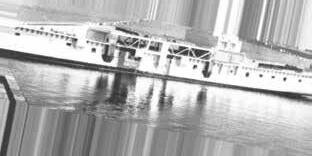







By Rachael Kvapil
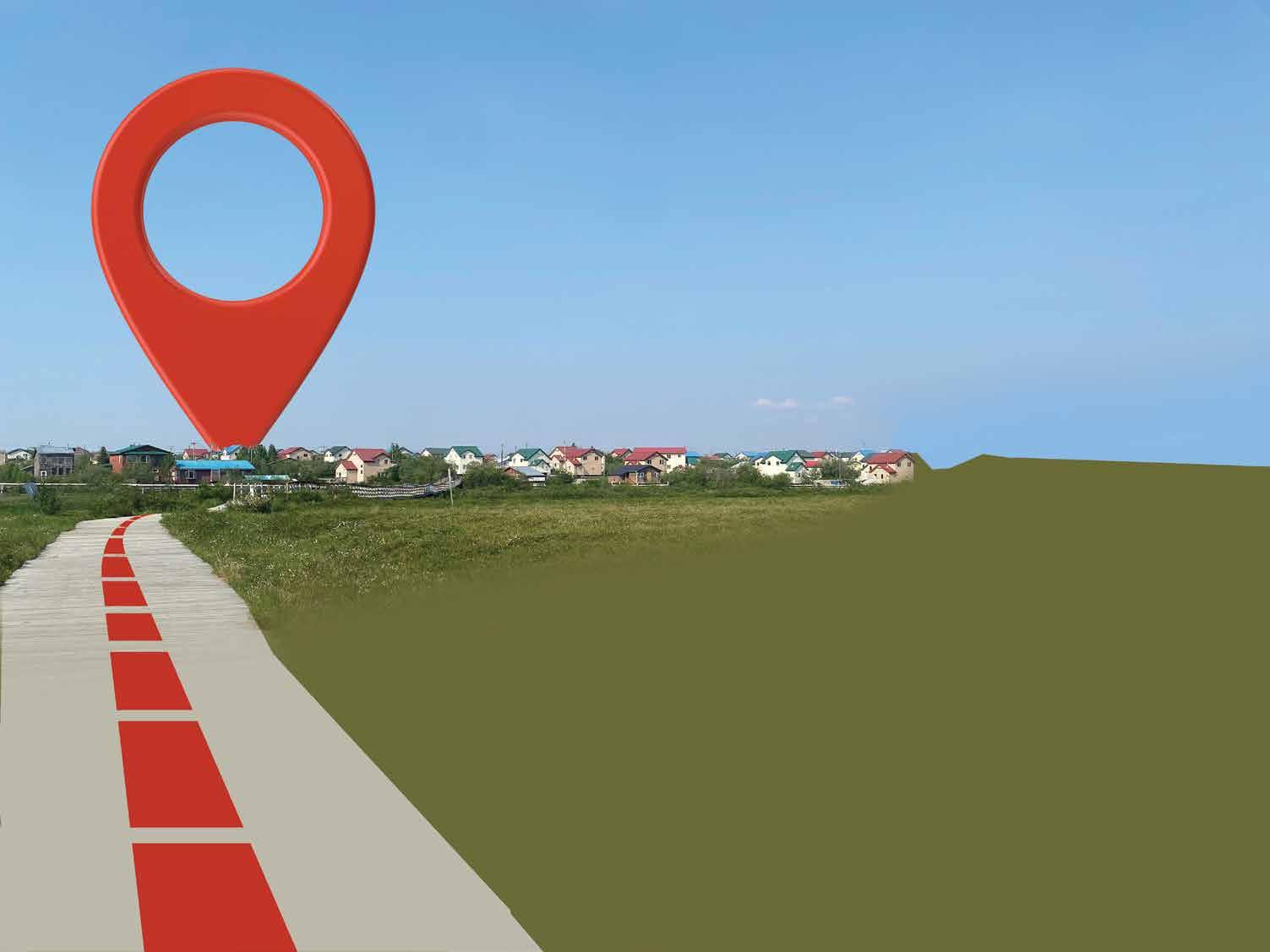
If someone asks for the address of a specific location, how quickly would it come to mind—without the help of an internet search?
Descriptive terms like “by the local store” or other narrative is common practice, but they aren’t compatible with delivery tracking. Official addresses are a necessity for modern living, yet many rural communities in Alaska have gotten by with informal systems. Lately they are discovering how essential addresses are to the local economy and are working to establish them on official platforms.
Toksook Bay is no stranger to achieving milestones. It was the first city counted in the 2020 Census, and now it’s the first YukonKuskokwim Delta community in the US government’s National Address Database. Until street addresses arrived in February, the village of 638 simply dealt ad hoc with the difficulties associated with ecommerce, government, and finance. However, once the federal government pushed for REAL IDs, city officials started the processes to standardize building locations.
“We recognized the barriers created by the lack of physical addresses for residents trying to obtain REAL IDS, apply for government assistance, or access a lot of modernized services,” says Toksook Bay Mayor Sam Chanar.
To Chanar’s surprise, obtaining

addresses was a local responsibility and not that of the US Post Office, as one might imagine. Toksook Bay looked into using maps from the Alaska Department of Natural Resources but determined it wasn’t the right fit. In 2022, Toksook Bay partnered with the Coastal Villages Region Fund’s (CVRF) Geographic Information System (GIS) initiative team and the Alaska Map Company to develop a comprehensive set of local geographic data.
Besides REAL IDs, Chanar says other recent events emphasized the need for official addresses. In addition to providing residents with better access to ecommerce, they ensure accurate census counting and make it easier for eligible voters to register. Also, street addresses eliminate unnecessary barriers to emergency services and, www.akbizmag.com

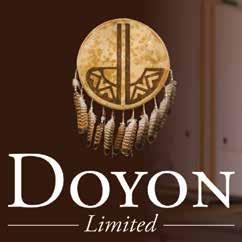

Operating more than a dozen for-profit companies, Doyon, Limited


















in the aftermath of an emergency, applying for relief aid.
“Many people couldn't get aid after Typhoon Merbok [in 2022] because they couldn't complete online applications that required formal addresses,” says Chanar.
Chanar adds that street addresses will further impact the local economy since they enable businesses to establish formal locations recognized by financial institutions and regulatory agencies. This will make it easier for businesses to open bank accounts, secure loans, and register with verifiable addresses. Likewise, entrepreneurs can now register businesses properly, apply for loans or grants, and ship and receive products via online ordering. Additionally, home-based businesses can establish more legitimate

presences. He says this foundational infrastructure makes it possible to participate in the modern economy in ways that weren't feasible before.
“Having street addresses will absolutely influence small businesses and entrepreneurs,” says Chanar. “The simple act of having an address removes one of the barriers that has historically made business development challenging in remote Alaskan communities.”
The reaction to this change has been positive, says Chanar. Toksook Bay sent household surveys providing assigned physical addresses to determine the number of residents without REAL IDs. The response rate was higher compared to the last time, with more coming in. The survey data will help Toksook Bay inform the Alaska Division of Motor Vehicles about the estimated number of residents who still need to get REAL IDs.

From Data to Digital Assigning addresses to 638 residents and additional businesses might seem like a quick and easy task. However, governments worldwide are becoming increasingly digitized, including the US government and the State of Alaska. If local government doesn’t adopt data standards that fit in a larger schema, residents could have a tough time accessing the benefits they used to be able to get without an address. Though residents have found ways to access many of these services without official street addresses, these workarounds have led to what’s called “drag.” Without an official street address, many ecommerce




and government activities become unnecessarily difficult, to the point that many people don’t realistically have the time and energy to navigate the process of getting what they need.
“I’m not going to say it’s impossible, but it definitely gets harder,” says Nathaniel Betz, director of community programs and GIS initiative project manager at CVRF. “We saw that with people trying to access individual assistance from FEMA [Federal Emergency Management Agency] after Typhoon Merbok.”
One of the challenges with meeting data standards was experience. CVRF saw a need for more geospatial data in the communities it serves but didn’t want to rely on an outside entity to come in, do the work, and leave a timestamped dataset that would get old fast. Instead, CVRF identified a
team of data practitioners already on staff in member communities. CVRF helped facilitate training this group on the GIS platform.
Eventually, CVRF partnered with Alaska Map Company, relying on founder Gary Greenberg’s decades of experience in Alaska land management. In talking with leaders in Toksook Bay, CVRF found a lot of forward-thinking leadership and interest in data-based governance.
When those goals dovetailed with Toksook Bay’s need for official street addresses, CVRF partnered to build a community-scale GIS, which became its first full implementation.
“Anyone can make up an address name,” says Betz. “That’s not hard. Most people who have lived in rural Alaska have probably done it at one point in their lives. For most of Alaska’s
post-statehood history, this has worked just fine. Many people might not immediately recognize the value unless they are in government and understand how much it helps to have official addresses.”
CVRF used the Esri ArcGIS Pro platform from the Environmental Systems Research Institute to build a dataset, followed by a web-based ArcGIS Hub software to share a public-facing version of the mapping products. The Hub provided a userfriendly way to interact with data and an intuitive interface that made it easy for land managers and government officials to work without becoming experts in a new software package.
Without GIS, Betz says this project would have been much more challenging. Paper mapping would be unwieldy, hard to update, and
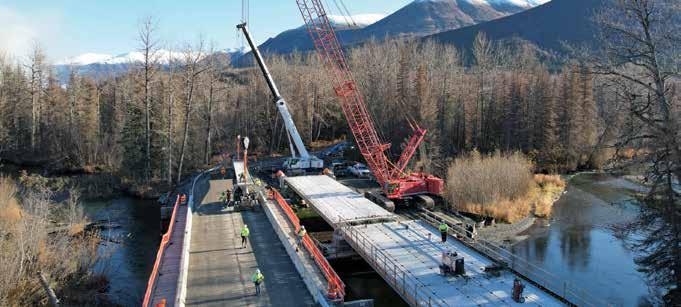

difficult to integrate with systems like the National Address Database. GIS allows users to visualize data layers, perform spatial analysis, and maintain comprehensive records. Most importantly, it makes the information easier to access through a user-friendly system, ensuring it can be updated and remain relevant for many years to come.
Betz credits Alaska Map Company with helping CVRF realize that developing a community GIS is a multistep process, with addressing pretty far down the line. The GIS initiative began in 2021 with the baseline mapping dataset, including all twenty CVRF villages, as its first big project. Toksook Bay was the first to be mapped, but CVRF needed to generate a lot of data before jumping into the address project. It took a couple of years to cultivate the parcel and land dataset across the region, which served as the context for the addressing process. Once that was complete, the Toksook Bay addressing project gained momentum in 2024.
To create the addresses, CVRF started with twenty-year-old community maps provided by the Alaska Division of Community and Regional Affairs as the foundation and developed property boundaries as an initial base layer. The GIS team had to add new data to reflect developments over the last couple of decades; however, once that was complete, they had the data tools necessary to start collaborating with member communities on the addressing project.
“The Alaska Map Company provided decades of experience and expertise, guiding us every step of the way,” says Betz. “The unique thing about the company is that it shares our commitment to building a truly community-based team that can create work products infused with essential local knowledge. Our work together has set our GIS team up to lead the addressing process on a highly self-driven basis in our other member communities.”
Betz also credits lead GIS technician Roderick Atti, who lives and works in Toksook Bay. He says Atti’s home base made it easy for him to work directly with local leadership. Collaboration and a great relationship with the community allowed the GIS team to move forward quickly and make addressing a reality.
Toksook Bay’s new official addresses follow National Emergency Number Association standards, linking to plats, deeds, and easements. The data is organized so that, with one click, anyone can verify the accuracy of CVRF’s work and access the source documents. Betz says the fundamental principles used to create addresses follow standards used throughout the country, but their implementation is uniquely adapted to remote Alaska villages.
Eighteen CVRF member communities are smaller than 1,000 people and are organized differently than traditional urban layouts with established grids. GIS teams needed greater flexibility to complete the process for remote communities. This meant revising best practices for municipal land management crafted with more
urban communities in mind, so they reflected a distinctive approach that emphasized local sustainability and ownership and helped communities maintain their own systems longterm rather than relying on outside experts with different views of land management needs.
At a high level, Betz says an addressing system is a building block that helps local, state, and federal governments provide effective service to their constituents. Now that these addresses are in place, governments have new tools and are better positioned to serve their people, but that doesn’t mean access will materialize overnight. Currently, signs with address numbers are being made through CVRF’s Youth to Work program. The signs will be delivered to residential and business buildings receiving addresses by the end of July 2025.
“No one person could overcome these challenges on their own,” says Betz. “We built an incredible team that brought together years and years of experience working on governance issues and technology in rural Alaska.”
Chanar agrees that partnerships with experienced organizations like CVRF and Alaska Map Company are crucial. Together, they engaged with the community of Toksook Bay through outreach to educate residents and build support.
“This process took time, but the long-term benefits are absolutely worth it,” says Chanar. “Other rural communities can accomplish what we accomplished. It’s achievable.”



In Alaska, startups and entrepreneurs turn to ecommerce to overcome the state's geographical challenges and broaden their market reach. By setting up shops online, businesses can connect with customers across the state and beyond, breaking through traditional barriers, according to Carlos Machuca, director of the AI Resource Program at the Alaska Small Business Development Center (SBDC).
“This digital approach allows them to diversify their income, cut down on the costs of maintaining physical stores, and offer their products and services around the clock,” he says. “Embracing digital platforms
By Tracy Barbour
not only boosts competitiveness but also strengthens the state's economic resilience.”
When it comes to entrepreneurs leveraging ecommerce, the Alaska SBDC recommends starting small and scaling over time. Businesses do not need a vast inventory or complex website to begin; instead, they should focus on presenting a few key products and a simple, userfriendly platform, Machuca says. “As the business gains traction, it can expand its offerings and site's features,” he explains.
This approach reflects the ecommerce journey of enterprises like Voyij, Wild Alaskan Company, Salmon Sisters, and HotGlaa doing
business as Trickster Company. These businesses have capitalized on resources from the Alaska SBDC, BuyAlaska, Juneau Economic Development Council, Alaska Fisheries Development Foundation, Spruce Root, and many others to establish a viable ecommerce presence and thrive in the digital marketplace.
Ecommerce is the mainstay of Voyij.com (pronounced “voyage”), which Olivia and Greg Klupar founded in 2019 in Skagway. The siblings, who were born and raised in Skagway and had grown up in various family
businesses that cater to the cruise industry, recognized a unique opportunity. “We knew travelers who visited our community were searching the internet for information about Alaska and that the best information wasn’t always available or easy to find,” Olivia Klupar explains. “More importantly, it wasn’t easy to stay connected to Alaska or shop from local businesses, especially before or after vacation. Businesses were leaving money on the table.”
Thus, the Klupars set out to build what woul d eventually become Voyij.com. Their community-focused ecommerce platform aims to support local businesses and help travelers connect with and purchase the best tours and gifts Alaska has to offer, all sourced and fulfilled by locals. Klupar says, “Through trial and error, we landed on the solution of an ecommerce marketplace—not just for our family businesses but for all Alaskan businesses—a ‘one-stop-shop’ website where travelers can browse and discover over 20,000 Alaskan items, including fresh seafood; Native art, apparel, and jewelry; and experiences, from dog mushing, northern lights, salmon fishing, whale watching, and much more.”
For Trickster Company, ecommerce provides a direct gateway for promoting its Indigenous-themed products. With a warehouse in Anchorage and design studios in Juneau, the company uses ecommerce to sell products on its website, interact with the community through social media, and develop relationships with other businesses.
Founders Rico and Crystal Worl began building the brand in 2011 as
“Embracing digital platforms not only boosts competitiveness but also strengthens the state's economic resilience.”


a brick-and-mortar venture. Years later, the siblings shifted their efforts strictly online due to the COVID-19 pandemic. But the original vision for the company remains.
“Our niche market was identified by the obvious demand for Nativedesigned items and contrasted by the quantity of cheesy knock off items in gift shops. We decided to provide for that marketplace, but with authenticity,” Rico Worl explains.
“We created products that meet the interest in Alaska and Alaska Native art and culture. Many people who have visited, lived in, or grew up in Alaska have connections they hold precious and want to remember or celebrate. We are there to support those celebrations authentically.”
Trickster Company initially started with hand painting skateboards but quickly saw the demand for Indigenous-designed items. To make the products more accessible, they began having the skateboards manufactured.
“Over time, we have continuously added more products,” Worl says.
“From skateboards, we moved
into playing cards, basketballs, apparel, and much more.”
Their successful ecommerce business now operates with the help of many family members, including their parents—Dawn Yolkol Dinwoodie and Rod Worl—who oversee the Anchorage facility. The company now ships its distinctive products to retail shoppers and wholesale buyers worldwide.
Ecommerce is also vital to Wild Alaskan Company, a direct-toconsumer seafood membership service that ships sustainable, wild-caught Alaska seafood to the doorsteps of consumers in all fifty states. The company, founded by Arron Kallenberg in 2017, shipped its first box of fish in February 2018. In 2023, it began to vertically integrate with the acquisition of Home Port Seafoods, a custom seafood processor in Bellingham, Washington.
Kallenberg, the son and grandson of commercial fishermen, often refers to his business as a “three-generation overnight success.”
Despite being born into a commercial fishing family, Kallenberg

says he was a “nerdy kid” who loved to tinker with computers. “I would bring my laptop out to sea and even rigged up a very slow internet connection on our boat in Bristol Bay in the late ‘90s,” he recalls. “Growing up, my dad and I would often talk about how the internet would eventually revolutionize the ability of fishermen to build and access direct markets. So in 2017, after spending nearly two decades working in the tech industry, I took a leap of faith, combining my two passions—seafood and tech—to launch the Wild Alaskan Company.”
Emma Privat also grew up commercial fishing. In 2012, she and her sister, Claire Neaton—both raised on a homestead in the Aleutian Islands—founded Homer-based Salmon Sisters. An online platform was integral to the company’s inception. “We started our business using ecommerce because we didn't yet have a physical storefront established and used social media to gain visibility,” Privat says.
Today the sisters fish together in the Aleutian Islands, Copper River Delta, Prince William Sound, and
Bristol Bay, along with their families.
In addition to selling wild Alaska seafood, Salmon Sisters offers gear and apparel for fishing and the outdoors as well as branded specialty goods, artwork, and gifts from Alaska.
“As women in the industry, we wanted to use our creativity and business knowledge to offer clothing and art to our female peers who were also working on the water,” Privat says.
“There wasn't much out there tailored for women in the commercial fishing industry or that represented or celebrated the work we were doing.”
Before they had a warehouse, inventory systems, and a year-round team in place to help with fulfillment, the sisters quickly learned that they would need space and assistance with shipping—especially with their seasonal work as fishermen on the
water. “We had to invest in space for our inventory and hire reliable workers who could step in when we were out at sea and get orders out reliably,” Privat says. “We tried many different shipping methods and different web platforms (Etsy, Big Cartel, Shopify, et cetera) until we were happy with our website experience.”
Although Salmon Sisters has been successfully marketing and shipping wild Alaska seafood (frozen) to customers around the country through its ecommerce site, the company has learned its share of lessons over the years.
For one, seafood is a perishable, high-value product that requires substantial customer education
and logistical expertise. “It's a difficult product to sell online, but we've enjoyed watching the program grow,” says Privat, the company’s creative director.
Salmon Sisters is proud to supply customers nationwide with frozen wild Alaska seafood. The business, which operates brick-and-mortar shops in Homer, has been able to amplify its reach beyond the state and bring more awareness to Alaska seafood by having a web presence where it can offer everything from seafood to cookbooks to art. “Our business supports our families yearround and a small team of young Alaskans who work with us through the seasons in Homer,” Privat says.
For Voyij, a major initial challenge was figuring out how to build a “retail mall for travel,” something Klupar


says had never been done before. Ultimately, the Klupars customized a solution based on what worked and what didn’t work for customers.
“With several years under our belt now, we know the insights that have influenced how Voyij works today are providing invaluable exposure and connections to customers and to our business community, which would never have been possible through any other means,” Klupar says.
Klupar says Voyij achieves success each time a business makes a sale, especially the first sale, through its platform. “When that first order comes through with the customer details and items purchased, it’s a priceless feeling,” she says.
According to Klupar, Voyij.com currently represents more than 300 local businesses from more than fifty communities across Alaska and growing. Thirty percent of its business community is mom-and-
pop small businesses or artists who have never used ecommerce before, and 20 percent are Alaska Native artists—many who live in remote communities away from the main tourist hubs (often with limited cellphone service, no bank accounts, and “iffy” US postal service). There is no cost to join the Voyij.com platform, and it offers free training and help with product onboarding to ensure every business is successful.
“We have surpassed $1 million in sales through Voyij.com, with all proceeds going directly into the pockets of local businesses,” Klupar says. “These online orders expand the economic pie for everyone, support Alaska’s economy, and help keep our communities vibrant and strong.”
At Trickster Company, manufacturing has been a significant issue to overcome. That’s why ecommerce was critical for the
small startup. “Though we do some small-scale manufacturing in our warehouse in Anchorage, some things just cannot be produced locally,” Worl says. “Very few US manufacturers like to work with small businesses, so ecommerce allowed us to build connections with manufacturers in China and Canada. This allowed us to find companies with reasonable MOQ's [minimum order quantities] and high-quality products.”
Social media is helping Trickster Company stay close to its community and customers, but there is always a disconnect when products are shipped off instead of handed to customers. Consequently, each time Worl sees people engaging with or wearing the company’s products, it’s a visible sign of success. “I always tell people that my biggest feelings of success is in moments when I may be driving around while visiting another city and I happen to see a kid walking down the street bouncing a Trickster Co. basketball or when I see inspirational leaders like [former US Secretary of the Interior] Deb Haaland wearing earrings we've made,” he says.
One of the biggest difficulties Wild Alaskan Company faced in the early days, according to Kallenberg, was establishing a fulfillment network capable of cost-effectively servicing the entire country. “Seafood weighs a lot and needs to be shipped with dry ice, which further increases the weight of the shipment,” he says. “The further you are from the customer, the lower your margins.” This problem was significant for a company he describes as a data-
driven marketing and tech-enabled logistics business that just happens to sell frozen seafood.
In the very beginning, Wild Alaskan Company shipped from a single warehouse in Wisconsin. It wasn't until it expanded to multiple warehouses across the country and began using multiple regional carriers that it realized the margins required to truly scale the business. Over time, the company created a suite of proprietary logistics software that helps it cost-effectively manage this fulfillment network. “We've applied a similar amount of rigor to our proprietary ecommerce platform and data-driven marketing initiatives, which has allowed us to weather multiple storms in the ever-evolving online advertising landscape,” Kallenberg says.
As a significant milestone, Wild Alaskan Company reached 100,000 active subscribers with its seafood membership service several years ago. Kallenberg credits this success primarily to the effectiveness of the company’s social media advertising— more generally, to its data-driven marketing strategies—and to efficiencies implemented in its supply chain. “Of course, the quality of our product and the incredibly talented team at Wild Alaskan Company also played vital roles,” he says.
With the rise of AI-driven tools, the future of ecommerce is poised for significant transformation, Machuca says. To stay ahead, businesses should consider proactive strategies. These strategies include embracing AI to offer personalized www.akbizmag.com




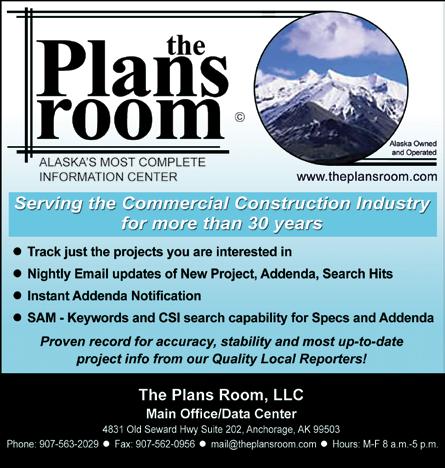

shopping experiences, automate customer service with chatbots, and improve inventory management; employing social commerce by enabling purchases on social media platforms; developing omnichannel strategies to create an integrated shopping experience across online stores, mobile apps, and physical locations; adopting sustainable practices like eco-friendly packaging and transparent supply chains; and optimizing their ecommerce platform for mobile and voice search.
“By adopting these strategies and utilizing resources like the Alaska SBDC's AI Resource Program, businesses can navigate the evolving ecommerce landscape and stay competitive,” Machuca says.
Trickster Company continuously adapts its digital marketing strategies on TikTok and Instagram
to stay authentic and engaged with followers. It partners with various communities and influencers to share art and stories with new consumer groups and find overlapping interest. “Industry evolves and changes, but engaging the community—from in person to online, being authentic, making real connections, and appreciating their stories—will never fall out of fashion,” Worl says.
Privat considers ecommerce a necessary component of the modern small business. While Salmon Sisters’ brick-and-mortar location offers a tactile, authentic experience, complementing it with an ecommerce platform brings the accessibility needed to reach a wider customer base. “This two-pronged model has served us well to grow and connect with our audience,” she says. “We are eager to keep both sides of the
business alive and well because both are such important parts of a brand experience.”
Voyij customers are looking for products or services that meet their shopping preferences based on price, convenience, delivery method, and other factors. Therefore, Klupar says, “The more we can be where our customers already are, the more likely we can earn the trust needed to build a lasting connection (and be a place they trust to spend their hard-earned dollars).” She believes ecommerce solutions that balance hyper-personalization but still offer choice will stand out as winners as the world becomes more interconnected and fast-paced.
From Kallenberg’s perspective, ecommerce presence has never been easier to establish—which is both good and bad. On one hand, businesses no longer need to build everything from scratch; turnkey services like Shopify and dropshipping platforms simplify operating an online store. On the other hand, lower barriers to entry have increased competition. “Therefore, focusing on business fundamentals is more important than ever,” he says. “Ensuring that you are adequately capitalized, effectively managing your costs, cash flow, and cash conversion cycle, and remaining diligently focused on customer retention (e.g., driving repeat purchases) are critical for survival and growth. Furthermore, investing in building a strong, unique brand, authentic storytelling, and exceptional customer service can help you stand out in an increasingly crowded and competitive marketplace.”

By Andrea N. Canfield
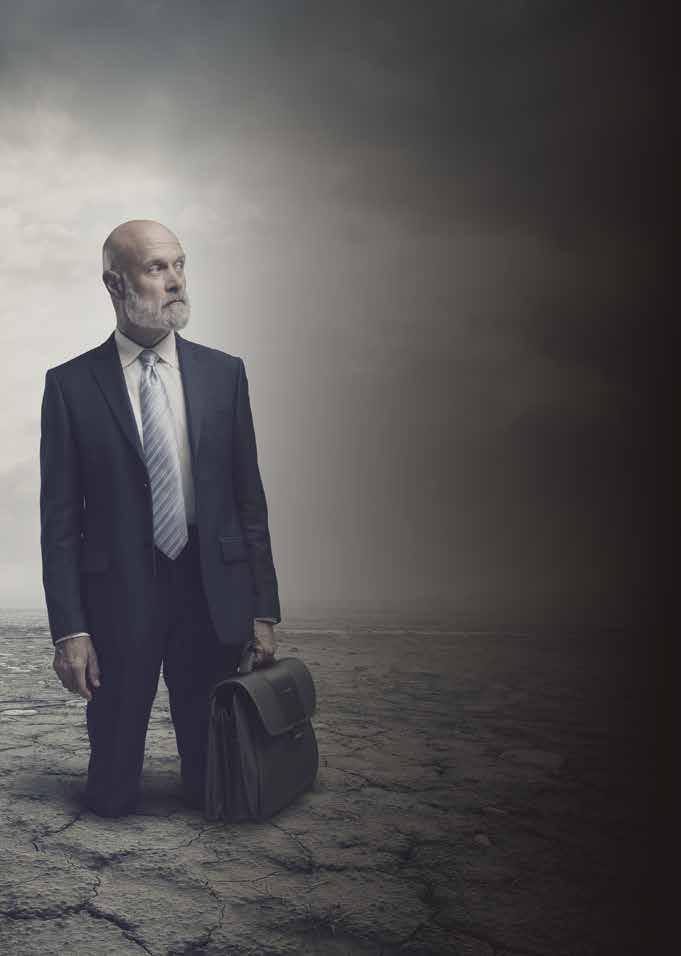
Imagine that you have just walked out of a grocery store. After braving steady wind, narrow aisles, and long lines, you successfully purchased a dozen organic, brown eggs. Despite the colorful package and the many labels confirming that you have made the “right” choice, you quickly realize that you are $10.99 poorer. Buyer’s remorse, or that feeling of regret after a purchase is made, has already started to set in.
While buyer’s remorse can manifest under many different circumstances, the cause is often the same: a disconnect between the expected outcome and the actual outcome of a purchase. This is especially true in mergers and acquisitions (M&A). Consider a failed merger or acquisition: up to 75 percent of all corporate mergers and acquisitions fail. A failed merger or acquisition occurs when 1) an M&A deal does not close or 2) an M&A deal closes but fails to deliver anticipated results. Buyers who experience the latter are often thought of as having buyer’s remorse.
This article will help buyers avoid remorse by examining why most mergers and acquisitions fail and how that failure can be prevented.
In 2024, global M&A volume reached $3.4 trillion, which is 15 percent greater than the volume in 2023. Generally speaking, the M&A market saw a shift toward fewer but higher-value deals in 2024, with corporate mergers dominating the landscape.
Because M&A allows a business to gain faster access to resources, growth, and innovation, it is reasonable to say that M&A is integral to every industry in every economy. Unfortunately, a merger or acquisition can fail for a number of reasons.


and personal attention like no other.



Once you ignore the outliers, or those M&A deals that fail due to a declining industry (such as the 1968 merger of the New York Central Railroad and Pennsylvania Railroad, which resulted in the surviving corporation, Penn Central, filing for bankruptcy just two years later) or those M&A deals that fail due to economic upheaval (such as the 2001 megamerger of America Online and Time Warner, which resulted in the largest annual net loss reported of $99 billion after the dot-com bubble burst), it is easy to spot a pattern. Simply put, most M&A failures can be attributed to the lack of attention given to integration.
Admittedly, integration is the least attractive component of the





M&A process. Think of integration as the equivalent to unloading your eggs once you arrive back from the grocery store or making sure that none of the eggs cracked on the ride home. Even after you have gone through the painstaking process to ensure that you have chosen the “right” eggs for the “right” price, integration requires you to walk through your weekly menu and re-confirm that you will use every single egg that you purchased.
Integration is tedious but critical to a successful M&A deal, as it will determine if a buyer’s anticipated results can be reached. What does integration look like in the M&A context? M&A integration involves the blending of two or more companies into one. It is
the process of repurposing the operations, systems, culture, policies, and procedures of the target business to perform and operate as a function of the buyer. While the actual integration process happens after a M&A deal closes, integration issues and solutions are identifie d well before then.
Integration issues are generally categorized as either “hard issues” or “soft issues.” Hard integration issues are those tangible issues that can be quantified, such as financial and operational performance or legal compliance. Soft integration issues are those intangible issues that are difficult to quantify, such as culture, communication, leadership, and organizational structure. Without assigning equal importance to both the hard and soft issues
of integration, a buyer will not accomplish a s uccessful M&A deal.
To illustrate, consider two common M&A integration issues: unexpected operating expenses a nd talent retention.
Unexpected operating expenses is a hard integration issue that is easy to quantify and therefore easy to identify. Some buyers will attribute surprise operating expenses to the inevitable costs of buying a business. However, that is not always the case. For instance, buyers who are interested in a merger or acquisition of a seasonal Alaska business typically account for fluctuations in workforce, demand, materials, and equipment. After all, Alaska’s economy is highly

EEarlier this year, I attended a publisher’s conference in Florida with my business partner, Jason Martin. The hot topic was, not surprisingly, artificial intelligence (AI) and its growing role in the publishing industry. Tools like AdCreative.ai and Jasper can generate ad copy quickly, and Grammarly is there to help us “word better.” And it goes much deeper from there. From streamlining business operations to content creation, AI is transforming workflows, and empowering businesses to work smarter, allowing teams to focus on more strategic and creative tasks
While 43 percent of publishers nationwide use AI for spell-checking and grammar correction, others increasingly use it to optimize resources, enhance customer experiences, and improve data analytics. Although the trend is intriguing, don’t expect AI-generated features in Alaska Business magazine. We’re sticking to original journalism and fresh content that AI can’t mimic—even if it tries.
On the design side, we’re using generative AI tools to assist with photo shoot concepts or to test composition and color ideas quickly. We stick with Adobe Creative Suite, while others swear by Canva Pro to speed up visuals. But let’s be real—AI cannot match the mysterious magic human designers conjure up.
AI is also making waves for business in general. For Alaskan entrepreneurs, the Alaska Small Business AI Resource Program offers fantastic support for integrating AI into daily operations. Whether you’re streamlining billing
or improving communication, AI boosts efficiency—so you can get back to doing what you do best, like avoiding spreadsheets or perfecting your afternoon meditation.
AI is phasing out of being a trend and becoming a business necessity. These changes excite (and maybe even scare) us, as they’ll transform how we do business, much like computers did when they first became mainstream. At Alaska Business Publishing Co., we’re embracing these changes, positioning ourselves to stay competitive and grow, all while staying personally connected to Alaska’s business community.

Charles Bell Vice President of Sales & Marketing 907-230-8213 | cbell@akbizmag.com
seasonal, with many industries such as tourism, construction, fisheries, and agriculture all experiencing a significant lull in operations in the winter months. That said, the ability for seasonal businesses to operate lean during off-peak seasons may not be feasible after closing, which may result in unexpected operating expenses for the business going forward.
Similarly, consider buyers who are interested in a merger or acquisition of an Alaska small business. As we know, Alaska has a vibrant small business community, with nearly 75,000 small businesses operating in the state. One key (albeit obvious) characteristic of small businesses is their small number of employees. As a result, most small businesses do not have robust back-office
support, and that often impacts the businesses’ ability to know about and comply with applicable state and federal regulations. For buyers of small businesses in Alaska, that means a greater chance of unexpected operating expenses after closing due to regulatory penalties or legal fees.
While unexpected operating expenses are a common occurrence in M&A, they are not commonly considered as part of an integration strategy and therefore tend to decrease the probability of an acquired business reaching anticipated results after closing.
In contrast, talent retention is a soft integration issue that

often goes ignored. While most would consider the “talent” of a business to be its key employees or the president, CFO, or general manager, the success of a merger or acquisition often depends on a much broader pool of employees.
Consider the impact of employees on the economy. Notably, the world’s economy is dominated by the service sector. That fact is even more true in Alaska, with some of the largest contributors to Alaska’s gross domestic product coming from service industries. Given how crucial service is to the Alaska economy, it is clear that the most critical asset held by Alaska businesses is no longer their contracts, equipment, or facilities but their employees.
Unfortunately, employees are transitory. About 33 percent of







acquired employees leave within the first year of a merger or acquisition, and 75 percent of employees in key roles leave within three years of a merger or acquisition. Buyers typically discourage employee departures through retention bonuses or other negotiated compensation packages, but those methods do not always work and often do not provide enough motivation to employees to increase overall business performance. If acquired employees leave, or if they remain after closing but fail to be productive, the results of the merger or acquisition will suffer.
With an understanding that most mergers or acquisitions fail due to failed integration, how can buyers integrate a business successfully?
Some useful practices include:
• Allotting sufficient time for due diligence;
• Building a comprehensive due diligence team to identify both hard and soft integration issues;
• Developing an integration strategy based on the results of due diligence; and
• Allotting sufficient time for integration after closing.
Mergers and acquisitions have been a part of our economy since the 19th century. Since then, the M&A process has been refined and molded into what it is today, with more emphasis being placed on how buyers can achieve anticipated results through integration. Indeed, despite the attention typically given to other areas of the M&A process, many M&A experts believe that the ultimate success
of a merger or acquisition is dependent on integration.
To that end, buyers should only participate in a merger or acquisition if they intend to devote sufficient time and resources to integration. After all, a successful integration tends to lead to a successful merger or acquisition, and that is the ultimate way in which buyers can avoid buyer’s remorse.
Andrea N. Canfield is a corporate partner at Stoel Rives. She advises private companies, including large conglomerates, such as Alaska Native Corporations, in mergers, acquisitions, and other strategic corporate transactions. She can be contacted at andrea.canfield@stoel.com

Personnel Plus is the epitome of excellence in Alaska’s staffing and recruitment industry. Founded in 1989 by Cindy Schebler, the full-service employment agency has built a reputation for providing personalized service and fostering strong business relationships. Today, the legacy continues through her son, Mike Schebler—who started with the company in 1998 and took the reins in 2019—and his son, Dante' Schebler, a recent addition to the business.
Dante', officially serving as secretary of the corporation, handles payroll and accounting tasks as a payroll specialist bookkeeper. Schebler says working with his son “feels good,” and he looks forward to preparing him to take the helm. “Then I can semi retire, travel a bit more, and trust that my son can handle the business," he says.
However, the leadership transition will be gradual, spanning five to eight years. During that time, clients can expect the high-level service the agency has always delivered. “That's not going change because I'm going to instill that in Dante' and ensure he carries it on,” Schebler reassures. “I probably won't completely step away for at least ten years, and I'm always going to be a consultant for Personnel Plus.”
Personnel Plus operates offices in Anchorage and Fairbanks, providing effective staffing solutions for businesses statewide. With a team of eight employees, the agency generated 350 W-2s for its temporary and leasing clients last year. It offers four main services: permanent placement, temporary placement, temporary-to-permanent placement, and employee leasing. These options are all designed to significantly streamline the hiring process and enhance operations for clients.
For instance, with permanent placement, Personnel Plus provides recruiting, testing, screening, and reference checking to find the most qualified applicants. Through temporary placement, it takes full responsibility for employee tax and workers’ compensation, billing clients hourly based on the position. Temporaryto-permanent placement offers employers a try-beforethey-buy opportunity. And employee leasing creates a seamless solution for clients wanting to minimize the complexities of payroll and related administrative tasks while retaining control over employees’ daily work activities.
Recently, Personnel Plus made a significant enhancement to its services. The company expanded its capabilities to handle Davis-Bacon Act wages

by
and certified payroll. “Clients don’t have to worry about doing the certified payroll and filling out all the forms that go along with it, saving them a lot of time,” Schebler says.
Personnel Plus prioritizes having the correct people in the correct positions within the company. Additionally, it prides itself on taking a personalized approach to doing business. This entails completing personal interviews with job candidates and cultivating close relationships with employers.
“We keep the personal in personnel and really get to know our applicants and clients,” Schebler explains.
For the future, Personnel Plus will continue doing what it does best: serving Alaskans with excellence. Schebler emphasizes, “We’re not a cookie-cutter, head-hunting staffing agency; we offer a personal touch.”
This philosophy, combined with the Schebler family’s enduring dedication, helps ensure the agency will continue to thrive and serve Alaskans for years to come. Mike Schebler, President Anchorage Office (907) 563-7587 1500 W. 33rd Ave., Ste. 220 Anchorage, AK 99503 Fairbanks Office 3437 Airport Way, Fairbanks, AK 99709 (907) 452-7587

By Scott Rhode

Re d tape was supposed to streamline bureaucracy. The idiom is thought to originate from 16th century Spain, when King Charles V—also the Holy Roman Emperor and a pretty big deal, with a jawline to match—decreed that documents requiring immediate attention be bound with scarlet ribbons instead of plain string.
Nearly five hundred years later, “red tape” had become synonymous
with bureaucracy itself. In this magazine’s inaugural year, the April 1985 article “Battle of the (Red Tape) Bulge” by Southeast correspondent Chuck Kleeschulte quotes the Resource Development Council grumbling that regulatory agencies had too many ways to stall permits. A then-recent reform that required state reviews within thirty (or in some cases fifty) days meant, according to an ARCO Alaska executive, that agencies would use the entire timeframe for permits that used to be issued on a walk-in basis.
However, Kleeschulte reported that the US Army Corps of Engineers (USACE) had improved from taking 180 days on average to process a wetlands permit in 1981 to less than 60 days by 1985. Two months is still the target, forty years later. “We
certainly strive to have them done in 45 to 60 days,” explains Heather Markway, chief of the South Branch of USACE-Alaska District’s Regulatory Division. “We definitely have better timelines than some other areas of the country, but it really depends on the complexity of the permit.”
Complexity, unfortunately, can stretch a two-month turnaround into twelve when USACE must consult with other agencies. “Back then, permits were so much easier,” Markway says. “If you look at old decision documents, they weren’t doing the same amount of consulting and coordination with other agencies that we do now.”
Robin Reich, president of Solstice Alaska Consulting, tells clients to expect longer timelines. “Often a client will come to me and say, ‘I want
to build this project in two months.’ That's just not going to happen,” says Reich. “You have to plan your projects understanding that it will take you six months to a year to get your permits.”
The battle to streamline permitting wasn’t won in 1985, and it is still being fought today.
Reich observes, “Streamlining has been jargon since the ‘80s. It's been in everything, and I hear that word coming from industry a lot. I hear, ‘How can we streamline this process?’”
Kleeschulte heard the same in 1985. “For years, industry in Alaska has been complaining that it’s been buried in red tape,” he wrote. “But at last, industry officials say state government has acknowledged the

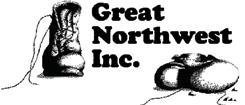
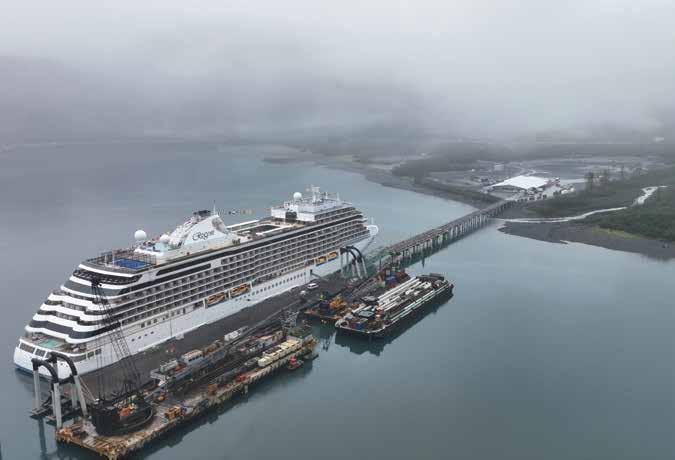
need for change and is taking steps to cure the malady.”
“At last” didn’t last forever. The red tape giveth, the red tape taketh away.
“Now we have to get an IHA, which is an incidental harassment authorization” under the Marine Mammal Protection Act of 1972, says Jason Davis, president of marine construction company Turnagain. “For really every marine project that gets built in Alaska, prior to about 2018, those were almost non-existent.”
The IHA is triggered every time Turnagain builds in the water because of noise that might disturb wildlife. Of course, IHA isn’t a state requirement, and it doesn’t even come from USACE directly. Markway says, “We have to comply with Section 7 of the Endangered Species Act, so
we’ll consult with National Marine Fisheries Service or US Fish and Wildlife Service. We have to comply with Section 106 of the National Historic Preservation Act [of 1966], so we’ll consult with local tribes or anyone with a potential cultural impact.” Those are in addition to USACE’s chief concerns: Section 404 of the Clean Water Act of 1972 and Section 10 of the Rivers and Harbors Act of 1899.
Another holdup is analysis and disclosure of impacts under the National Environmental Policy Act of 1970. Not a permit approval per se, but Reich notes that compliance can take a long time. It’s required for most federally funded projects, and sometimes multiple agencies funding a single project require their own submissions.
Depends on the scope. “If you’ve got a really large pipeline project or a really large mine project, you know, versus Joe building a dock: those are different levels of analysis,” Markway says. “We’re definitely good at streamlined nationwide permits for docks and pilings. We’re definitely pretty quick to turn those out, especially if it’s something simple.”
When permitting gets complicated, even large contractors like Turnagain hire specialists to shepherd the process. Davis says an inhouse project manager can track compliance, and civil engineers can handle building permits, but Solstice Alaska is better at environmental permits.
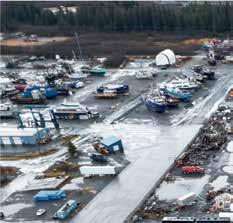
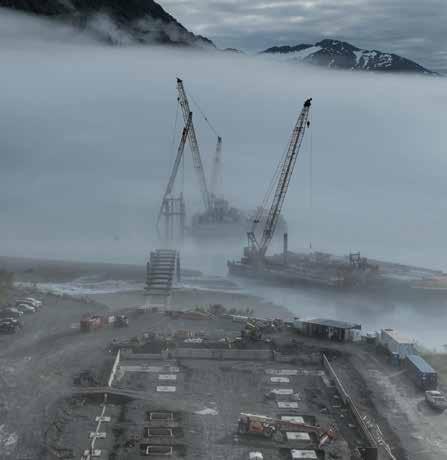



“We like working with them because they're smaller and nimble but big enough that they have all the right expertise,” Davis says. “Someone from my engineering staff or my construction staff speaks with Robin every day. We have, I think, seven or eight or nine projects that she's working on for us at different stages every month, so it's a constant element of our business.”
With a nine-member team, Reich says Solstice Alaska works on projects large and small. “We have recently been doing a lot of marinetype permitting, but we also permit roads, water, sewer systems in rural Alaska, buildings, and other things around the state,” Reich says. She adds that her firm doesn’t do North Slope or mining projects, where other









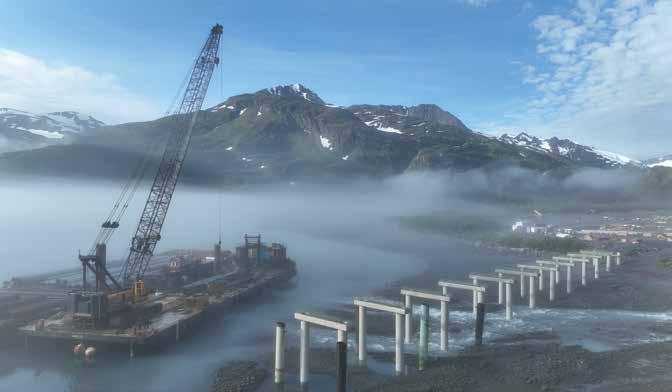
Reich says she “wanted to be Jacques Cousteau” and studied biology before getting into the consulting business, blending science and construction. “You have to keep up with the most recent science,” she says. “There's a lot of research that goes into determining impacts.”
The process typically begins with a detailed project description. Reich explains, “I need to understand how many piles are going in the water, how much fill is going in the water, how they plan to construct the project. I have to have a good understanding of the scope of work. And then we typically talk with the agencies; we have an agency meeting to introduce them to the project. Then we put together a project description which includes everything that's happening and the potential impacts.”
To determine those impacts, her team has knowledge based on experience, but they also bring in
outside experts. “If we need a wetland delineation done or if we need an archaeological survey done, we rely on subconsultants to do that work,” Reich says. “We don't do science in house. We take science and turn it into permit applications.”
The firm also helps to move permits through agencies’ statutory requirements, like public notices.
A correctly formatted permit application is rarely at risk of being denied. Davis says, “The plus side to permitting in Alaska is it's usually not a question of if a project can get built or if a permit will be issued. It really comes down to the time and the steps and the mitigation to make sure it's done properly.”
Since 1985, one major permitting hurdle has been streamlined into nonexistence. Reich recalls, “When I first started my career, you had to do a coastal project questionnaire and
go through that whole process. That's not around anymore. So I guess it's streamlining if it goes away.”
The Alaska Legislature voted against renewing Coastal Zone Management in 2011, the first eligible state to exit the program Congress established in 1972. Instead of the state leading permits in coastal waters, with an obligation to consider input from local communities, approvals are managed at the federal level.
Federal streamlining continues with USACE rolling out its Regulatory Request System (RRS) last year. Markway describes it as a dashboard, a “one-stop shop” with all relevant documentation attached, where applicants can track their permit status.
“They can see in real time what the project manager is putting in the database related to their project,” Markway says. “And you can use RRS to request a preapplication
consultation; you don’t have to know all the information on your project right away, but if you would like to set up a meeting with us to talk it through, you can do that with the RRS.”
Another step toward efficiency, she notes, is a partnership with US Fish and Wildlife Service for additional lidar data of remote Alaska topography. Markway says the laser scanning adds areas that previously were not in USACE’s wetlands inventory map. “We’re hoping that will increase our ability to do some of these reviews at our desks that normally we aren’t able to do as well without getting out in the field,” Markway says. “Having the best desktop information is very important,” especially for working year-round, when off-season remote visits are tough.
USACE is also trying to routinize common permit requests. Markway says, “We’ve recently set up a programmatic [with National Marine Fisheries Service] for certain sized piledriving activity in certain areas, and that has streamlined our consultation with them. We do regional general permits; we set up those for like activities.” She adds that the next programmatic setup could be for aquaculture sites.
But there’s only so much streamlining an agency can do. Markway remarks that USACE doesn’t have enough personnel to dedicate to faster turnaround times. Reich has noticed, too, that sometimes agencies don’t have enough staff to guarantee a timeline.


Our innovative solutions and experience in Alaska construction and maintenance are second to none. From the Kenai Peninsula to the farthest reaches of the North Slope, CONAM has been there and built that.






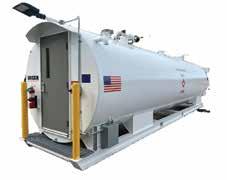




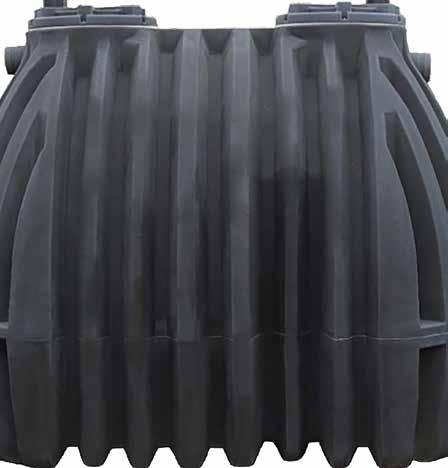
Davis gives permitting authorities credit for what they can accomplish. “The agencies do a good job of being responsive. We have good relationships with them,” he says. “While we might not like what they tell us the timeline is going to be, we have good luck with them hitting the timeline they tell us that they will hit. I don't want to vilify the agencies that are issuing the permits; I think that they work hard and they do a nice job.”
He does have suggestions for improvement, though. “Every project that we permit in the water is done as if it's the first time work's been done in the area,” Davis says. “It seems like we should be able to have some checklist or process to validate that information from previous studies is applicable.”
He gives the example of studying noise impacts on marine mammals at one site, only to do it again for the same population of animals for a site down the shoreline. “I'm not saying that those studies aren't important, and I'm not saying that all projects should be able to reuse previous studies, but it seems almost like the agencies should be able to have a study that's accepted for a region and the projects that are going to get built in that region should be able to use that database,” Davis says. “That would reduce work for the permitting agencies, and it would reduce our cost in replicating studies that are almost identical to previous studies.”
Davis adds that sometimes listing a new endangered species has repercussions that aren’t well understood, such as a proposed listing for sunflower sea stars.
“Having a diver available to go and swim the job site every morning to look for a species is extremely expensive,” he says, further noting the irony that divers may not move species to safer areas, only observe them to account for how many are harmed by the permitted activity. “Doesn't seem like that offers a lot of benefit to the species itself.”

Short of those changes, responsibility for streamlining shifts to applicants. Markway says, “Sometimes it takes a while for the applicant to get back to us with information, whether it’s gathering that information or going to other sources. It takes a while, and that can impact our timeline.”
With that in mind, Reich knows exactly how to streamline permits. “Number one: know what you want to do,” she says. “You can't be changing your mind. I have found that clients who don't understand the scope of work or haven't decided what they want to do—it's very hard for us to move forward.”
Reich’s second tip is to prioritize authorizations by lead time. “You want to apply first for your Corps
permit, then start working on your Endangered Species Act consultations and your incidental harassment authorization requests, then work on local permits that take less time,” she says.
Her third tip, echoing Markway, is to answer requests quickly. “Agencies don't have much staff, and they have too much workload,” Reich says. “So if you don't answer the question quickly, it's going to the bottom of the pile. They're not going to twiddle their thumbs waiting for you to answer the question.”
Reich’s fourth recommendation is to keep open lines of communication with agencies. “Be talking with them often. They're very open to having monthly meetings, I’ve found, or just talking to them on the phone. Plus, your project stays in front of them, so they're thinking about it more,” she says.
All four tips put the onus on companies to streamline, whereas the focus of Kleeschulte’s 1985 article was improving government responsiveness. Before he joined the magazine’s masthead in its inaugural year, Kleeschulte was press secretary for then-Governor Jay Hammond, and by the time he retired in 2018 he was a top aide to Senator Lisa Murkowski. From his point of view, there were too many federal, state, and local permit and license requirements, “everything from deepening an oil well to processing milk to filling in wetlands to operating a gas pump,” Kleeschulte wrote.
Kleeschulte added, “Industries largely accept the need for
government regulation to protect the health and safety of residents and the environment of the Last Frontier. But they don’t like the complexity of the regulatory process or what they perceive to be a tendency on the part of some agencies to add unrealistic requirements to project approvals and to procrastinate o n making decisions.”
If those permits went away, Reich says Solstice Alaska would stay busy with other consulting jobs, such as community planning and grant writing. But permit approvals are likely to remain p art of her business.
“We just don't say that permits are going to go away because [for that to happen] we'd have to say, okay, the Clean Water Act is going to go away; the Rivers and Harbors Act is going to go away; the Marine Mammal Protection Act is going to go away; the Endangered Species Act is going to go away; the National Historic Preservation Act is going to go away; the MagnusonStevens [Fishery Conservation and Management] Act is going to go away. There are so many of those different environmental laws that would [need to] go away,” Reich says.
While those laws remain, streamlining permits is a perpetual goal. “I don’t see why we wouldn’t want to streamline as much as possible,” Markway says. “As long as we’re thorough and we’re following all of our regulations… then there’s no reason why we wouldn’t want to strive for being as streamlined as possible.”




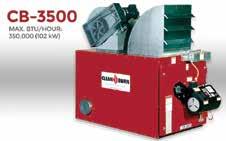



Th e Alaska construction industry accounts for about one in twenty jobs in the state, contributing about $2.5 billion in wages to our economy last year.
From roads and airports to schools, offices, grocery stores, and homes, we are surrounded by its output.
In Alaska, most businesses involved in construction are deemed “small” by the US Small Business Administration, employing fewer than 499 people. “Small Crews, Big Results” highlights the diligent work of three businesses with extra impact.
“Women at Work” highlights changes within the construction

industry, where more and more women are working as equipment operators, welders, engineers, project managers, and more.
Through the National Association of Women in Construction, women have the opportunity to learn about education and training opportunities, receive mentoring and support from other women in the industry, and ultimately change the industry.
“A Positive Outlook” looks at the roughly $6.7 billion in construction spending forecast for 2025, and “Anchorage Airport Infrastructure” focuses on the


latest capital improvements for cargo and passengers. And finally, “Tomorrow’s Technology Today” explores how residential construction and utility sectors work together to ensure homes are ready for cutting-edge gadgets.
The construction industry is often thought of in terms of machinery, materials, blueprints, and tools, but behind all of that are the innovators, collaborators, and problem solvers who bring our dreams to life. To the men and women who make it happen, we tip our hats.
The all-new CASE B Series skid steers and compact track loaders feature an all-new 8-inch LCD operator screen with backup camera; completely updated and simpli ed operator controls; even greater cab comfort; and while the machine looks the same on the outside, we’ve re-engineered its critical inner workings to stand up to what you and your jobsites face every day.
The all-new CASE B Series skid steers and compact track loaders feature an all-new 8-inch LCD operator screen with backup camera; completely updated and simpli ed operator controls; even greater cab comfort; and while the machine looks the same on the outside, we’ve re-engineered its critical inner workings to stand up to what you and your jobsites face every day.

2020 East Third Avenue
Anchorage, AK 99501
Fax:
Phone: 907-277-1541
Fax: 907-276-6795
Email: info@yukoneq.com
FAIRBANKS 3511 International Street
Wasilla, AK 99623
Fairbanks, AK 99701
Phone: 907-376-1541
Phone: 907-457-1541
Fax: 907-376-1557
Email: info@yukoneq.com
Fax: 907-457-1540
Email: info@yukoneq.com WASILLA
7857 West Parks Highway
Wasilla, AK 99623
Phone: 907-376-1541
www.yukoneq.com
Fax: 907-376-1557
Email: info@yukoneq.com
www.yukoneq.com
By Jamey Bradbury
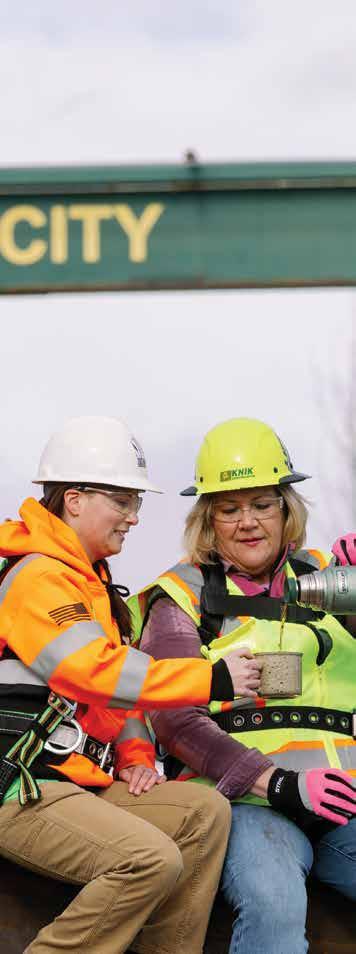
On the night of the Constructive Women Awards—the culminating event of Women in Construction (WIC) Week 2025—Tamie Taylor scanned the audience and saw transformation. Thirty-four years ago, when she landed a secretarial job with a construction company, Taylor rarely encountered other women in the industry, certainly not at work sites.
The audience at the awards ceremony, though, was composed of welders, superintendents, millwrights, electricians, engineers—women from nearly every sector of the construction industry.
“It’s the whole plethora from construction. Not only the trades but the people in the offices, the owners, the person who’s selling the equipment,” Taylor says.
The crowd that evening was representative of the work being done by the National Association of Women in Construction (NAWIC), which advocates for women in the construction industry by providing career growth opportunities, resources, and connectivity among its members nationwide.
Members of NAWIC’s Alaska chapter commonly refer to the organization as a “sisterhood.” Taylor—who previously served in multiple NAWIC leadership roles at the chapter and national levels, including national president—echoes this sentiment when she describes the local chapter’s focus.
“We want people to understand that construction is a viable career. Man, woman; first career, second career; whatever. We may be competitors when it comes to work, but we’re not competitors when it comes to NAWIC. We’re all united,” she says.
NAWIC’s efforts to encourage connections among women in the construction industry is evident to Randi DelReal, the Alaska chapter’s current president. While she’s still the only woman working in the field for STG Pacific, where she’s a quality control manager, she’s seeing more and more women working with STG Pacific’s sister companies and joining NAWIC.
“I’ve seen our chapter grow, and you meet more women [in the industry] every year,” she says. “There’s companies out there that really do support women. I can see things changing and women succeeding.”
More women working in construction is a mutually beneficial situation. Construction jobs are steady, pay well, and can be flexible, depending on the season and the position. And studies show that the industry benefits from having women on the job: a 2023 National Center for Construction Education and Research study found that women are more team-oriented on jobs and also more cautious with hazardous materials and machinery. Additionally, businesses that employ more women can be more competitive when bidding for some federal contracts, which offer preferences to women-owned businesses.
Taylor points to the difference she’s seen women make on the job: during one site visit, while inspecting welds, she noted how clean and concise a series of welds were.
“I asked, ‘Who did these?’ I wanted to have a contest and test all the welds and see how many passed, and [the male welder] said, ‘Nope, I’m not taking that on. Sydney will kick my butt every time,’” Taylor recalls with a laugh. “She’s good because she’s meticulous. I’m not saying men are not, but there is an advantage to having women in construction.”
Membership in NAWIC Alaska— which is open to any woman actively employed in or retired from the construction industry, including students and women supporting the construction industry—affords a variety of educational and networking opportunities—locally, regionally, and through national NAWIC. The Alaska chapter offers www.akbizmag.com

We don’t just settle on knowing your industry. We live it. Spotting trends and navigating turbulent waters can’t happen from behind a desk. The insights come when we put on our hard hats and meet our clients where they are.
monthly educational events plus more casual meetups.
WIC Week is a highlight of the association’s yearly schedule. Now in its twenty-eighth year, WIC Week celebrates and promotes women in the industry and features a week of networking and training events plus the Constructive Women Awards Banquet.
This year’s iteration of WIC Week featured Get Hired!, an event organized by the Alaska Safety Alliance. Hosted in both Fairbanks and Anchorage, Get Hired! featured dozens of industry employers looking to connect with both high school and professional jobseekers.
Taylor explains, “Not only are we hiring, but you’ve got people here willing to sit down, look at women’s résumés. ‘You’re having
trouble getting hired? Let’s see why.’ Where else are you going to find that for free?”
Other highlights included sessions on “The Unapologetic No,” “Sleep and Women’s Health and Safety,” and “Taco Tuesday,” which included a hands-on construction challenge.
One highlight of the week for Naomi DuCharme, executive director of the Alaska Safety Alliance and chair of WIC Week, included seeing a male senior leader at an energy firm bring his new female operations manager to one of the events.
“She had just moved to Alaska and was the only woman in her office,” DuCharme recalls. “[Her employer] recognized that, without support and connection, she might struggle or even leave the firm or Alaska
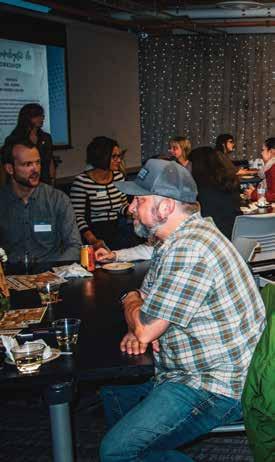

Spenard Builders Supply has been Alaska’s choice for building materials for over 70 years, supplying logistical solutions, manufacturing, truss design and build, millwork and interior design. Our team can provide the expertise needed to complete your project.




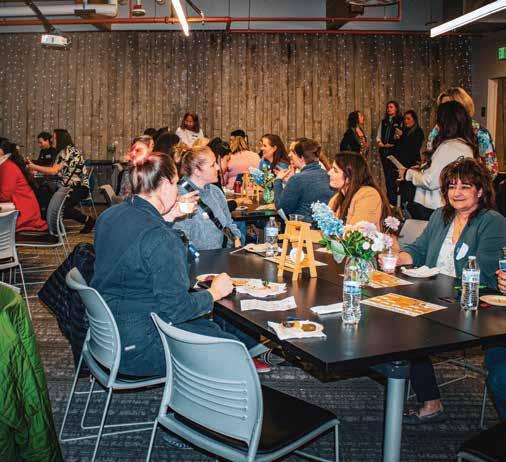
altogether. Instead, he took action— he made sure she had a space where she could feel seen and supported.”
She hopes that this kind of understanding and support of women in the industry extends beyond WIC Week—and beyond women in the industry. “I want to see companies take a deeper look at how they support underrepresented groups year-round,” she says.
The week culminated with the Constructive Women Awards Banquet. Seventeen female leaders in the industry were nominated by their peers, and a panel of independent former NAWIC officers and directors chose six winners. The 2025 Constructive Women Awards went to Brianna Carlson, project engineer/project manager with UIC Nappairit; Lindsay Ford,



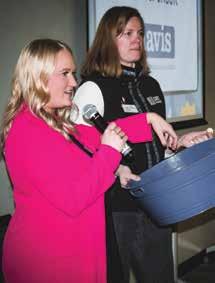
construction operations manager at Ahtna Diversified Holdings; Angela Kuykendall, project superintendent with HC Contractors out of Fairbanks; Suzanne McCarthy, director of Alaska Laborers Training School; Xuan Ta, a principal electrical engineer at RSA Engineering; and Darlene Ayapan, a journeyman electrician with Alaska Native Tribal Health Consortium.
For Maggy Desmond-Layral, WIC Week was an opportunity for growth. Based in Fairbanks, where she is the vice president for Western Mechanical, Inc., DesmondLayral is determined to get more Fairbanks women involved in NAWIC. At the time of this writing, there are about five local members of the organization.
When Desmond-Layral first joined NAWIC, she was the only Fairbanks member. She recalls popping in on what she thought was a monthly meeting for Alaska members, only to discover herself in a planning meeting for that year’s WIC Week. She quickly became a one-

woman committee for building up Fairbanks membership.
“It’s a big industry up here but a small community, and there’s a push right now with some companies in this area to increase the amount of women they’re hiring,” Desmond-Layral points out. “A lot of those gals have started joining NAWIC because their Anchorage counterparts are in it.”
NAWIC Alaska is a statewide chapter, but much of its work is focused in Anchorage. Thanks to online tools like Zoom, DesmondLayral has been able to host gettogethers for Fairbanks members to join Anchorage-based monthly meetings and activities. She hopes that, as the Fairbanks membership grows, she can organize in-person events.
“The goal is to call in for those monthly Anchorage meetings but then also do something fun as the Fairbanks group,” she says. “Or we could head down to Anchorage and get together with those members.”
She’s well on her way to meeting her goal, thanks to WIC Week’s Fairbanks-based events. At the local
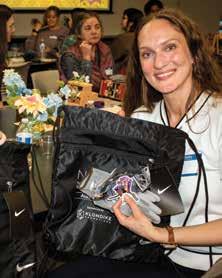
kickoff mixer, DuCharme notes, “I saw tradeswomen meeting each other for the first time—women who had worked on different projects, for different companies, who had no idea others like them were out there. They shared their struggles, their wins, and, most importantly, their support for each other.”
Isolation can be dangerous in the construction industry, she says, not just for women but for anyone. “That’s what this is all about— breaking isolation, whether literal or figurative,” she adds.
It’s a good first step toward Desmond-Layral’s other goal: “To be able to go out to a job site with my NAWIC sticker on my hard hat and see maybe four other stickers out there, too.”
Many of NAWIC’s efforts are aimed at encouraging young people and women to explore careers in the construction industry. Through monthly meetings and activities, NAWIC brings women—and men—together for professional development and networking.
The Alaska chapter also holds fundraising events, like its annual golf tournament, to fund scholarships for students enrolled in construction programs.
The most beloved event may be the annual Block Kids building competition. A national effort that’s sponsored at the local level, the program introduces children to the construction industry through a hands-on competition that challenges grade schoolers to build a structure using materials like building blocks, string, foil, rock, and construction paper.
“It’s fun to see the kids and what they come up with from their imagination,” says DelReal, who volunteers at the event. “What’s really cool is the ones who have parents in the industry, seeing them take what they hear from their parents and try to make it their own.”
Since stepping away from national leadership roles, Taylor has been able to engage more frequently with local schools and is passionate about encouraging young people to think about all the ways construction touches their lives.
“You get in the bus to go to school, so we talk about [how] there was a construction company that built those roads that you’re riding on,” she says. “Engineers designed the bridge you cross over. A construction company had to build the school. Construction is affecting your life, and you don’t even know it.”
NAWIC also offers a CAD drafting contest and a design-drafting program that asks students to devise a budget for a design-build project. It’s all part of planting a seed with www.akbizmag.com
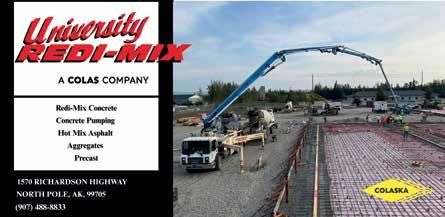



kids and young women to consider something unexpected.
“I want girls and women across Alaska to see a future they may not have known was possible,” says DuCharme. “I want them to see someone who looks like them operating heavy equipment, leading a job site, or designing the next big project—and to realize that they can do it too. We have incredible education and training opportunities right here in Alaska, and a network of women ready to mentor and support t he next generation.”
Every NAWIC effort is a step toward creating community. For Taylor, it’s not just about being able to relate to other women over their common experiences on the job; it’s also about access.
“There is a mentorship opportunity out there, whatever I want,” Taylor elaborates. “If I
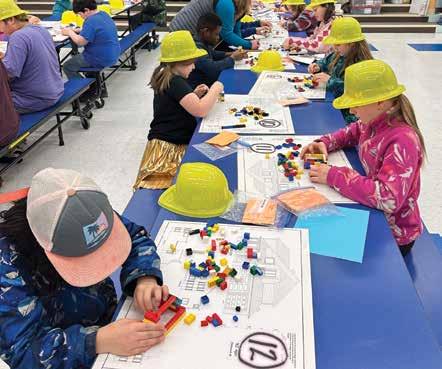
don’t know something, I bet you there’s a NAWIC member that will know and is willing to give me an ans wer and explain it.”
There’s also the NAWIC Education Foundation, which offers certification programs that members can complete on their own time to increase their knowledge, to qualify for new opportunities, and to gain credibility.
“I don’t always get treated like I have seventeen years in this industry,” Desmond-Layral points out. “That extra credentialing lends authority to the things I say. Having those training sessions and credentialing sessions are huge. They’re beneficial for everybody.”
While membership in NAWIC is focused on women, the Alaska chapter invites men and nonmembers to attend monthly meetings—an indication that NAWIC’s mission isn’t about men versus women but about increasing collaboration in the industry and recognizing
that everyone has something to bring to the table.
One way to measure NAWIC Alaska’s success is through increased interest. This year, more Alaska companies than ever participated in WIC Week events and did recognitions of women in their workforce through appreciation posts on LinkedIn and other social media. More companies also reached out, DuCharme says, to ask how they could get involved with hosting events, sponsoring the NAWIC chapt er, or volunteering.
“That tells me something is shifting,” she says. “My hope is that the energy of this week doesn’t stop here. We have incredible education and training opportunities right here in Alaska and a network of women ready to mentor and support the next generation. The path is here. The doors are open. And I hope more women walk through them than ever before.”


Nick Ferree, Vice President
By Rindi White

Despite shakeups in a few areas, Alaska’s construction industry is strong, according to the Associated General Contractors (AGC) of Alaska’s January 2025 Construction Spending Forecast.
The report, produced by McKinley Research Group and released in January, is an annual look at projects on the horizon in Alaska and whether spending in key categories is up or down. AGC of Alaska is the construction industry’s largest trade association, representing more than 600 businesses in all facets of the construction industry, from general contractors to banks and insurers.
In 2024, the forecast was mostly that private-sector spending was down and public-sector spending was up. The downward trend for private construction was largely due to high interest rates and the escalating cost of materials dampening commercial and residential construction, with
public construction up due to federally authorized transportation bills that boosted spending.
This year, interest rates dipped a little, and businesses shared plans to advance projects, particularly related to air cargo and logistics projects at Ted Stevens Anchorage International Airport and through Alaska Housing Finance Corporation’s new $24 million Last Frontier Housing Initiative, created in 2024 to fund low-income and professional housing projects across the state.
Public-sector spending, however, is down, particularly in Alaska Department of Transportation and Public Facilities (DOT&PF)-related projects. The 2024 projection for highways and roads was $805 million versus the 2025 projection of $600 million—roughly $200 million down, year over year.
AGC of Alaska Executive Director Alicia Amberg has her eye on that number. “One of our top advocacy concerns right now is the concerning
decrease in the amount of DOT work on the street, which doesn’t appear to be a one-off trend, experienced last year as a result of challenges with the STIP [Statewide Transportation Improvement Program],” Amberg told the Resource Development Council for Alaska at its February 6 breakfast forum, where the forecast was discussed. Her audience could well recall the disruption when federal highway officials rejected the initial submission of the state program, citing flaws that needed fixing.
Two days before that forum, Amberg and the AGC Department of Transportation Committee cochairs, Marcus Trivette and Jeff Miller, testified before the Alaska House and Senate Transportation committees, asking for help in offsetting a roughly $300 million shortfall in contract payments made by the state to construction contractors.
The shortfall translates to job cuts. Amberg noted that one contractor
in February had already made significant cuts to the company’s management team and was looking at having to lay off 10 percent of its workforce. The same contractor, she said, on February 4, 2024, had eight contracts in hand, ready for the year. This year, by that date, the contractor had only three.
“There are a few prime contractors who flew here to be with me today. Every single one of them is experiencing the same scenario. They are down 50 to 90 percent. These are specialized larger contractors; if they are having this experience, what is happening to the small mom-and-pop contractors?” she asked House Transportation Committee leadership.
While legislators expressed concerns about the job impact that a slower construction season might have, they did not add $300 million to the state budget to boost transportation spending.
But the back and forth did have other results. DOT&PF staff set up monthly public Tentative Advertising Schedule updates in which regional preconstruction engineers go over projects they expect to “hit the street” or go out for bid in the next few months. The first meeting was held March 19. Set up as a webinar, it wasn’t clear to viewers how many attended, and DOT&PF officials did not take questions live, but they did invite participants to type them into a question area. DOT&PF leaders say this was due to the webinar—rather than group meeting—format,
where questions might have appeared p ublicly in the chat.
DOT&PF Deputy Commissioner Katherine Keith said during the meeting that the goal was to provide contractors with “a certain degree of certainty” about the department’s upcoming schedule of work. “How we’re communicating about this is important and will inform how we
communicate about it in the next meeting,” Keith told those who attended the meeting.
DOT&PF has since set up a website for the Tentative Advertising Schedule monthly update meetings, where five questions asked during the first update have been posted, along wi th DOT&PF responses.

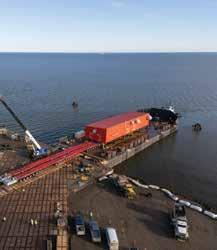
ConocoPhillips moved the Nuna drill site 3T module—the first built in Alaska in more than twenty years—to its location in the Kuparuk River Unit in 2024. First oil was produced at the site in December 2024.
ConocoPhillips

After a post-presentation meeting with contractors, some of whom also attended the meeting, Amberg said she planned to submit to DOT&PF a list of points about the meeting that those she spoke with hope are addressed in future meetings. Those points include information about projects that were dropped from the list without comment, addressing questions for each region as they came up during the presentation, and allowing the meeting to be more of a dialogue between presenters—some of whom did not appear on screen— and audience members.
Meanwhile, DOT&PF is working diligently to bring projects forward. Commissioner Ryan Anderson in February told state legislators he planned to have $100 million in projects advertised by April 1 and another $100 million by May 1. DOT&PF Director of Communications

Shannon McCarthy on March 28 said the department almost reached the first milestone, with $97.5 million advertised by that point.
“We view the construction contractors as our partners. We strive for continuous conversation with them,” McCarthy says. “We’ll keep updating our efforts to try to ensure that we have that two-way communication.”
The AGC forecast includes some bright spots for private-sector construction. Topping the list, with an estimated $1.49 billion in construction projects expected to hit the street this year, is oil and gas development. That’s largely due to Santos’ expectation that its Pikka Phase 1 project will wrap up this year while work continues on ConocoPhillips Alaska’s Willow Project through 2029.
The ramped-up work on the North Slope accounts for much of the uptick in private construction spending forecast for this year, says McKinley Research Group President Katie Berry. Santos, on March 19, reported the Pikka Project Phase 1 is about 80 percent complete, with the final push to first oil possible in late 2025. Santos Executive Vice President and Alaska President Bruce Dingeman says key production modules must be barged to the Arctic Ocean via the Hay River in Canada’s Northwest Territories, tasks that depend on logistics and weather, so the company is estimating first oil will more likely flow in mid-2026. Pikka Phase 1 is expected to deliver 80,000 barrels per day at full production. The Pikka update accompanied an announcement that new oil was developed at the Sockeye-2 exploration well east of Prudhoe Bay, a development in which Santos
holds a one-quarter stake, with APA Corporation holding a 50 percent stake and Lagniappe Alaska holding the remaining 25 percent share.
The ConocoPhillips Alaska Willow Project, with estimated production at 180,000 barrels of oil per day at peak operation, created more than 2,400 construction jobs over the winter and is expected to support 300 longterm jobs, with first oil expected in 2029. It’s the largest project to be developed on the North Slope in more than twenty years.
ConocoPhillips Alaska’s Nuna drill site 3T project in the Kuparuk River Unit (KRU) reached first oil production in December 2024. It was for this site that ConocoPhillips Alaska built an oil field production module—the first built in Alaska in more than twenty years— and shipped it to KRU last summer.
The company says it plans to have a total of twenty-nine development wells, along with additional on-pad infrastructure and pipelines that will connect the new wells to existing KRU processing facilities.
Although the oil and gas construction spending makes up a little more than 40 percent of all private construction spending outlined in the AGC forecast, there are other glimmers of hope. Most other categories on the spending forecast—utilities, residential, other basic industry, and other industrial/ commercial—saw upward movement of $10 million or more over last year’s forecast.
Construction spending related to hospitals and healthcare remained
flat, with about $260 million estimated in spending this year, and mining saw a downward trend from $165 million in 2024 to $135 million in 2025. That’s largely due to building activity at the Manh Choh gold mine wrapping up now that the mine is in production, Berry says.
Mining, she notes, can be tricky to categorize. Some activity, such as work done to support exploration, doesn’t lead to actual construction. Berry asks, “What is actual construction work versus capitalized drilling or other capital expenses that are not construction?”
She notes that the Ambler Access Road, currently on hold, was not part of the forecast, but that project is likely to move forward again. A January 20 executive order entitled “Unleashing Alaska’s Extraordinary

Resource Potential” calls for review of a 2024 US Bureau of Land Management “No Build” decision that ultimately stalled the proposed 211-mile industrial road. The order also reinstates a 2020 Record of Decision that had allowed the project to move forward during the first Trump administration. The timing of the order meant the project was not included in the forecast, Berry says, but she notes McKinley Research will be tracking it for future forecasts.
While the highways and roads category took the hardest hit, publicsector spending is mostly down across the board. Education-related construction spending is down by $95 million from last year, with an estimated $240 million forecast for this year. Also down by $95 million is airports, ports and harbors, and railroad spending. Other state and local government construction spending was estimated to be down by $20 million this year over last.
That doesn’t mean public works projects are not moving forward. Construction on a permanent school in Kaktovik is expected to wrap up this year, and Cornerstone General Contractors has begun work on the roughly $50 million Inlet View Elementary School replacement in Anchorage. Other education-related projects, both at K–12 schools and the University of Alaska, are moving forward. And $470 million of construction spending is estimated for airports, ports and harbors, and railroad projects, including major airport
infrastructure in Deadhorse, Kodiak, Nightmute, and Kongiganak, along with airport terminal improvements in Sitka and Ketchikan
The Port of Nome project has potential to result in higher spending than the 2025 forecast estimated. Port construction was delayed when initial pricing was well above US Army Corps of Engineers (USACE) statutory limits in October 2024, so the project was advertised again with a smaller scope. Instead of a Phase 1 that comprised a 3,500-linear-foot West Causeway extension with a 2,000-foot opencell sheet pile dock, the Phase 1A project will include a 1,200-linearfoot causeway and 600-foot dock with the remainder of the project to be advertised as future phases of work. Phase 1A carries an estimated cost between $250 million and $500 million. The bid award is expected in August 2025, and work could b egin in spring 2026.
A bright spot on the publicsector outlook is in national defense construction spending, which is up from $600 million forecast in 2024 to $940 million forecast in 2025. That amount includes extensive USACE-Alaska District construction, which includes residential upgrades statewide, new fuel infrastructure, major pier repairs on Shemya Island, construction of the Joint Integrated Test and Training Center on Joint Base Elmendorf-Richardson, and significant US Coast Guard projects in Kodiak and Ketchikan, along with Coast Guard communication site maintenance projects statewide.
The Joint Integrated Test and Training Center, considered a US
Department of Defense mega-project with an estimated cost of between $250 million and $500 million, is expected to begin construction in the fall. Solicitations closed in February, with a project award expected in the summer.
Also on the list of USACE-Alaska District projects is a $364 million runway extension at Joint Base Elmendorf- Richardson, which will extend Runway 16/34 from 7,500 feet to 10,000 feet and add supporting taxiways, along with providing shoulders, grading, drainage, an arm/ disarm pad, airfield lighting, and an instrument landing system.
One of the challenges in creating this year’s forecast, Berry says, was guessing how the Trump administration will handle projects funded under the previous administration. Some projects funded under the Infrastructure Investment and Jobs Act were paused in January, pending further federal review. That bipartisan infrastructure bill included large pots of funding, particularly related to broadband internet access, that are included in that review.
“There’s about a billion dollars in funding [to Alaska] that this year could be awarded to subgrantees, or might not,” Berry says. “If you have a billion dollars in the balance, clearly it’s not a billion going out to contractors [this year], but some of it might.”
Berry notes that McKinley Research doesn’t publish revisions to its forecast, so researchers will be noting the changes when crafting the 2026 forecast.
















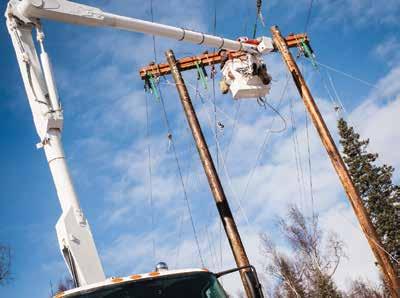

By Rindi White
Af ter years of planning and saving and months of watching construction progress, you have the keys to your new, custom-built home. It’s time to move in. Your internet provider is hooking up fiber to ensure everyone in the family will have fast, seamless internet for their various devices.
But wait, there’s a problem: the installation technician says running fiber to the interior wall where your media panel is located will mean stringing unsightly cable along the baseboard of your fit-for-amagazine dining room. If only this could have been avoided!
It turns out, it probably could have. While builders often include plans for the most up-to-date technology when building a new home, not everyone does. Internet service providers are eager to work with builders and make sure new construction buildings, whether residential or commercial, are prepared for the future as much as possible.
“In today’s world, you want to future-proof the homes because of the changing technology. Years ago, the internet wasn’t as big as it is today. We started out with an existing copper network with limited bandwidth. We transitioned from a copper network to fiber into the home,” says Robbie Nash, MTA’s vice president of outside plant engineering and construction.
Nash says the average home today has twenty-three devices connected to the internet. Planning for smart homes before construction is essential.
“If they wire for Cat6 (for ethernet or other network purposes), we want to make sure at the beginning they get a conduit from outside the house to wherever their media panel is going to be,” Nash says.
The media panel is where all telecom jacks are brought to a central location within the house, he explains. Having most devices function wirelessly makes wiring easier; generally, a house needs only one media panel. Nash says MTA can provide microduct conduits for builders to incorporate into walls, if the utility is consulted early enough in the process.
“Builders should install empty conduits with pull strings between key areas, making future cable runs simple. Alternatively, they could run Cat6a or Cat7 ethernet cables, making work for installers extremely easy and ensuring the home is futureproofed.”
Iwo Olewniczak, Manager of Outside Plant Engineering, A laska Communications




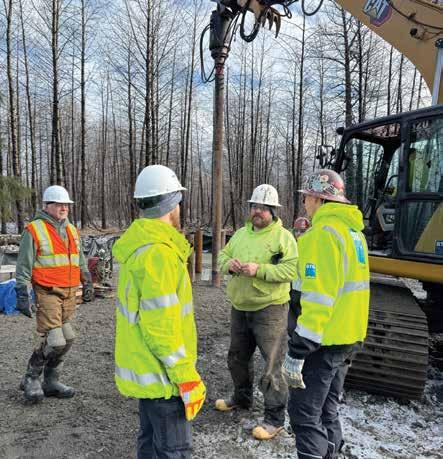
“We put the fiber in, then we will bury the microduct to the house. Then we can come back at a later date and pull it through,” he explains.
“What we really encourage is for developers to get in touch with us. We can let them know if we have fiber in the area or if we don’t; it helps us plan and prioritize our budget where we extend our fiber network,” Nash says. “[What] we’re asking them to do is, before they put the sheetrock on, get in touch with us. We’ll give them the microduct or conduit and ask them where they want to put the media panel. Then we can pull the fiber in or, if it isn’t available yet, we can pull the Cat6 in. There’s nothing worse than someone spending $500,000 to $600,000 on a home and then you go stapling stuff up on the outside.”
Nash underscores that the process generally works smoothly. MTA
works with a lot of builders, he says, and many of those builders build a lot of homes; in its MatanuskaSusitna Borough service area, many builders develop whole subdivisions and focus less on homes on scattered lots. For the most part, MTA has an open dialogue with those developers and works to get fiber to the new “greenfield” subdivisions quickly.
Rebecca Gamble, president of Hall Quality Homes, says her company typically works that way. Fiber is planned for the whole development so it’s ready to be brought into homes when MTA extends it, if it’s not already available. If the house has a buyer when it’s being built, placement of the media panel is discussed. If it doesn’t, she says, the media panel generally goes in the most ideal place, typically in the attached

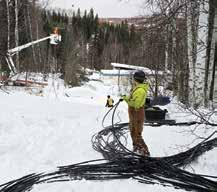
garage, and always with a Cat6e cable running to the router.
As president of the Mat-Su Homebuilders Association, Gamble adds, “We all have a good relationship with MTA, and they are always willing to work with us to get the best service possible.”
Iwo Olewniczak, manager of Alaska Communications’ outside plant network engineering department, says the company’s technicians have seen a few recurring issues that would be helpful to avoid, but the issues are primarily with existing homes. The issues, he says, are lack of fiberready infrastructure to the house and lack of structured wiring or future-proofing inside homes.


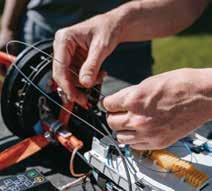
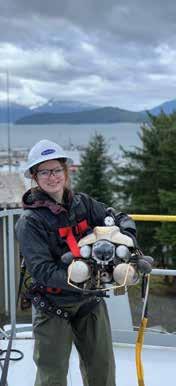

The first, he says, would be solved by having fiber-ready conduits installed from the home to the utility right of way so that crews don’t have to dig through a yard and possibly disrupt landscaping.
Explaining the second, Olewniczak says older homes generally lack structured cabling systems, “forcing installers to either leave the router in one spot and strengthen the signal via WiFi extenders or retrofit wiring in walls, which can be both costly and invasive. To avoid this issue, builders should install empty conduits with pull strings between key areas, making future cable runs simple. Alternatively, they could run Cat6a or Cat7 ethernet cables, making work for installers extremely easy and ensuring the home is future-proofed.”





For new home construction, Olewniczak, like Nash, suggests installing conduit from the street to a structured wiring panel inside the home, designing a location for the media panel—perhaps in a utility closet to keep appearances tidy—placing Cat6a or Cat7 highspeed cable and jacks in every room (especially rooms that might have televisions, home offices, or other smart devices) or installing conduits with pull-strings in walls and ceilings to make this possible, and pre-wiring Power Over Ethernet or capable ethernet ports to support smart devices such as cameras, access points, and Voice over Internet Protocol phones.
If that doesn’t happen? The Alaska Communications team can handle
minor retrofits such as drilling holes between the ground floor and a crawlspace or attic, but “as much as we would like to do whatever we can to deliver service to our customers, we are not specialized in completing medium to large structural changes around customers’ homes, like cutting into walls, adding power outlets, jacks, e t cetera,” he notes.
Outside plant engineering focuses on connecting individual buildings and facilities to wider networks; without the network, all the advanced tech in the world can’t provide connectivity.
Alaska Communications operates a statewide data network and

a diverse undersea fiberoptic system connecting Alaska and the rest of the United States. It has participated since 2017 in the Federal Communication Commission’s Connect America Fund Phase II universal service for high-cost areas program in Alaska, deploying high-speed internet to nearly 30,000 locations in Alaska, including Coffman Cove, Delta Junction, Homer, Hope, Hoonah, Kake, Kasilof, Kenai, Klawock, Larsen Bay, Ninilchik, North Kenai, North Pole, Seldovia, Sol dotna, and Sterling
It also participates in the Alaska FiberOptic Project—a collaboration between Alaska Communications and Calista Corporation, Doyon Limited, Gana-A ‘Yoo Limited, and
Tanana Chiefs Conference—that will bring high-speed broadband to up to twenty-one unserved communities along the Yukon and Kuskokwim rivers.
Meanwhile, MTA is working to distribute fiber throughout its service area. The company installs an average of 140 miles of fiber a year, Nash says.
“Our goal is to get fiber to homes everywhere, and especially to businesses,” he says.
Everywhere, for MTA, means in Mat-Su, Chugiak/Eagle River, and subscribers in the Beluga/Tyonek area, starting this year. Funded by a $12.5 million 2023 ReConnect grant from the US Department of Agriculture (USDA), the project—in cooperation with the Native Village of Tyonek—will lay 41 miles of transport

fiber from Point MacKenzie to Beluga and Tyonek, then extend that fiber into 144 residential locations, 14 businesses, and 1 educational facility in Tyonek. Nash says crews were in the field trenching the transport lines in March while the usually swampy, wet ground was frozen. The company hopes to wrap the project up by the summer of 2026.
Alaska’s largest telecommunications provider, GCI, has been working to bring fiber to rural Alaska communities, most recently through its AU-Aleutians Fiber Project, a more than $100 million project funded in part by a $25 million USDA ReConnect grant, a $29.3 million grant from the National Telecommunications and Information Administration Tribal Broadband Connectivity



“In today’s world, you want to future-proof the homes because of the changing technology. Years ago, the internet wasn’t as big as it is today. We started out with an existing copper network with limited bandwidth. We transitioned from a copper network to fiber into the home.”
Robbie Nash, Vice President of Outside Plant Engineering a nd Construction, MTA




“Before they put the sheetrock on, get in touch with us. We’ll give them the microduct or conduit and ask them where they want to put the media panel… There’s nothing worse than someone spending $500,000 to $600,000 on a home and then you go stapling stuff up on the outside.”
Robbie Nash Vice President of Outside Plant Engineer ing and Construction MTA
Program, $5 million in USDA Rural Development Community Connect Program funding, and more than $50 million in private funding from GCI that will ultimately lay an 800mile subsea fiber optic backbone, from which high-speed internet has already been delivered into homes in Akutan, Chignik Bay, King Cove, Larsen Bay, Sand Point, and Unalaska. Port Lions and Ouzinkie are next. Local fiber will also be built in Chignik Lagoon, Chignik Lake, Cold Bay, False Pass, and Perryville as part of the project
Simultaneously, GCI is also working with Bethel Native Corporation on a 405-mile fiber optic network that will bring highspeed internet to more than 11,800 people in Western Alaska through its Airraq Network (pronounced EYE-huck), named for the traditional Yup’ik game similar to cat’s cradle that, translated, means “string that tells the story.” That project is funded through more than $100 million in grants from the National Telecommunications and Information Administration Tribal Broadband Connectivity Program, the USDA Rural Development’s ReConnect program, and privat e investment by GCI.
Although delivering high-speed internet to existing communities is a large part of GCI’s efforts, the company also works to bring fiber to new subdivisions. It recently completed a fiber project in the west Chena Pump area near Fairbanks, where Jay Jones, GCI’s senior manager in the operations
department, says a multi-pronged approach led to fast adoption.
GCI crews performed the mainline construction and had both a salesperson working during the project and an internal wiring crew in the field ready to complete hookups, which led to a “fairly respective penetration rate right away, instead of waiting eight or nine months for a penetration rate of 50 percent or higher,” Jones says. “The build was a forty-five-home build, but we ended up doing it in a couple of weeks. From the moment the strand began to be hung to the time the first person got hooked up, it was two to three weeks.”
He adds, “Fiber is becoming more ubiquitous as it progresses, but we were able to make it as advantageous as possible.”
Jones says it would be great to be able to sit down—utilities, developers, and others who might be making decisions about utility routing—and try to map out what’s happening, ideally five or six years down the road.
Gamble says planning that far ahead is difficult. Land in Mat-Su is free-market, so what becomes available and developable can change within a short timeframe. “I’m not sure about next year at this moment,” she says.
Wherever new homes are being built, service providers have forms on their websites where developers can send requests for service and notices of construction, and experts are available to provide guidance on future-proofing homes with the l atest technology.




















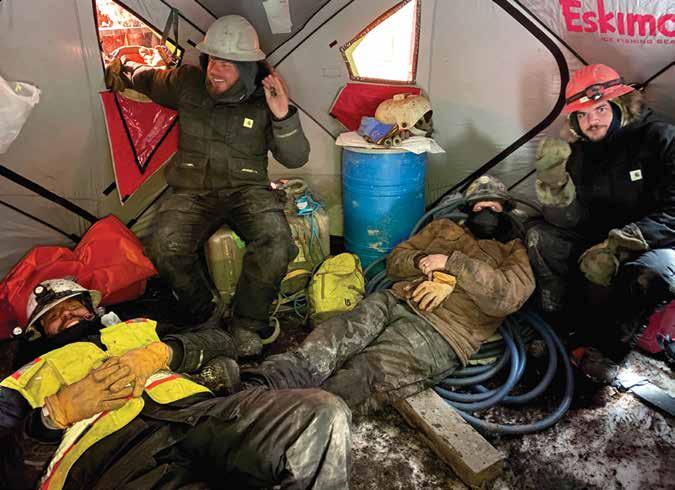
Accomplishing a lot with a little
By Nancy Erickson
o n’t underestimate a small crew leaving a large footprint. According to the US Small Business Administration’s 2024 profile for Alaska, of the 75,980 employers with fewer than 499 workers on staff (the agency’s definition of “small”), 2,349 were construction companies with fewer than 20 employees. No other industry in Alaska has so many businesses in that size category, amounting to one-third of all construction companies counted; most of the other two-thirds are owner-operators without any employees at all. In the building trades, those small shops can have a lasting impact.
Forming Alaska Commercial Development Group (ACDG) was a logical next step for Dave Greer, a construction worker during Alaska’s pipeline days. With his son Matt, Dave started the design-build contractor in Fairbanks in 1997. Matt’s wife, Amie, joined the company two years later under the patriarch’s tutoring, learning everything from laying concrete slabs to shingling roofs.
Following Dave’s retirement in 2006, Matt and Amie assumed the helm, continually expanding the company while raising a family and establishing a second work base in Nome.
“Our expertise is in design-builds,” Amie Greer explains. “We typically get a simple sketch or idea from a client and then develop it from there. We work in coordination with a team of independent architects and engineers. We develop construction plans based on the client’s needs and budget as a team.”
Husband and wife work onsite during the construction phase to maintain a high level of control over all aspects of the project from start to finish. “It is not unusual to see Matt with a shovel or me on a tag line laying out trusses,” she adds. “This approach has ensured the project stays on schedule, within budget, and safe. This has been highly successful, with an average of less than two change orders on a million-plus complex jobs and excellent communications from all trades and crews.”
At ACDG, the key to larger projects is organization, which leads to clear communication. For example, the Bering Air Hangar project at the Nome Airport benefited from this approach.
The couple spent time visualizing and discussing how the 30,000-square-foot structure would develop, working on value engineering and problem-solving issues with their design team, subcontractors, and suppliers. One challenge was creating a design encompassing a
“This
Amie Greer, Co-owner, Alaska Commerci al Development Group














































28-foot-high custom sliding door system that could withstand Nome’s extreme high-speed winds.
Another challenge was logistics. Materials had to be freighted from Texas to a barge in Washington in time for a June departure to Alaska. The unexpected happened when the truck broke down in Denver. After many phone calls, an ACDG freight partner flew a driver to Denver to meet the repaired vehicle and teamdrive it to the barge in time for the scheduled departure.
“We gained so much knowledge and feel honored to have had the opportunity to complete such a large project with a small crew,” Greer adds.
Greer says depending on small local companies is also beneficial: “This is a demanding environment with many challenges, and it takes teams of people backing small crews to make a large project come to light.”
An upcoming extensive demolition project holds a special place in Greer’s heart.
“There’s an old blue airplane hangar at the Nome airport where Wien Airlines used to operate,”
she explains. “My grandpa, Fred Richards, was one of Wien’s senior pilots and has told us stories about flying around Nome. I think about the history—and the future—of the space. It’s a full circle with construction in Alaska.”
Sullivan Water Wells has seen substantial growth under the experienced guidance of three generations: from A&L Drilling founded by Lee Sullivan and Les Augusten in 1963, a name change under son Bill Sullivan’s ownership beginning in 1983, to Cole Sullivan’s gradual takeover of the business from his father in the 2000s.
“Our main focus since the beginning has been residential water wells and light commercial, such as grounding wells and piling,” says Cole Sullivan, now the company president.
It’s spiraled out from there. “In 2010 we brought pump system installation and service in-house. In 2014 we expanded into heavier commercial drilling, including oil
An Alaska Commercial Development Group crew erects structural steel for the Bering Air hangar in Nome, in coordination with STG Inc. crane operators. Crews worked 24 hours a day to complete the exterior before winter.
Matt
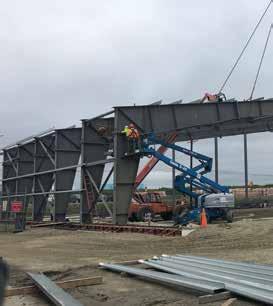
field and mining support. In a few short years, we went from one rig to six,” Sullivan says. In 2022, the company purchased a Foremost DR40—one of approximately a dozen in the world—capable of rotating 40inch diameter casing.
Based in Chugiak, the company also covers the Yukon-Kuskokwim region from its branch location in Bethel. “We work all over the state; anywhere we can fly, drive, or float a rig or pump truck,” he says.
“Drilling is a field where almost every job has a new and unique set of challenges,” says Sullivan. “Alaska’s geology is random, and what may work well in one area may not work at all on the next. Boulders are the most obvious challenges that drillers or pile drivers encounter.”
The Chugiak/Eagle River area where the company does much of its work is known for large deposits of boulders. “We carried dynamite everywhere we went, as blasting our way through boulders was imminent. It’s a skill that eventually died out after September 11 and getting explosives was more difficult,” he explains.

The company’s first dual rotary rig was a game changer for boulders, allowing crew to drill difficult formations effortlessly. “Because of the unique control of the casing, we can maintain a straight well or pile and penetrate boulders, bedrock,

concrete, and trash,” Sullivan says. “We’ve even drilled through a buried bus, some cars, wood and many mystery objects.”
Of his eight-person crew, Sullivan says, “Over the years, we have adapted to every scenario we have encountered, but we still find ourselves learning how to overcome the next new challenge.”
Logistics are a major undertaking with large, specialized equipment, Sullivan notes. “We get our rigs where they probably shouldn’t go

at times and probably shouldn’t be there. In short, if someone doesn’t want a job or can’t complete it for whatever reason, we are willing to put our team on it.”
Sullivan approaches the multitude of daunting projects by focusing heavily on best management practices with a zero-failure attitude, beginning with the absolute best plan first.
“We have had jobs with a 24-hour schedule in subzero temperatures— some for months without stopping— with helicopters bringing us and material to remote sites,” he recalls.
“We completed five wells in Interior Alaska that started out at 40-inch diameter. The material was a manmade ‘mountain’ of granite blast rock up to 8 feet in diameter and depths to nearly 200 feet. There was a steep learning curve, but we made constant adjustments and went from one month per well (24 hours a day), to just five days, making up all the time we lost.”
Sullivan says proper planning and being able to think on your feet is critical. He observes, “Forgetting one simple thing or a major breakdown can cause huge delays if you are not prepared with backups or the ability to work around the problem.”
Sullivan credits his company’s success to his incredible, talented, and dedicated employees, as well as the support of his wife and, not the least, lessons gleaned from his father, who instilled hard work, efficiency, humility, fair business practices, and doing it right, even if it is more difficult.
He also believes having a healthy relationship with similar companies

and the willingness to collaborate is important. Sullivan says, “A big part of our success comes from some of our competitors. We are able to assist with specialized aspects of bigger projects or take over a project that has some unforeseen conditions. We do the job, move down the road, and everyone is happy, and we always reciprocate whenever possible.”
Anchorage-based Loken
Construction purchased its first boom truck in 2006 and has been lifting Alaska ever since.
“In 2014, we expanded into our own entity—Loken Crane Rigging & Transport—and now have four new and late model cranes and employ seven of the best people in the world,” says company manager Tyler Loken.
Loken grew up in the Midwest, working with tractors and equipment on family ranches and his father’s construction business. That experience led to the company’s
creation in Alaska. “I knew we could build things safer, better, and faster with cranes and serve other’s crane needs as well. Our construction side and their team really help the crane side with work,” Loken says.
The company’s stack of challenging projects is extensive. “Many times on our construction projects, they will swing ninety-plus picks a day,” says Loken, referring to a crane picking up a load. “Most crane companies swing one or two picks a day. Ninety picks in a day is a lot of precision and experience.”
One exceptional project stands out, even though it occurred twelve years ago. Loken’s crew was tasked with gently removing a 25-foot, ancient Native skin whaling boat from the Anchorage Museum and transporting it to another exhibit location. Moving a piece of history and making sure to preserve it took a lot of caution, communication, and courage, Loken says. All rigging needed to be custom designed not to damage the precious cargo.
Loken credits his operators: they take challenging, complex rigging and charts and make it happen, from lifting a $500 truss to a priceless Native artifact.
“Consideration for what makes a project big or small is up for debate,” says Loken. “Moreover, it’s the next hurdle; the next mountain and how we approach that—can-do or can’tdo. I’m very humbled and honored to get to work with a lot of ‘can-doers.’”
His approach to difficult projects: “A lot of can-do thinking and doing; set the vision and the pace; express gratitude at the end; and serve in between.”

By Alexandra Kay
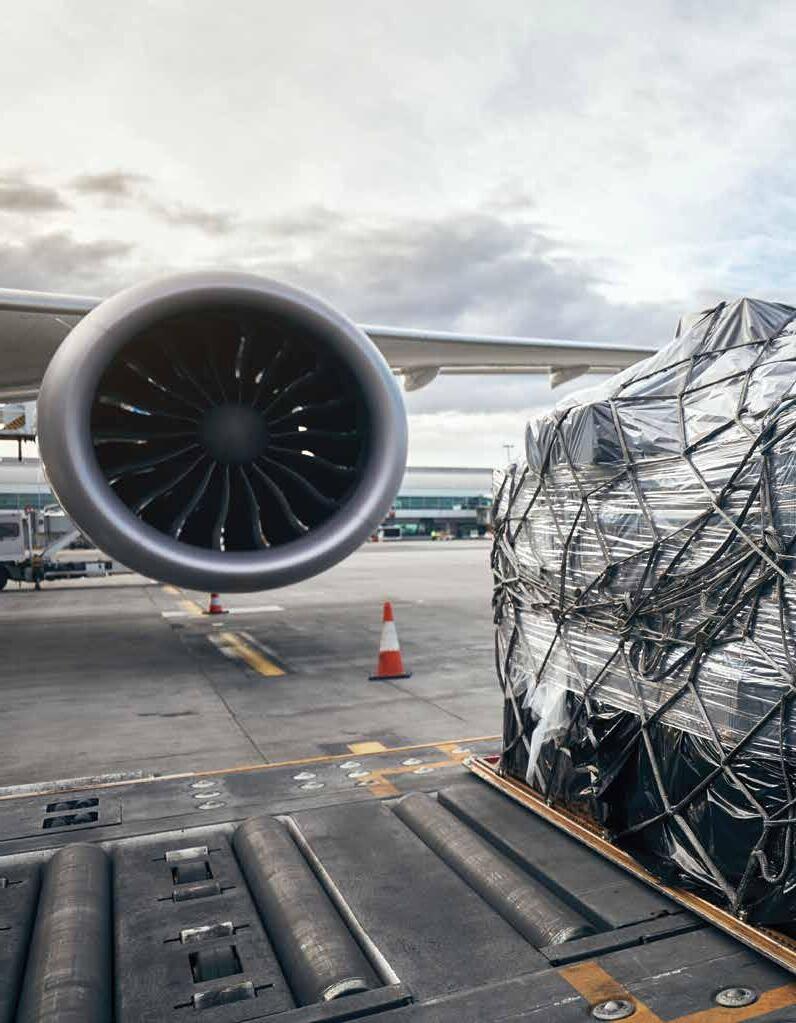
Busy airports require constant maintenance and upkeep, and Ted Stevens Anchorage International Airport (ANC) continues to enhance its infrastructure with several key projects underway in 2025. These projects represent significant investments in Anchorage's position as a critical node in global air cargo networks. “During the COVID-19 pandemic, ANC rose to become the third busiest airport for air cargo in the world. Today, it remains the second busiest airport in North America and currently ranks fourth globally in cargo throughput,” explains Angie Spear, director of Alaska International Airport System.
A surge in ecommerce has maintained pressure on the airport's infrastructure even as pandemic conditions have eased. During peak cargo periods, the airport faced such high demand that aircraft had to be parked on taxiways while awaiting their next flights. As ecommerce continues to

“We
Giovanna Gambardella Principal and Alaska Area Leader, Stantec

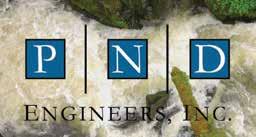
drive demand for air freight capacity, the infrastructure expansions at ANC will help ensure Alaska remains competitive in this vital economic sector for years to come.
The ANC Taxilane Echo and Mike Improvements project, with an estimated cost between $50 million and $60 million, went out for bid this spring. This extensive project includes installing concrete, replacing pavement, upgrading lighting, markings, and signs, plus storm drain improvements. Construction is expected to begin this summer and will span two years.
Two additional projects that were bid last fall are set to commence this construction season. The ANC
North Terminal Apron and Taxilane Reconstruction start this spring, while the Taxiway R North and Taxilane U Improvements will also begin this summer. Both projects are expected to be completed by the end of the 2025 construction season.
These developments coincide with the finalizing of the Airport Master Plan, highlighting the continued efforts to modernize the facility.
At the same time, the airport is positioning itself for continued growth in the cargo sector with two significant infrastructure projects currently in development. The ANC West Cargo Expansion and Taxiway Z Extension West, Phase I projects represent critical expansions. Stantec is leading the design for both projects. As the prime consultant for both projects, Stantec is leading
DORSEY ATTORNEYS HAVE SERVED AS TRUSTED COUNSEL TO ALASKA CLIENTS FOR OVER
With over two decades of history in the Anchorage community, Dorsey & Whitney provides full-service legal counsel to clients in the Alaska market and beyond. Backed up by the resources of an international law fi rm with over 550 attorneys across 21 offi ces, we offer global reach, local resources, and productive relationships. We understand our clients’ businesses, risks, and goals –making us a wise choice for smart businesses everywhere.
the comprehensive design efforts. “We're doing civil and electrical engineering and environmental analyses/documentation,” explains Evan Griffith, senior project engineer at Stantec. For the West Cargo Expansion project, the firm engaged R&M Consultants to provide topographic survey services.
The West Cargo Apron project will provide much-needed remote overnight parking spots (RON) for large cargo aircraft. “This will meet the demand for more RON positions for aircraft to be able to come in and refuel for the next leg of their flights,” Griffith explains.
When completed, the apron will feature four new parking positions that can accommodate up to Design Group VI Aircraft, complete with ground fuel, power, and overhead



lighting systems Griffith says, “The project is in the final steps of the design alternatives development process, and a preferred alternative has been selected. The next step is to complete the design and address environmental requirements.”
The Taxiway Z Extension serves multiple strategic purposes including increasing operational efficiency for large aircraft use and provide connections to new airport development south of Runway 7R-25L. It represents the second phase in a series of projects that will eventually create a full south parallel taxiway to ANC's Runway 7R-25L. “Taxiway Zulu extension is 75 percent designed, and the project team is working through the environmental process,” says Griffith. Environmental field work is scheduled for this summer.
Another project that went out for bid this spring is the ANC West Perimeter Road, which parallels West End Road.
“The project will relocate the road next to the perimeter fence which will provide better access to inspect the fence daily per TSA requirements,” says Jennifer Pepin, engineering and environmental manager for ANC. The relocation will move the road approximately 1,000 feet from its current position. At an estimated 3,000 to 4,000 feet in length, this relatively small project comes with a price tag between $1 million and $2.5 million. Once bid, the project will go through the award process as a low-bid project, with construction expected to begin and be complete this construction season.
Beyond improved security compliance, the perimeter road relocation offers additional benefits. “The relocation of the road will allow for more additional clean fill sites for future projects,” Pepin notes.
More immediately, Taxiway Z Extension West, Phase 1 will provide crucial access for a new private cargo development. “There's the Northlink development near the south airpark, and they [ANC] need to provide taxiway access from the airfield to that facility,” Griffith explains. “The facility is going to handle 747-sized cargo aircraft. NorthLink is responsible for the apron and facilities on the lease, whereas the airport is responsible for the design and construction of the taxiway.”
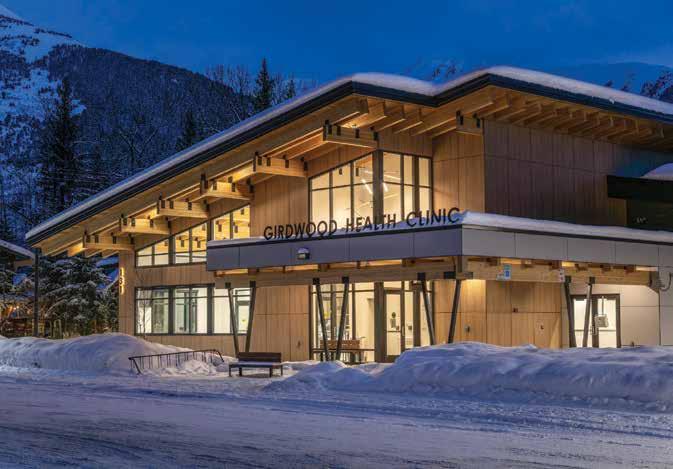


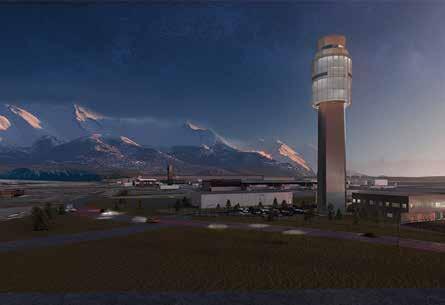

Another private-sector development at the state-owned airport is FedEx’s new Alaska Domestic Operations Center. The facility will consolidate all FedEx package movement throughout Alaska, housing Anchorage pickup and delivery operations while also sorting and loading all intraAlaska flights to Fairbanks, Juneau, Sitka, Ketchikan, Kenai, Homer, and Kodiak. FedEx also plans to use the center to process all packages destined for rural Alaska customers. This expansion enables FedEx to free up capacity at its
international hub. The nearly $200 million project remains on schedule, with operations expected to begin around October 2026.
The Taxiway Z Extension involves closing existing facilities. “In order to build the entire project, we have to close the firefighting training center and the FBI shooting range, and that's an environmental effort that will take quite a bit of time to get through the procedures to properly close those sites, ” Griffith explains.
While there are no facilities involved, the West Cargo Apron project requires massive earthwork. “We know there's [more than] 2 million cubic yards of excavation to be done,” Griffith notes. “It warrants a road relocation and some tug road extension—so there's quite a bit of earthwork to be done to get that project built. “You could easily see this as a three-summer project,” Griffith adds. “You can only move so much earth every day.”
Both projects carry substantial price tags for total project costs.
Taxiway Z Extension West, Phase 1 is estimated between $40 million and $50 million and ANC West Cargo Expansion is estimated between $90 million and $100 million.
The timing of when these projects go to construction depend on multiple factors. Funding the project and accessing FAA grant opportunities are part of the decision process. “Our construction dates are generally dictated by grant funding requirements: when the grant is available for construction—the FAA grant,” Griffith notes. Current projections suggest that Taxiway Z Extension West, Phase 1 will begin construction around 2026, while ANC West Cargo Expansion is targeting construction starting in 2027. Alaska's short construction season compounds these challenges.
The most monumental construction at ANC is soon to come. The FAA contracted Stantec to design a new Airport Traffic Control Tower (ATCT) and Terminal Radar Approach Control facility. The team finalized the design
in summer 2024, and the FAA is now securing construction services.
“The current tower, constructed in 1977, was designed to accommodate only four air traffic controller positions,” notes Giovanna Gambardella, principal and Alaska area leader at Stantec. Since then, ANC has expanded significantly, becoming North America's second busiest and the world's fourth busiest cargo airport, leading to overcrowding and line-of-sight issues for controllers.
The new ATCT will stand as Alaska's tallest occupied structure at more than 300 feet—slightly taller than the tallest skyscraper in Alaska, the ConocoPhillips Building.
At the top of the tower, a twelvesided cab with durable metal panel cladding will enhance technology and
viewing capabilities while addressing overcrowding by incorporating additional space for staff.
“We are proud to contribute to an iconic facility that is vital to our community and will be for many the first welcome to Alaska,” Gambardella says.
This facility will provide air traffic control for both ANC and the Lake Hood Seaplane Base, the world's largest seaplane base, which together serve approximately 5.7 million passengers and handle more than 3 million tons of cargo annually.
The project also includes a 10-mile fiber optic telecommunications loop connecting National Airspace System facilities with the new ATCT/Terminal Radar Approach Control facility.
Collectively, these infrastructure projects represent a comprehensive

modernization effort for ANC, positioning it to maintain its crucial role in both passenger service and global cargo operations for decades to come. With investments totaling well over $300 million across all current projects, the airport is addressing immediate operational needs while building capacity for future growth.
Airport officials note that all projects are being coordinated to minimize disruption to current operations while advancing on schedules that accommodate Alaska's limited construction seasons. When completed, these developments will enhance safety, efficiency, and capacity at what has become one of North America's most strategically important transportation facilities.
Block & Concrete
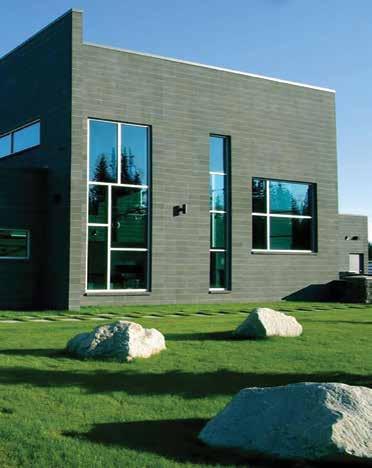
We want to thank all the Alaskans who have supported us over the past 50 years. What we have accomplished together is truly remarkable.
By Vanessa Orr

The Alaska Railroad wouldn’t be possible without the 175 bridges and large culverts that span barriers that would otherwise limit travel. Over time, many of these bridges have deteriorated and now require rehabilitation or replacement.
The Alaska Railroad Corporation (ARRC) has a systemwide five-year plan that includes rehabilitation or replacement of approximately fortyfive bridges ranging from small wooden bridges to more massive steel spans. The bridge program follows comprehensive track replacement that spanned the entire length of the railroad, from Seward to Eielson Air Force base.
“We can rehabilitate 560 feet of railroad, but if you leave out 28 feet of bridges, you don’t have a 560-
feet railroad anymore,” says Brian Lindamood, ARRC vice president and chief engineer. “But after we’ve fixed the full physical route once and for all and made it what it needs to be, we’ll be able to maintain it over the long term.”
In 1985, the State of Alaska purchased the sixty-year-old railroad from the federal government for $22.3 million and spent the next few years rebuilding it after years of poor maintenance. Total repair costs exceeded $700 million.
“The best thing that happened was that the state got a fully depreciated railroad; the worst thing that happened was that the state got a fully depreciated railroad and did not have the capital to renew it
and get it to where it needed to be,” says Lindamood. “They struggled for two decades with that. When federal money became available, we worked with our legislative team to start bringing in capital funds to help fix it up. But we’re still looking at billions of dollars in deferred maintenance.”
He adds that, under federal ownership, the railroad had gone thirty years without replacing any bridges, and ARRC is still catching up to this day.
“In the lean years right after the transfer, the railroad was looking for every nickel to keep the track open, so we mainly replaced small, easy bridges,” he says. “We still have the big ones to reckon with, which has been our focus for the last two to three years and will remain our focus for the next seven to ten years.”
According to Lindamood, when the railroad first fully opened in 1923, its builders were doing everything they could to complete it quickly, which included cutting down trees to build temporary bridges. While some of those bridges have since been replaced by steel bridges, approximately 45 percent of the railroad’s bridges are more than ninety years old.
“When I took this job in 2018, one bridge was over 100 years old; the next year, that number was up to thirty-seven bridges, and the next year even more,” he says. “They’ve performed very well, and in a lot of cases we were able to go in and rehabilitate them, cleaning them up, replacing members damaged over years, and making them a little bit stronger.
“In other cases, we’re looking at bridges that were put in after World War II that were designed to European railroad specifications, which are lighter than the ones in the United States,” he adds. “We’ll be fully replacing a lot of those bridges as they are not strong enough to continue to hold the traffic they are carrying.”
Once the bridge program is completed, passengers and freight customers will both feel the benefits. Passenger service will be more reliable, and efficiency of railroad operations will improve; trains will move at more consistent speeds since they will no longer be required to slow down when traveling over bridges due to bridge age and deterioration. Freight operation costs may also be reduced thanks to higher capacity;
currently, ARRC must limit loads on railcars to accommodate bridge weight capacity that is significantly lower than the rest of North America’s rail freight network.
“In the 1990s, the standard railroad car weight went from 263,000 pounds to 286,000 pounds, but we’ve never made that jump,” says Lindamood. “The bridge program will allow us to
do that. Instead of cars carrying 100 tons, they will be able to carry 110 tons, an increase of 10 percent.”
In 2005, the ARRC used GARVEE bonds, a form of forward-funded federal financing, to overhaul the track from one end of the railroad to the other. The rehabilitation took
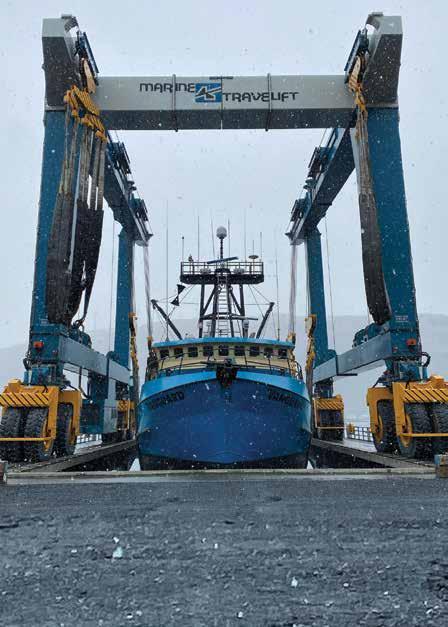
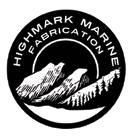
about six years, and ARRC paid off the bonds two years ago, clearing the way for the next phase.
“We put $250 million into the track, and we’re going to put a similar amount into the bridges,” says Lindamood, noting that the railroad has already begun repair work and is now about 20 percent into the project. “With inflation, however, this may cost $400 million before we’re all done.”
The timeline of various projects is also hard to predict as the current political climate may affect federal funding.
“Like everything else with the federal government, who knows what will happen?” says Lindamood. “In the past couple of months, we’ve had to wait for the granting agencies that we work with to get caught up with how the world is changing. We do know
that one competitive grant we plan to apply for is still planning to come out, but it has been delayed three or four months. We don’t know if some other programs that we were planning on using will survive.”
Lindamood adds, “Ask me again in six months, and I’ll probably have different answers.”
The ARRC’s 2025 Bridge Program budget is approximately $15 million, mostly paid with Federal Transit Administration formula funds, which require a 20 percent match from ARRC.
The remaining projects are funded through competitive grants from the Federal Railroad Administration or by the corporation’s internal funds—but not from the state treasury.
“The Alaska Railroad is selfsustaining; we’re not a part of the capital budget,” says Lindamood.
“We charge customers $110 to move something from point A to point B that costs $100, and we put that $10 profit right back into infrastructure. Because we run regularly scheduled year-round passenger rail services, we are able to get formula funds from the Federal Transit Administration, which are substantially used on infrastructure projects.”
He adds that the railroad has also been very successful over the last couple of years—to the tune of hundreds of millions of dollars— in competing for grants. Largely run through the Federal Railroad Administration, these grants fund 50 percent to 80 percent of projects.
“We then match those funds to complete projects; for example, the Mears Memorial Bridge in Nenana is being funded by a federal grant



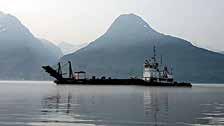


of $48 million, with the Alaska Railroad making up the 20 percent difference,” says Lindamood.
Each year, ARRC begins work on at least three bridge projects, and more are tackled as funding allows.
The Eagle River Bridge at railroad milepost 127.5, north of Joint Base Elmendorf-Richardson, is now entering the construction phase. The $40 million project, awarded to Kiewit in 2022, will replace the 308-foot deck girder bridge with a new 360-foot triple-span deck plate girder bridge. Completion is estimated by the end of 2026.
Swalling General Contractors is replacing the 151-foot bridge that crosses Bird Creek at railroad milepost 86.6, south of Anchorage. The $7.74
million project, which will replace the aging Pratt style 123-foot pony truss span and two 14-foot timber trestles with a 125-foot throughplate girder bridge, is slated for completion this summer.
Martinus Bottom Line is rehabilitating the 406-foot, open deck, steel through-truss bridge crossing the Talkeetna River at railroad milepost 227.1. The $9 million project will rehabilitate the two 200-foot steel through-truss spans with targeted repairs, replacing an aging 400-foot walkway and repairing the walkway fence.
At the time of this article, ARRC was waiting on bid results for replacing the 123-foot Pratt style pony truss bridge and two 35-foot I-beam spans crossing Ship Creek near downtown Anchorage, railroad milepost 114.3.




The aging bridge will be replaced with a new ballast deck bridge consisting of two 79-foot and one 30foot steel I-beam spans.
“We’re going to make it a hair longer and also make room for a bike path that the municipality is building to connect Ship Creek Trail with the Coastal Trail,” says Lindamood of the $16.2 million project just outside the windows of the ARRC headquarters building.
In the next few years, ARRC expects to use a competitive grant to replace the six-span, 647-foot structure over the Chena River near Fort Wainwright and use a $43 million Consolidated Rail Infrastructure and Safety Improvements grant to rehabilitate the Mears Memorial Bridge in Nenana.









It is also waiting on final approvals to move forward with replacing a single-span, 62-foot through-girder bridge over Little Goldstream Creek at railroad milepost 422.9 about 10 miles north of Nenana with a 75foot steel span bridge.
“I’d like to have that bid on the street this year, but the federal government being what it is, I just don’t know,” says Lindamood.
In the next year, ARRC is hoping to replace the single span, 80-foot deck plate girder bridge over Little Willow Creek at railroad milepost 190.5 north of Willow with a 25-foot throughplate girder bridge. Sometime in the next five years, the railroad would also like to rehabilitate the iconic Hurricane Gulch Bridge at railroad milepost 284.2, the longest and tallest bridge on the Alaska Railroad, if grant funding allows.
“We’ve also got three bridges north of the entrance to Denali Park that are funding-dependent,” says Lindamood of the two 125foot bridges and one 400-foot bridge. “We’re working on getting environmental approvals back now, and we’re hoping to start one bridge next year, one the year after, and one the year after that.”
Depending on the Alaska Department of Transportation and Public Facilities (DOT&PF) schedule, ARRC will also be working on a large truss bridge over the Snow River at railroad milepost 14.5 north of Seward in the next couple of years. DOT&PF first needs to replace a highway grade separation at the south end before work on the bridge can start.
“The bridge is subject to flooding every other year, particularly with
“We put $250 million into the track, and we’re going to put a similar amount into the bridges… With inflation, however, this may cost $400 million before we’re all done.”
Brian Lindamood Vice Presiden t and Chief Engineer Alaska Railroad Corporation
the glacial outburst flood, and the streambed has accreted to the point that we have to make the bridge higher,” says Lindamood. “Because the highway is over us at the south end, it means the road has to go up as well.” The project will also include work on the approach spans and other repairs.
One challenge with every project is how to shut down a bridge without causing too many passenger and freight issues.
“There is no detour route; there’s only one railroad between Seward and Fairbanks,” says Lindamood. “While DOT can find other routes [for highway construction], a lot of what drives our bridge design is the ability to do it under traffic. We may have to shut down for 48 hours, but we look for a time when there is not as much traffic and try to bend
schedules around that.”
While ARRC has a small engineering team and project management team that deals with the day-to-day upkeep, it often relies on environmental engineering consultants and local contractors for construction support.
“Our in-house staff deals with the smaller bridges and already has a lot of work in front of them keeping our existing bridges in a state of good repair,” says Lindamood. “The bigger bridges require a level of expertise and equipment that we don’t need to carry in the long-term, so it makes more sense to use contractors.”
While some projects are low-bid contracts, others, like the Eagle River Bridge project, are awarded through alternative delivery methods, including construction management general contractor. After completing 30 percent of the design, ARRC hired Kiewit to find the best way and best price to deliver the project.
“We use this method when we’re working on very complicated projects,” says Lindamood. “The Eagle River project is located in a very narrow river canyon on an Air Force base. It’s not easy to access; there’s a river with fish in it and an archeological site downstream. That’s why we selected Kiewit to help.”
When the program is completed, one-quarter of bridges along the tracks will be ready to enter the railroad’s second century of operations.
Lindamood says, “We are doing everything we can through the bridge program and other initiatives to make sure that Alaska gets the rail service it needs.”













It’s important for us to take extra care to ensure the safety of our sta , our customers and our environment in everything we do. From extensive training in the safe handling of fuels and lubricants to constantly refining our procedures, Petro Marine makes safety our #1 priority every day, every task. No exceptions. petro49.com







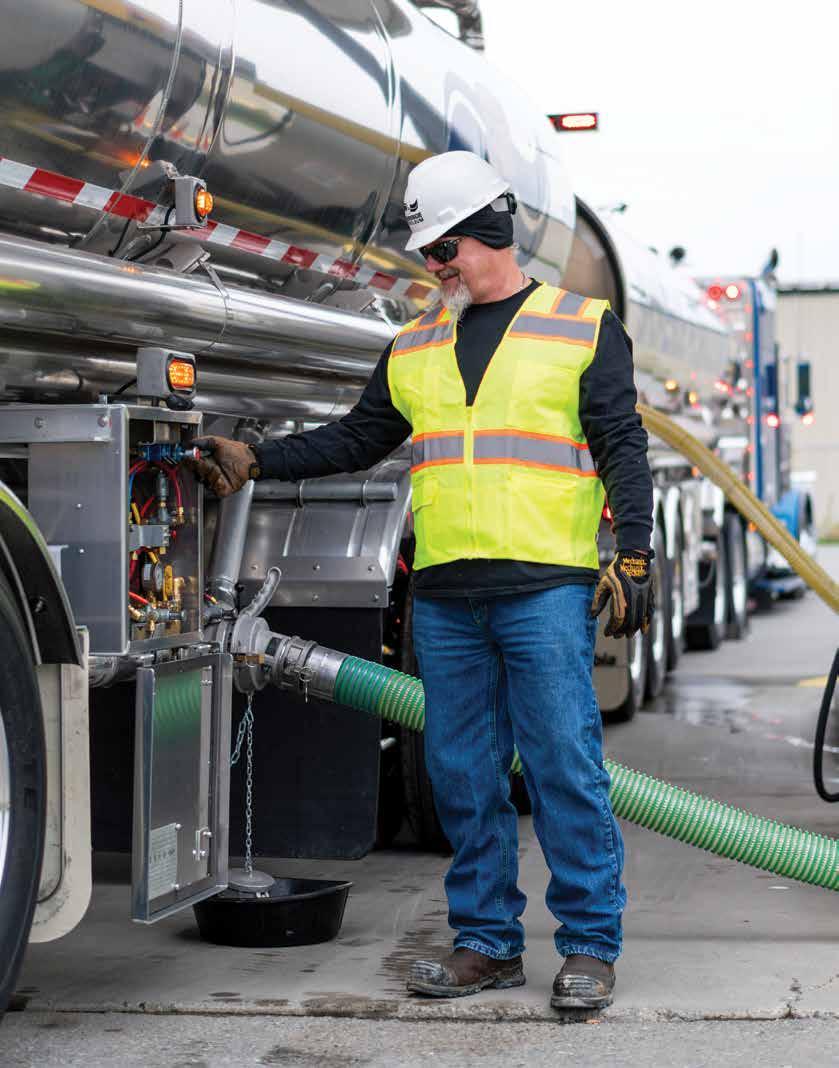
By Dimitra Lavrakas

Behind a successful company is a businessperson who sees a need and fills it.
In Kodiak, that’s Cooper Curtis of Highmark Marine Fabrication.
Born in Anchorage, he grew up in Talkeetna and graduated early from high school. Afterward, he gained skills in small engine mechanics and completed welding courses at Alaska Vocational Technical Center in Seward.
“I worked for a company in Seward, but I fell in love with Kodiak,” Curtis says. “I left that
company with no options to go on and moved to Kodiak.”
There, he set up with a welding truck as an independent contractor. But, he recalls, “I realized my clients needed more.”
In March 2014, Curtis opened his fabrication shop and grew it from one employee—himself—to fortyfive full-time workers.
His military service provided him with insight into how to work with people. “I was enlisted for six years as
a Marine and deployed to Botswana, Serbia, and Ukraine,” he says.
Those years were formative in how he approaches running Highmark Marine. “I gained the knowledge and insight into the leader I could be, and it was a huge help to making this company successful,” he says.
First and foremost, he says, is hiring good employees: “I realized as I grew that I needed more people.”
As the departments evolved, Curtis added skilled workers in varying specialties, from welding and fabrication to painting and finishing.
To keep up with the new departments, employees were given advanced training. “We hired people and sent them to additional training, and then they would pass on that knowledge,” he says.
Along with the surge in workers, Curtis added more locations and warehouse space. “We outgrew our old location and acquired an existing business in Kodiak in order to expand our operations,” he says. “Since then, we have added three more industrial warehouses and a dock that support our different operations.”
The old location boasts the 600ton Marine Travelift hoist, the largest in Alaska, capable of lifting vessels up to 1.3 million pounds. The Travelift is in the shipyard owned by the City of Kodiak, which contracts with Highmark Marine to operate the shipyard.
The new dock is around the corner from Saint Paul Harbor, at East Point Dock in the Kodiak channel by Alimaq Bridge. “East Point Dock is owned and operated by us,” he says. “It expands our services to the waterfront and allows dockside repairs to be conducted at our own facility.” East Point Dock is open to marine vessels of every type and size for moorage, wharfage, crane services, underwater inspections, dockside repairs, and other services.
By adding a commercial diving division, Highmark Marine brought new capabilities and options to Kodiak and Alaska’s fleet and marine infrastructure. Pier and vessel-based with fast deployment capabilities






A STABLE BANKING RESOURCE FOR ALASKA BUSINESSES, VILLAGE CORPORATIONS AND NATIVE NON- PROFITS FOR OVER 40 YEARS.
Commercial Real Estate Loans
Term Loans & Lines of Credit
SBA Loans
Access to USDA and BIA Guarantee Programs
Depository Solutions
Treasury Management
Contact: Daryl Lowe
Vice President
dlowe@ncb.coop (907)-351-0829








“I was enlisted for six years as a Marine and deployed to Botswana, Serbia, and Ukraine… I gained the knowledge and insight into the leader I could be, and it was a huge help to making this company successful.”
across Alaska, diving services also enable piling and hull inspections, cleaning, welding, and repair. Diving, says Curtis, is the most physically demanding job.
A four-acre site on Mill Bay Road near Kodiak Municipal Airport encompasses Highmark Marine’s fabrication facility and an extensive inventory of metals, plastic, pipe fittings, compressed gases, coatings, abrasives, tools, marine propulsion equipment, and rental equipment.
In the waterjet and machine shop, Highmark Marine added
the Flow Mach 500 CNC Waterjet, a fast and accurate computerdriven cutting platform that sprays garnet abrasives through a hair-thin water stream.
In the propulsion and alignment division, machinists diagnose, repair, and align marine propulsion steering systems. If a more extensive repair is needed, there is a full set of line boring and welding equipment, as well as bearings from Craft Roller and Duramax Marine.
Hull coatings are subject to constant maintenance at the shop.
A
vessel’s existing coating can
be safely removed and replaced with traditional paint, spray foam, polyurea, or a thermal spray coating for vessels, exposed steel, and bridges that is similar to a fieldapplied galvanized coating.
Highmark Marine also supports the aerospace industry. Pacific Spaceport Complex, about 50 road miles from downtown Kodiak, has brought rocket launch activity to the island since it opened in 1998. Boosters and payloads occasionally demand the kind of services Highmark Marine provides for sea-going vessels.
In January, Highmark Marine acquired Salamander Exhaust Wraps, formerly in Kasilof, and moved its manufacturing operations to Kodiak.
“For over thirty years, Salamander has provided Alaska’s fishing, workboat, military, and pleasure vessel fleet with the highest quality exhaust insulation, manufactured right here by Alaskans,” a press release about the acquisition states.
The shop adds the capability for equipping marine engine exhaust systems with heatresistant fiberglass wraps. Former owner Arnie Nelson passed on the manufacturing to Highmark Marine, while services remain available for installations and measuring on the Kenai peninsula.



Last year, the Highmark Marine added a new division, Alderknot Transport. “Alderknot Transport is our vessel division,” Curtis says. “We provide water taxi, freight transportation, and logistics services.”
The new division has a small but growing fleet. Curtis explains, “I built the work barge but purchased the [M/V] Nostromo and the [M/V] Osprey. Both of them underwent significant modifications after purchasing them. Alderknot was started last year.”
Highmark Marine worked on M/V Nostromo ’s main engine exhaust, electrical system, propulsion, and a complete paint job from top to bottom. The 66foot aluminum landing craft embodies Alderknot’s motto, “Per mare, per terram,” borrowed from the United Kingdom’s Royal Marines: by land, by sea.










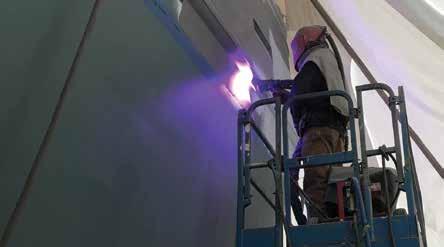

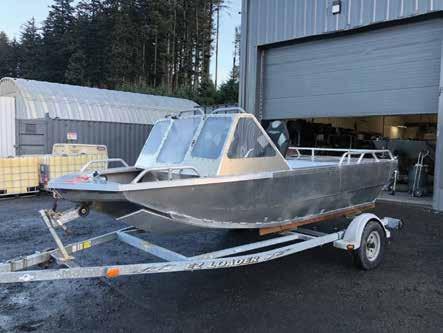
Curtis says building the business was the most difficult thing he’s ever done.
“It’s very demanding, but I enjoy the challenge,” he says. “I just solve problems. That’s all there is. People have problems, and I come up with solutions.”
He enjoys bringing together all the varied aspects of a job in a way that satisfies his clients. “I integrate our twelve divisions into a project that’s turn-key and in- house,” says Curtis.
Sam Heitzenroder, the port engineer who oversees thirty vessels at Trident Seafoods in Seattle, Washington, is a fan.
“He’s the best of them,” says Heitzenroder. “I love working with him. He’s always fair, always treats us good. He’s gone out of his way, always willing to go that extra... Of all the dealings and vendors in the industry, he’s the most professional person I have dealt with. Is he expensive? Well, you get what you pay for, and he’s the best.”
Known for supporting the Kodiak community, Highmark Marine provided free drive-in movies at the local fairground during the COVID-19 pandemic. Curtis has also organized a clean-up for shore debris and arranged for certified divers to scour the harbor depths.
“It’s about making a difference in my community and the lives of my employees with excellent salaries and full benefits,” he says. “It’s not about me.”
Away from work, Curtis prefers the simple life. “I have a remote cabin, and that ’s enough for me.”








By Vanessa Orr

Th e COVID-19 pandemic brought a lot of changes to the way people do business, especially with staff working remotely. Zoom and Microsoft Teams replaced meetings that could no longer be held in-person, and livestreaming services became the go-to for churches, schools, corporate meetings, and more.
As the use of these platforms grew, so did the need for skilled experts to help set up these events, which can involve numerous
locations, hundreds of people, multiple cameras, complete graphics packages, and more. Companies that provide this specialized event coverage must stay on top of the latest innovations to provide the most seamless, professional services to their clients.
“Though I’ve offered streaming services since 2004, in 2020 everything really exploded in virtual, hybrid, live, and distance meetings,” says Jonathan Butzke, owner of Talking Circle Media,
based in Anchorage. “Prior to that, most people were only using Skype and FaceTime, as well as audio conferencing.”
Those apps fell out of favor the moment COVID-19 sequestered workers in their home offices.
“I used to have to use three satellite shops to broadcast from Greenland to Alaska,” Butzke adds.
“Now I just whip out Zoom, connect to the application of choice, and we’re good to go. It’s funny how it’s so different now.”

According to Jonathan Huff, owner and CEO of Alaska Universal Productions, technology spurred by COVID-19 has changed how businesses choose to communicate.
“Back in the day, we did teleconferences with a big speakerphone sitting in the center of a table; now you just log onto Zoom and you’re good to go,” he says. “Before, to do a conference call with forty people calling in, I would call the local phone company
“What’s surprising to me is that, even when people started meeting in-person again, business didn’t slow down… The last two or three years have been my busiest.”
Jonathan Butzke, Owner, Talking Circle Media


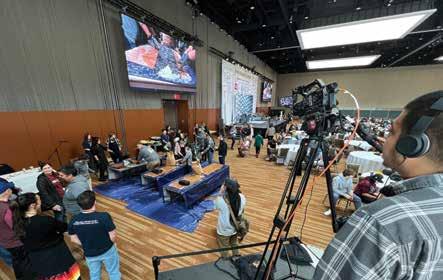
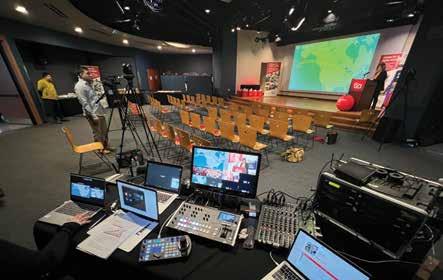

and set up a phone bridge that cost a couple thousand dollars. That’s no longer a thing.”
While many companies have become proficient at using Zoom and Teams for smaller meetings, they often need to hire an expert to set up livestreaming or broadcast events. For instance, Talking Circle Media had been broadcasting the Alaska Federation of Natives (AFN) Convention on television for twentynine years, but the event needed a new approach in 2020.
“Because the event was going to be all virtual, I had to figure out how to combine multiple Zoom meetings and multiple platforms all together into one feed without technical problems,” says Butzke. “I was at the Dena’ina [Civic and Convention] Center with the AFN staff, working on ten or twelve computers, combining all of the things.”
Five years later, the new approach is the normal approach.
“What’s surprising to me is that, even when people started meeting in-person again, business didn’t slow down,” Butzke says, noting that between February and March, he covered thirty meetings.
“The last two or three years have been my busiest.”
Huff also pivoted during COVID-19, such that his company is now one of the leading web stream companies in the state. Alaska Universal Productions provides everything from one-way webinars published on YouTube or other platforms to virtual meetings and in-person meetings that can be published through YouTube, Facebook, or on a private page. The company is also
the leading provider in Fairbanks for technical equipment for sound and video streaming.
“Even now, we still have clients struggle with setting up Zoom or Teams meetings; a one-on-one Zoom call is not a problem, but when holding a professional meeting in a ballroom or small conference room, they don’t understand how to do multiple cameras, get clean audio, or get people back in the room from remote locations without technical issues,” Huff explains. “That’s where we come in.”
Huff and a few investors recently opened 8 Star Events Center, a 26,000-square-foot facility for in-person meetings, concerts, performances, and more.
“We’ve run ethernet cable throughout the building to connect WiFi and high-speed internet, and the building is also wired with cameras and microphones for easy hybrid meetings,” he explains of the space that can hold approximately 900 people.
According to Michael Cook, founder of 49th Media, approximately 95 percent of his company’s business is livestreaming, putting events online for viewers who can’t attend in-person functions. These include livestreaming Anchorage Wolverines’ games, the crosscountry ski nationals, the Alaska Scottish Highland Games, and Alaska Fighting Championships. He works with streaming partners like North American Hockey League and creates live pay-for-view events.
“I’ve got a crew of cameramen, and I do the producing—just like you would see for an NFL football game,” he explains. “The equipment is identical, and we do graphics and commercials, producing entire shows.”
Once the pandemic hit, Cook says that businesses began to realize that livestreaming provided potential moneymaking opportunities that they had overlooked before.
“When they started doing everything online, the business model for live events changed,” he says. “Even now, when things are back to ‘normal’ and people can go to events in person, we still reach out to the people who didn’t go so they can be a part of it.”
Cook, who used to do post-video production, says that COVID-19


helped to really kick off his livestreaming business, which he has been building for the past four years. “The great thing about live streaming is that once you hit ‘End,’ that’s their product. You go on to the next event. It’s a lot easier than postproduction, and I love making shows that look like those on ESPN and NFL TV. It’s rewarding.”
While most of Butzke’s clients are still using the same audio and video platforms that became popular during the pandemic, he is adapting, learning, and using new equipment all the time. He spends much of his time educating clients about the technology available—transitioning them from using mobile hotspots, for example, to mobile Starlink or moving
them from audio conferencing to Teams or other virtual platforms.
Even with this knowledge, there are some drawbacks. When the North Slope and Southeast each experienced internet outages due to severed subsea cables, Butzke had to provide backup fiber and internet services to clients. In some places, internet infrastructure isn’t capable of handling clients’ needs.
“This is our biggest Achilles’ heel,” he says of Alaska’s telecommunication capabilities. “If you don’t have any internet or good internet, you’re out of luck.”
Butzke researches new equipment and types of software before his clients need it, and he tests it with clients to compare it to what they traditionally use. This isn’t always easy; he recently hauled five cases
of equipment, including new microphones, on a small, four-seat bush plane to a remote Regional Advisory Committee meeting, and he experimented with a new eightcamera system to cover the Kivgiq celebration in Utqiaġvik.
“I’m trying to lighten the load by using 360° cameras and Bluetooth; whatever makes it simpler and lighter,” he says. “It isn’t easy to test stuff in Alaska, so I’ve worked out a deal with my vendors to send the equipment back if it doesn’t work out.”
According to Huff, Alaska Universal Productions sets itself apart with a commitment to redundancy, setting up multiple video switchers and multiple computers. The company also has someone in their home office logging in to meetings and


conferences to ensure that the video and audio are working; when needed, it will set up a troubleshooting phone number in-house for clients in case someone needs assistance trying to view the event.
With a laugh, Huff says, “It’s technology, so at some point, something is going to fail.”
“Technology is the only downfall to this business,” agrees Cook, a
disabled veteran who outfitted a broadcast trailer with equipment provided through a grant from the Semper Fi & America’s Fund. “One of the biggest issues I have is that people want to stream, but Alaska is so vast that internet is a huge issue.”
High-quality video conferencing requires speed and capacity that some locations simply don’t have yet. “Many areas don’t have good
Internet that is fast enough for highend video,” Cook says. “I’ve had to come up with solutions, including using a special router that combines multiple internet connections to make one fast one.”
The cost of producing meetings, livestreams, broadcast productions, and more can vary greatly, depending
“A one-on-one Zoom call is not a problem, but when holding a professional meeting in a ballroom or small conference room, they don’t understand how to do multiple cameras, get clean audio, or get people back in the room from remote locations without technical issues… That’s where we come in.”

niversal Productions
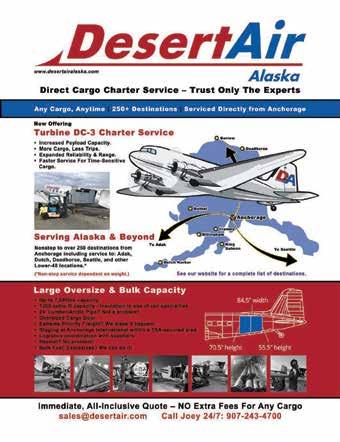
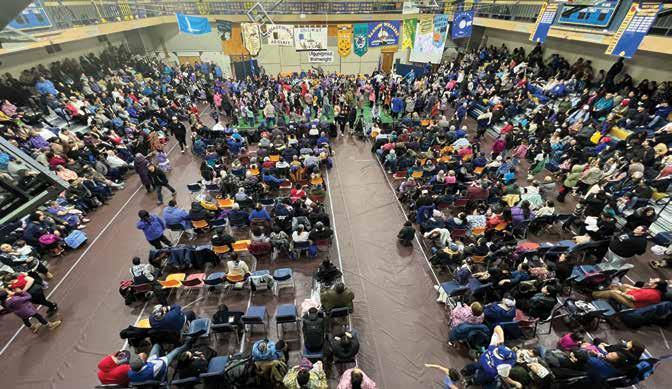
on how many people and locations will be involved, how long the project will last, and whether specific software is required. Add in the need for travel, and projects get even more expensive, as travel and lodging for a more remote project could make up about 55 percent of the fee, Butzke says.
He advises clients to look for people with experience working in Alaska and those who have knowledge of different streaming methods.
“I’ve had clients come to me because what they got from another company wasn’t what they expected; they wanted a private stream, and then they see their meeting streaming on YouTube for everyone to see,” he explains.
Butzke notes that, while YouTube is free, he pays $10,000 a year for Vimeo livestream software that allows users to broadcast live video content, offering tools for virtual events, webinars,
and more, while also providing options for audience engagement and archiving. He also has three Zoom licenses to accommodate larger groups of clients.
“Companies need to look for someone who understands how to meet their goals at the lowest cost,” he says.
Cook adds that pricing varies on how much companies want to put into livestreams; an hourly rate for three cameramen for a four-hour meeting will cost significantly less than the same number of personnel for a three day conference or festival. A graphics package would add even more to the total, and streams can even include live drone shots, which require an additional licensing fee.
“It’s kind of an à la carte situation,” he says, noting that he has invested close to $50,000 in gear to provide the most professional product available. “If they want, we can go all out.”
Going all out with graphics and drones might seem excessive for certain virtual events, but for others the sizzle is part of the steak. Keeping the livestream interesting is especially important to keep the audience engaged.
“You don’t just want people to jump on to watch their kid for five minutes or to see where the game stands,” Cook explains. “Engagement is really important when it comes to livestreams as sponsors are paying for it; if you can keep people on the stream for up to sixty minutes per view, it guarantees that an advertiser’s commercial will be seen two to three time s during the event.”
That’s fine for mixed martial arts bouts or hockey games, but does flashy engagement apply to corporate conferences?
“Businesses can monetize their content if they do it right,” Cook
suggests, noting that his company has access to advertising structures through Hulu and Disney+ that can put local ads on their channels’ streaming services to promote a company’s event. “You can grow your business, depending on the level of professionalism you put into it.”
It’s important to note that while price is important, there are other considerations for companies deciding whether to host in-person meetings, hybrid meetings, or completely virtual events.
“Hybrid and virtual events cost more, for sure, because you’re having to add another level of technical abilities,” says Huff, “and there are some headaches for clients trying to figure out how to facilitate it. It’s not the same as just holding an in-person meeting.”
But the setup can be worth the cost. “It does enable those who couldn’t come to something like an ANCSA [Alaska Native Claims Settlement Act] meeting the chance to attend, including elders who can’t travel or those who live in remote villages who can’t afford the cost of flying in,” Huff adds. “A presenter doesn’t have to leave Washington, DC to fly to Alaska for a one-hour presentation.”
Huff has seen hybrid meetings becoming more popular as people are able to gather in one place again. “People have missed the networking and the camaraderie,” he says. “It’s a much different feel when you’re there in person. We’ve been getting away from Zoom-only meetings and more into hybrid events because people have missed seeing other people.”




By Terri Marshall

Li ke a cat hesitating at the front door, there are plans in the works for liquified natural gas (LNG) to both come in and head out of the 49th State. Exporting gas from the North Slope has been on the drawing board since before the Trans Alaska Pipeline System started carrying oil, and Cook Inlet gas sailed overseas starting in 1969 from
the Kenai LNG terminal, one of the first of its kind in the country. Those shipments to Japan halted in 2015 when local demand for the resource impinged on the inlet’s supply.
Importing LNG to Cook Inlet is the fastest way to satisfy Southcentral energy demand, yet development continues on the Alaska LNG pipeline from the North Slope, with an eye
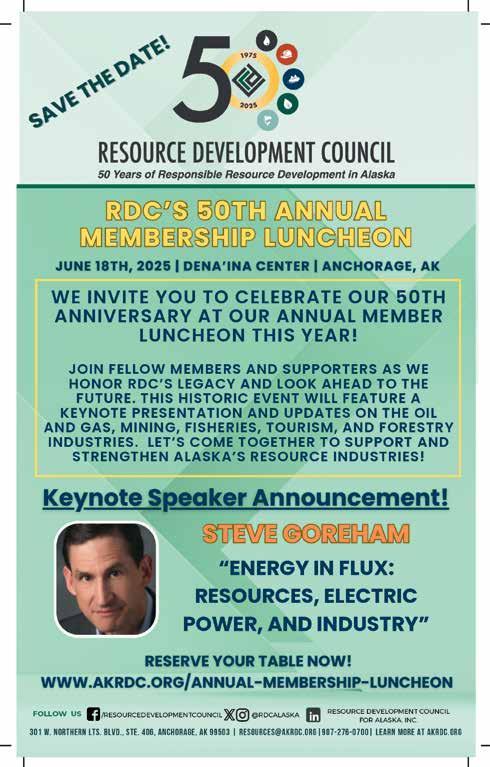
“The
Alaska LNG pipeline will deliver reliable, affordable, low-emissions energy and uniquely provide billions of dollars in economic benefits for Alaskans. Building the Alaska LNG pipeline also strategically positions Alaska to increase the energy security of our Pacific allies by derisking construction of the other Alaska LNG components that will generate and commercially export LNG.”
toward exports. Fortunately, local demand could make the case for export infrastructure in the long term.
Although export has long been the main goal of North Slope gasline proposals, in-state use of the resource has played a supporting role in most plans through the years.
The Alaska Gasline Development Corporation (AGDC) has plans for an Alaska LNG pipeline that would tap natural gas from the Point Thomson Unit and Prudhoe Bay Unit for in-state distribution and for export. The US Department of Energy conditionally approved an application to export up to 20 million tons of Alaska-produced LNG per year for thirty years.
The Alaska LNG integrated gas infrastructure project comprises three main components: a gas treatment plant at Prudhoe Bay, an 800-mile pipeline to Southcentral with off-takes for in-state use, and a natural gas liquefaction plant in Nikiski. To date, more than $600 million has been invested in project engineering and design.
A dozen years since the state established AGDC to bring North Slope gas to market, this winter saw a whirlwind of new developments.
In January, AGDC selected Texasbased Glenfarne Group to take the reigns of the $44 billion Alaska LNG Project. Founded in 2011, Glenfarne develops, owns, and operates energy infrastructure, such as the Texas LNG Project slated to export gas by 2028 from Brownsville, Texas.
The selection followed a resolution in December from the Alaska Industrial Development and Export Authority (AIDEA) supporting the development of Alaska LNG Phase 1, the in-state pipeline portion. The resolution authorizes AIDEA to negotiate and sign a letter of credit to backstop front-end engineering and design (FEED) for the Alaska LNG pipeline. The letter of credit will allow AGDC to unlock up to $50 million in private investment to move the Alaska LNG pipeline through FEED.
AGDC welcomed the AIDEA resolution with this statement: “The State of Alaska is facing a looming energy crisis, and Alaska LNG represents the best long-term energy solution for our state. The Alaska LNG pipeline will deliver reliable, affordable, low-emissions energy and provide billions of dollars in economic benefits for Alaskans. Building the Alaska LNG pipeline also strategically positions Alaska
to increase the energy security of our Pacific allies by derisking construction of the other Alaska LNG components that will generate and commercially export LNG.”
The AIDEA resolution followed a memo in November 2024 from Governor Mike Dunleavy to the Alaska Legislature providing analysis of the looming Cook Inlet energy shortfall. The memo noted three key findings from an independent analysis by energy analytics firm Wood Mackenzie.
The first finding is that Alaska LNG Phase 1 economics are superior to or competitive with alternatives. The analysis figures that Alaska LNG Phase 1 can predictably deliver natural gas in a price range between $8.97 to $12.80 per million British thermal units (mmbtu). Alaska LNG Phase 1 is not subject to market volatility, it adds. However, imported LNG is difficult to reliably price because of market volatility. Wood Mackenzie conservatively estimates prices between $10.21 to $13.72/mmbtu, excluding the additional costs of required onshore infrastructure, estimated to be in the hundreds of millions of dollars,
and regulatory and permitting uncertainty, which will also drive costs higher for imports.
The second finding is that Alaska LNG will dramatically lower longterm Alaska energy prices. The analysis anticipates that Alaska gas prices will drop to $2.23/mmbtu when the export components are complete and full volumes are achieved. For comparison, the current price of Cook Inlet gas is approximately $8.69/mmbtu.
Finally, Wood MacKenzie forecasts that Alaska LNG Phase 1 will uniquely deliver up to $16 billion in additional Alaska economic benefits that won’t occur with other options. These benefits include construction capital expenditures, jobs, tax and royalty state revenue, consumer savings from lower gas prices, business and economic growth, and improved Fairbanks health outcomes and investment.
All those benefits would accrue before Alaska LNG Phase 2, which includes infrastructure components to convert gas to LNG and export it. Export it where?
On March 20, Taiwan’s stateowned petroleum company, CPC Corporation, signed an agreement with AGDC to buy LNG and invest in the Alaska LNG project. A week later, Glenfarne Group formally agreed to lead the project, taking a threequarters ownership stake.
The Alaska LNG Project was first authorized to deliver North Slope natural gas to US allies across the Pacific by the Trump administration in 2020, and it was reauthorized by the
Biden administration in 2022 as the only federally permitted LNG export facility on the US West Coast.
Upon returning to office, President Donald Trump included the project in a January 20, 2025, executive order titled “Unleashing Alaska’s Extraordinary Resource Potential.” It states that the policy of the United States is to “prioritize the development
of Alaska’s liquified natural gas (LNG) potential, including the sale and transportation of Alaskan LNG to other regions of the United States and allied nations within the Pacific region.” The executive order further directs the heads of all executive departments and agencies to take all necessary steps to “prioritize the development of Alaska’s liquified
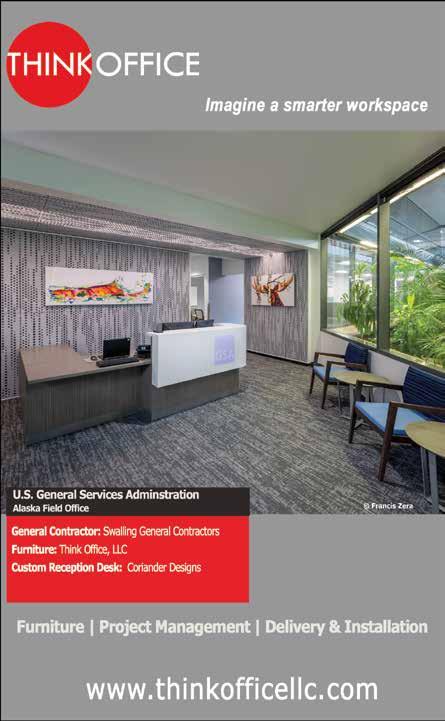
“We believe the Kenai LNG terminal offers the quickest and lowestcost solution to bring additional natural gas to Southcentral Alaska and beyond.”
Bruce Jackman Refinery General Manager Marathon Petroleum Corporation
natural gas (LNG) potential, including the sale and transportation of Alaska LNG Project, giving due consideration to the economic and national security benefits associated with such development.”
In response, AGDC President Frank Richards said, “Alaska LNG is broadly supported at federal, state, and local levels because of this project’s significant strategic, economic, and environmental benefits. Alaska LNG will annually strengthen the US balance of trade by approximately $10 billion, create thousands of jobs, and eliminate up to 2.3 billion tons of carbon emissions over the project’s thirty-year authorization.”
The administration’s cabinet nominees also advocated for Alaska LNG during confirmation hearing exchanges with Alaska Senator
Lisa Murkowski. “We need the help to unleash the opportunities that we have to not only allow Alaska to have that energy independence that we so rightfully should have but also to be able to help not only our country but our friends and allies,” said Murkowski.
However, Alaska’s energy independence will take time. The Wood MacKenzie analysis is based on construction starting in 2026 and Alaska LNG Phase 1 starting operations in 2031. That would be just in time for North Slope natural gas to stave off the depletion of Cook Inlet resources anticipated in the 2030s, but local energy utilities are scrambling for shorter-term solutions.
for the
• Candidate Sourcing & Staffing for Office & Field Positions
• Travel, Billeting, & Logistics
• Safety Services & Training
• Emergency Response & Rescue







The idled export terminal at Nikiski holds the key. Harvest Alaska, an affiliate of Hilcorp, entered an agreement with the terminal’s owner, Marathon Petroleum Corporation, to acquire the terminal and reconfigure it for LNG imports.
The project, in cooperation with Chugach Electric Association, aims to facilitate prompt delivery of additional natural gas supplies to Southcentral by 2026, with full-scale operations anticipated to commence in 2028.
“Providing our members with safe, reliable, and affordable electric service is core to our values and mission. We are pleased to have a potential solution to meet the gas needs of our members and at the right time,” says Chugach CEO Arthur Miller. “We’ve been looking
at options to fill the gap left by our expiring Hilcorp contract, which ends on March 31, 2028. This is a great opportunity to work with partners who have extensive experience and knowledge of gas operations in Alaska. We look forward to ongoing discussions and analysis with Harvest Alaska as they progress the front-end engineering and design study over the n ext several months.”
Under the agreement, Harvest will possess, develop, and manage the LNG terminal and infrastructure, which will enable Chugach, Marathon, and other Railbelt customers to secure additional natural gas supplies.
“We believe the Kenai LNG terminal offers the quickest and lowestcost solution to bring additional
natural gas to Southcentral Alaska and beyond,” says Bruce Jackman, vice president of Marathon's Kenai Refinery, located across the highway from the terminal. “Our Kenai refinery employees work around the clock to provide gasoline, diesel, and jet fuel to their fellow Alaskans, and a reliable supply of natural gas is critical to the refinery’s operations. We’re excited about this partnership with Harvest and Chugach to work toward bringing new natural gas to the region.”
Meanwhile, while taking on the Alaska LNG project, Glenfarne Group has a separate agreement with ENSTAR Natural Gas to advance import infrastructure in the same facility.
The metaphorical cat has made its choice: first in, then out. Alaskans are waiting at the threshold.



By Terri Marshall

Wa tersheds are areas that share a common drainage for rain and snow. Viewsheds are the line-of-sight from a particular point encompassing all the visible scenery. By analogy, energysheds are the totality of energy (usually electricity) produced and consumed within an area.
The Alaska Energyshed project is an initiative to identify and secure funding for clean energy projects in Northwest and Southeast Alaska by 2026. Twelve Alaska communities were chosen to participate in the project, which is backed by the US Department of Energy (DOE) and supported by Launch Alaska, Southeast Conference, DeerStone Consulting, and the Alaska Municipal League.
“The Alaska Energyshed Project aims to identify and develop clean energy projects across the Northwest Arctic and Southeast Alaska with the intention of saving money, reducing energy costs, and improving environmental impacts that help these communities,” says Launch Alaska chief deployment officer Ottar Mobley. “We’re right at the mid-point of the project now, and the work that’s been done already included selecting the communities.”
Six of the selected communities are in the Northwest Arctic: Ambler, Buckland, Deering, Kotzebue, Selawik, and Shungnak. The remaining six are in Southeast Alaska: Angoon, Haines, Hoonah, Kake, Metlakatla, and Yakutat.
The overall goals of the project are to reduce local energy costs and improve local economies, to reduce environmental impacts while
“Our job is to document the high detail version of exactly what’s out there to determine what the current power system can support… We documented every power pole, every transformer, generators, and diesel engines.”
Jay Byam Founder and CEO Kartorium


Launch Alaska and Alaska Village Electric Cooperative helped bring a 225 kW solar array to Shungnak in 2022, funded by the US Department of Agriculture and the Northwest Arctic Borough. In its first year, the microgrid and its battery storage system were credited with saving more than 15,000 gallons of diesel fuel.
“Over this past fall and winter, we’ve taken that data and digital tools that basically create digital analogs for these communities and their infrastructure with the eventual purpose of using those tools to identify specific projects that basically have the most bang for the buck.”
Ottar Mobley, Chief Deployment Of ficer, Launch Alaska
increasing system reliability, and to develop a scalable framework for aggregating and securing funding for other projects. The project involves capturing a baseline inventory of power infrastructure in a central database and 3D model, identifying and designing sustainable and/or renewable energy projects, and applying lessons learned to other communities.
Launch Alaska is a nonprofit started in 2016 to accelerate energy, transportation, and industrial technologies. Often it functions
like a source of venture capital via its Tech Deployment Track, which cultivate innovators who might join the Launch Alaska Portfolio for ongoing support.
Alaska Energyshed provides an opportunity to connect portfolio partners with community needs.
Launch Alaska’s primary partner on this initiative is the Alaska Municipal League, a membership organization for 165 local governments. “For the communities in the Northwest Arctic, we worked with both the boroughs and DeerStone Consulting, and then in Southeast Alaska we worked with Southeast Conference to present the opportunity to all
the communities,” the league’s executive director, Nils Andreassen, explains. “It was a group approach to identify which communities had the right makeup and opportunity for improvements where we could make the most impact.”
Making sure tools are in place to ensure energy affordability, reliability, and security are the overall goals of Alaska Energyshed. “Those are all goals that are consistent with outcomes from the governor's energy security task force,” says Andreassen. “It could be available to other communities in the future as a process that gets you to a project that's fundable. I also think
there's a lot to be said for how we've structured some of the stakeholder engagement. We're working with local tribal governments and utilities to move these projects forward. There's a lot to be said for the collaborative environment that's been created as a result.”
Beyond serving the twelve selected communities, Alaska Energyshed is modeling a process for long-term change. “By packaging individual projects into a larger, unified effort, we can reduce development costs, increase investor interest, leverage diverse resource, and build a broadly replicable process to support clean energy development across Alaska,” says Launch Alaska CEO Isaac Vanderburg. “We’re excited to work with so many Alaska communities dedicated to creating more sustainable energy systems, and we look forward to the economic momentum this initiative can bring to our state.”
The inventory is already underway. “We had a fieldwork effort this last summer in 2024 that sent teams out into these communities to record existing asset and energy asset data,” explains Mobley. “Primarily, our teams went out into the communities and did three dimensional scans of all the assets that make up the energy systems for these communities. That also included drone flights to get aerial imagery to build a database that included all of the assets.”
Data collection was spearheaded by Anchorage-based Kartorium, a software development firm that



of
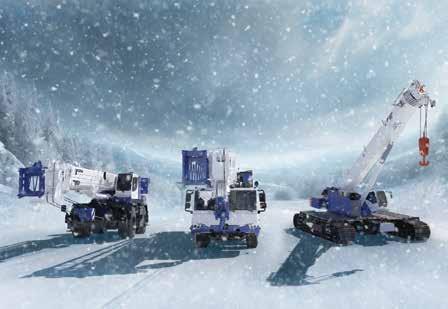
Lennon Crane is an industry leader in providing Tadano cranes and service for cold weather applications. Their Tadano machines are designed and built for challenging climates, and Lennon Crane can be your successful partner for increasing cold weather “uptime” and getting the job done.


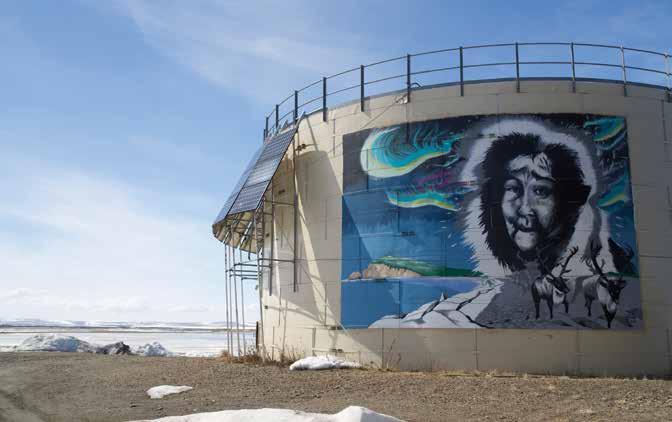
“So far, we've completed the early data and information gathering for review. Then the next stage is to go through an economic analysis to think about where the economics of the projects stand… It’s all about what’s available and what can be locally sourced within that community.”
Nils Andreassen, Executive Director, Ala ska Municipal League
specializes in “digital twins”— interactive virtual representations of physical assets, in its simplest form.
“Essentially, there was a great need for asset documentation, specifically for the power systems in remote Alaska. If there is documentation, it is typically really old, but the vast majority of the communities have no documentation at all,” explains Kartorium founder and CEO Jay Byam. “Our job is to document the
high-detail version of exactly what’s out there to determine what the current power system can support.”
The Kartorium team scanned the communities with drones. “We documented every power pole, every transformer, generators, and diesel engines,” Byam says. “We used our images as base data for all of the maps.”
The data collection was highly successful. “Over this past fall and winter, we’ve taken that data
and digital tools that basically create digital analogs for these communities and their infrastructure with the eventual purpose of using those tools to identify specific projects that basically have the most bang for the buck,” explains Mobley. “Communities can invest or spearhead projects that have the greatest potential impact.”
Just having the data is already a win for Alaska Energyshed. Byam believes the fieldwork
has value even if no new energy infrastructure is built. “Whether outside projects get funded or not is kind of secondary in this case,” he says. “The communities now have modern 3D documentation for all their assets, which can be used for remote training by meeting with utilities and showing the results of these projects.”
Kartorium continues to host the data, with recommended projects viewable on the platform. Byam says, “As the team goes forward and gathers more recommendations, all of the updated data will also be viewable.”
The information also provides insights as to where there are opportunities to partner with other communities to build interties to share energy resources.
The choice of clean energy projects for each community will be informed by an analysis process.
“It’s really dependent on the makeup of the community, what resources they have at their disposal, what their existing technologies look like, and the condition of their assets,” says Andreassen. “Each community is really looking at all of those factors. The team goes through that process with the community to get to a place where we can evaluate what those investment opportunities look like. So far, we've completed the early data and information gathering for review. Then the next stage is to go through an economic analysis to think about where the economics of the projects stand. Decisions to be
“The Northwest Arctic is going to look very different than Southeast Alaska. Each community is going to be looking at available resources and how they plug into their respective base loads.”
Nils Andreassen, Executive Director, Ala ska Municipal League



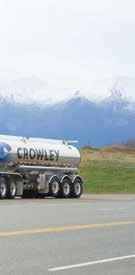

With terminals and delivery services spanning the state, and a full range of quality fuels, we carry petroleum products and services that carry Alaska forward.
Diesel | Gasoline | Lubricants
Propane | Heating Fuel | Aviation Fuels
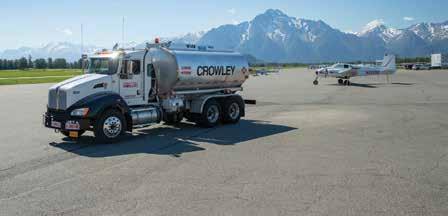


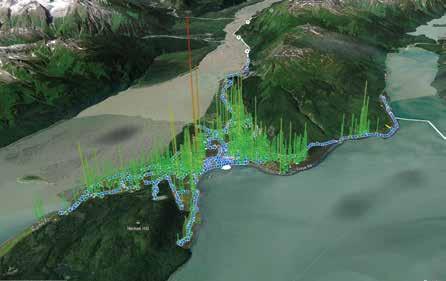
considered are the potential return on private investment or would it make more sense for a public sector investment to occur.”
The type of clean energy projects is community specific. “It’s all about what’s available and what can be locally sourced within that community,” says Andreassen. “The Northwest Arctic is going to look very different than Southeast Alaska. Each community is going to be looking at available resources and how they plug into their respective base loads. For example, in the Northwest Arctic communities, that base load is probably coming from diesel generators. There’s a lot of interest in the Arctic for a large project for heat pumps; there’s also a lot of solar and wind energy possibilities. In Southeast Alaska, hydro energy is a resource that many communities have available, but it’s really the combination of these sources that make up a viable project.”
Launch Alaska partners are responsible for the community engagement part of the work. Once that’s complete, Launch Alaska will work with the National Renewable Energy Laboratory to analyze all the data. Upon completion they will produce new data that suggests which projects can be done most efficiently.
Launch Alaska has a goal of funding a minimum of three projects, totaling at least $10 million, through a mix of private and public dollars. Once those projects are plugged in, the Energyshed will stand as a model for other communities to follow.




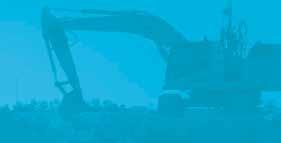



By Vanessa Orr
Mu ltiple studies have found that pets help lower stress, so what better place to have them than in the office? According to CO , the US Chamber of Commerce newsletter, pet-friendly workplaces are becoming increasingly popular among employers and employees alike.
CO cites a recent LiveCareer study reporting that 94 percent of respondents were supportive of having Fido or Fluffy in the office, with 52 percent reporting that “pet-friendly benefits and policies are important when considering an employer.” But while it may seem like a great idea to invite a furry companion to come to work, it’s important to note that not all workplace animals are the same.
By law, a disabled person’s service or alert animal is allowed to be at that person’s workplace, though there are some exceptions to the rule. Emotional support animals are not the same, and do not have the same protections. And cuddly-wuddly fur babies? Not covered by the law at all.
So which four-legged friends are appropriate in the office? And who is responsible if something goes wrong?
According to Rob Corbisier, executive director for the Alaska State Commission on Human Rights, service or alert animals required because of a person’s disability and trained to do something related to that disability receive certain protections under the law.
“You need to recognize that you cannot encroach on the rights of others just because you like to have your best buddy sitting under your desk keeping your toes warm.”







“As an employer, you have to figure out how to reasonably accommodate both [a seeing-eye dog and an employee with an allergy]. That may include having the dog there when the allergic employee isn’t present or having the allergic employee wear a mask when the service animal is there.”
Rob Corbisier Executive Director Alaska State Commis sion on Human Rights
“Generally, employers must allow service and alert animals in the workplace as a reasonable accommodation for the employee’s disability,” he explains. “There are some exceptions to that, however, including if the animal poses a direct threat to whatever is going on in that setting.”
The setting is key, Corbisier explains. “For example, if a patient is going in for surgery, the service animal can be excluded because it poses a threat to the patient who needs the sterile operating environment. Other circumstances may include food handling situations, such as in restaurant kitchens, or if the employer is providing a service where the service animal would inherently interfere with the business operation like a dog mushing tour,” he says. “Service and alert animals may also be excluded if the animal is unruly—barking uncontrollably or not housebroken.”
Service and alert animals are also allowed in places of public accommodation. Under Alaska statutes, because the service animal is related to a person’s disability, it must be allowed in public places; barring the animal can be considered a potentially discriminatory act against the owner/handler. Corbisier notes that, under state and federal law, service animals can only be dogs or miniature horses (such as those that pull wheelchairs).
“It has to be one of those two things,” he says with a laugh. “There are no service cats or parakeets.”
Emotional support animals do not receive the same level of legal protection
as service and alert animals, and they are only protected in housing situations. Under the federal Fair Housing Act, a person with a qualifying disability, such as posttraumatic stress disorder, who has been prescribed a support animal by a medical provider can have that animal in their home, even if the landlord does not allow pets and even if that animal has no special training.
“An emotional support animal is not considered a pet for the purposes of housing, and the person is able to have that animal in a housing unit regardless of landlord restrictions,” says Corbisier, adding that his office has seen cases involving homeowners associations trying to enforce no-pet policies.

Therapy animals, such as those that visit children in hospitals, do not have any legal protections, as their role is not related to any kind of disability. This also applies to house pets, which means that the only way they are getting into the workplace is with the permission of the employer.
A pet-friendly work environment can provide a host of potential benefits for employees and employers, but it also creates liabilities. On the plus side, animals have been shown to lower stress, which can reduce employee burnout and stress-related health conditions. Scientific research shows that pets improve people’s moods, provide social support, increase quality of life, lower blood
pressure, elevate oxytocin levels in the brain, and even lower the ris k of a heart attack.
Animals in the office may also provide better work-life balance and make it easier for employees who feel guilt or experience logistical challenges leaving their pets at home for extended periods. Pets also increase employee morale, and they can encourage employee bonding and break the ice among coworkers, improving relationships and facilitating collaboration.
From an employer’s point of view, allowing animals in the office can help attract new employees. According to Hushoffice, 66 percent of human resource personnel say interviewees ask about pets, and half of employees say pet-friendly perks could convince them to take an offer. Moreover, 46 percent say they would be more likely to recommend their employer if pets were allowed in the office.
However, there are some negatives to pet-friendly office policies. What if a dog bites someone or has an accident in the office? What if other employees are allergic or just don’t like animals? Other concerns include employees’ pets fighting with each other or whether a company’s lease even allows animals in a building that it does not own.
In the case of a service animal, employers need to find ways to work around prospective issues to legally accommodate all employees.
“A classic example is a blind employee who needs their trained seeing-eye dog, but another employee has an allergy,” says Corbisier. “As an employer, you have www.akbizmag.com




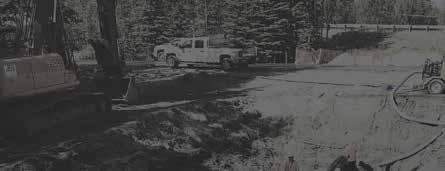



















Able to mobilize for quick action needed situations, our team can tackle any public or private project. From airports to schools, to mines and water treatment, choose RESPEC as your integrated solutions provider.
Engineers. Planners. Surveyors... and everything in between.








“If the dog is panting, pacing, shaking, whining, or obsessively chewing on objects at work or seems tired and fatigued after you get home, the workplace may not be conducive to your dog’s health.”
to figure out how to reasonably accommodate both of those people. That may include having the dog there when the allergic employee isn’t present or having the allergic employee wear a mask when the service animal is there.”
For those employers considering a pet-friendly office, it’s best to survey employees first regarding pet allergies and possibly set aside a single room or specific space for pets to limit allergen spread. A pet policy should also be put into place regarding food and bathroom breaks for pets, limiting the number of animals in the office daily, responsibilities concerning petrelated injuries, and ways to reduce potential disruptions. Employers might also want to consider retaining insurance or having employees sign a waiver to protect the company against legal liability.
Preparing a workplace for a pet is one thing, but the pet should be prepared for the workplace environment as well.
Michele Forto of Alaska Dog Works and Dog Works Radio has decades of experience training therapy dogs to work in healthcare offices, schools, churches, and more. She advises her clients who take dogs to work to make sure that their animals meet the minimum American Kennel Club standard of “Canine Good Citizen” before allowing them into the workplace. “This program, which has been around since
the 1980s, encourages people to make sure that their dogs are polite; have proper greeting behavior; do not become upset, agitated, or overly excited at the sight of another dog; and that the owner knows how to police these and other behaviors,” she explains of the ten-step training. “It doesn’t matter whether it’s a pet, emotional support, or therapy dog; they should all me et these standards.”
She adds the program disqualifies dogs that exhibit barking, baring of teeth, and biting, as are dogs that defecate in public spaces while being tested. “If a dog can’t handle these minimum things, they cannot handle being in an office,” she says. “If a dog is under six months old, which is the base age to do this testing, they should also not be in the workplace, as they do not have all of their shots and are probably not comple tely potty trained.”

She notes that employees are not only responsible for the care and control of their dogs in the office but for the safety of anyone who encounters their dog surrounding the job site, even in the parking lot. She adds that not every working environment is conducive to having dogs onsite, as there may be health ramifications for both the animal and other employees.
“People usually think of the food service environment, but I also have clients who work in labs, where there can be cross-contamination by animal dander, and in the gas and oil industry, where static electricity from a dog’s coat can be problematic. It’s also
not good for animals to be around hazardous materials,” she explains.
While dogs have been shown to reduce employee stress in the workplace, some dogs become more stressed in certain environments, and it’s important to monitor their health to ensure that they are comfortable in an office or work setting.
“If the dog is panting, pacing, shaking, whining, or obsessively chewing on objects at work or seems tired and fatigued after you get home, the workplace may not be conducive to your dog’s health,” says Forto.
She also believes that, before bringing a dog into the office, the idea should be discussed in a team meeting, allowing everyone to weigh in on the pros and cons of having animals at work.
“Should the pet owners all do training together so that their dogs are familiar with each other? If someone in the office is allergic to dogs, how do you make them feel not left out?” she asks. “You need to recognize that you cannot encroach on the rights of others just because you like to have your best buddy sitting under your desk keeping your toes warm.”
As enticing as pet-friendly perks might be, some animals are better off at home. “Pets are wonderful additions to our lives, but they also help us decompress when we leave the work environment, and sometimes that’s the best thing to come home to after a hard day,” Forto says. “Sometimes bringing your dog to work is not always the best therapy for you.”





By Brian Walch
Astory: In the spring of 1968, a twenty-two-story tower called Ronan Point opened. It was built using a quick, economical construction method called “large panel system building” that prioritized speed and cost over integrity.
On the morning of May 16, 1968, resident Ivy Hodge went to make her morning tea. She lit the stove, which ignited a gas leak and caused an explosion. The walls of her apartment blew out, triggering a cascading collapse. Without the walls for support, the floors pancaked down to the ground floor, killing four people.
The disaster revealed how the building's connections were inadequate for real-world stresses. Like the structural components of a building, professional relationships create a structure of support and integrity for a successful career.
Many professionals overlook the importance of their network, treating it as an afterthought rather than an asset. But a well-built network provides support, opportunities, and resilience. However, without
attention and care, it becomes a liability, revealing its weaknesses when needed most.
Despite advances in technology and AI, relationships are more critical than ever in today’s workplace. Remote work and distributed teams are a reality of jobs today, and the opportunities for connections are diminished.
With weak professional networks, disruption from turnover and transitions is magnified. Trust degrades, leaders struggle, mistakes get repeated, and growth stagnates.
On the other hand, strong professional networks provide a foundation for success. When challenges come, resources are available, and employees are well supported as they transition into new roles. The increased trust and collaboration fuels innovation and growth.
Managers must evaluate the strength of their relationships before they need them. Just like an
engineer reviews a structure’s integrity, they must assess their network.
A strong professional network begins with a clear understanding of its breadth and depth. Just as an engineer carefully reviews a building’s plans before construction, professionals should assess their relationships in context and consider each connection’s position, influence, and long-term value.
The following approach can provide clarity on the strength of your network. It provides a practical way to visualize key connections and assess where to invest your efforts.
1. Open a spreadsheet and make a list of all your professional relationships. Consider each of the following categories and add all the people you can think of.
• Internal: Bosses, peers, colleagues, direct reports, and team members
• External: Clients, partners, and vendors
• Other: Mentors, coaches, and advisers
2. Now, add two columns to the sheet. The first column is how important the relationship is to your career. The second column is the current state of the relationship. Use the following list to classify the importance of the relationship.
• Critical = Essential for long-term success; directly impacts key goals
• Valuable = Important and beneficial but not absolutely essential
• Functional = Useful for day-to-day work but not a priority
• Unnecessary = No real impact or misaligned with goals
Use the following list to classify the current state of the relationship.
• Strong = Built on trust, mutual respect, and regular engagement
• Developing = Positive but not deeply established; has potential to grow
• Weak/Strained = Lacks trust, has inconsistent communication, or has tension
• Non-Existent = No real connection or engagement Once this spreadsheet has been completed, use it to assess your network and determine where you should invest.
• What stands out to you? Where is your network strongest? Where is it vulnerable?
• Who is taking too much of the load?
• Where are the gaps and weaknesses?
• Where could you expand your network?
• What other opportunities and risks do you notice?
Now that you’ve evaluated the structure, it’s time to take action. Relationships require deliberate effort, but trying to strengthen too many at once can be overwhelming and ineffective. Instead, focus your energy on a few key relationships where you can make a meaningful impact over the next three to six months.
Select three to five key relationships to prioritize. Then create a specific, actionable, and measurable goal for each one. Vague goals like “improve the relationship” won’t create real progress. Identify a desired outcome, the steps you’ll take, and how you’ll know if you ’re making progress.
Your goal might look like one of these.
• Build a stronger working relationship with my boss by initiating regular check-ins to align expectations and provide updates.
• Improve teamwork with a peer by identifying a project to work on together and requesting feedback at the end.
• Strengthen communication with my direct report by scheduling quarterly career development conversations.
• Become a trusted adviser to my client by understanding their challenges and scheduling a semi-annual strategic review conversation.
A goal provides direction, but relationships grow through consistent actions. Start by considering the other person’s perspective and the current state of the relationship. Then use the following guidelines to take meaningful steps to strengthen the connection.
• Adapt to Their Style: Some people prefer emails while others thrive in face-to-face conversations or casual check-ins. Engage in the way that works best for them.
• Be Helpful Without Expectation: Strong relationships are mutually beneficial, not transactional. Offer insights, support, or introductions without expecting anything in return.
• Be Consistent: Build trust by following through on your commitments. Don’t cancel or deprioritize appointments.
• Give Recognition: People respond to sincere appreciation. As Dale Carnegie wrote in How to Win Friends and Influence People, “Be hearty in your approbation and lavish in your praise.”
• Don’t Force It: Not every relationship will develop as you hope. Some will grow naturally, and others will fade over time. That’s normal. Lean in when there is alignment and mutual value.
As you put your plan into action, reflect on what’s working. If a strategy isn’t strengthening the relationship, adjust your approach or reassess the relationship.
Short-term efforts can create momentum, but even strong relationships can degrade over time. To ensure your network remains strong, it needs to be supported by a reliable system.
People are constantly evolving. They move through different life stages, change jobs, earn promotions, shift industries, and experience personal transitions. How relationships are managed during these changes can either strengthen a professional network or cause it to slowly fade.
To maintain a strong network, it’s essential to have a simple, reliable system. It doesn’t need to be complex or expensive to ensure connections stay active and meaningful over time. Here are some key ideas to consider when building your system.
• Use a Customer Relationship Manager (CRM): This can be a specialized application, but it doesn’t need to be.
A spreadsheet with columns for name, last contact, next contact, and notes is a CRM.
• Set reminders: If your CRM isn’t integrated into your task management process, then set reminders so you hold yourself accountable to ongoing relationship-building activities.
• Build relationship habits: Integrate relationshipbuilding activities into your regular routines so it doesn’t feel like extra work.
• Use your strengths: If you prefer one-to-one interactions, use those to build deeper connections. Prefer larger groups? Find events and gatherings to attend. Always look for opportunities to introduce people in your network to each other.
• Connect on LinkedIn: This is the simplest way to maintain long-term professional connections as people advance in their careers.
Buildings decline over time if they are not maintained. The same is true with your network. Implementing a simple system of tools and habits will ensure your professional network grows and provides support throughout your career.
Ronan Point’s collapse resulted from weak, neglected connections that could not withstand real-world stress. The same is true for professional relationships.
A network built quickly and carelessly won’t hold up when it is needed most. When relationships are deliberate, nurtured, and reinforced over time, they create stability and opportunity. They become the foundation that lets you accomplish more and the structure that allows you to weather challenges.
Here in Alaska, we rely on each other and know the value of relationships. The more we invest and build in our network, the further we will go as individuals, with our organizations, and in our communities.
Brian Walch is an executive coach, consultant, and speaker on leadership development. He uses his extensive experience in people and systems to provide tools and services to empower managers to lead themselves, their teams, and their organizations. Learn more at shiftfocus.com.








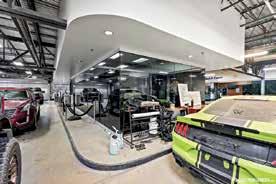






Two Alaska credit unions approaching their 75th anniversaries are joining forces. Credit Union 1 (CU1) intends to merge with Fairbanks-based MAC Federal Credit Union, uniting more than 112,000 members, more than $1.6 billion in assets, and nineteen branch locations.
Both CU1 and MAC were founded in 1952. MAC originally served military and civilian employees at Fort Wainwright; in 2021 and 2022, it extended beyond Fairbanks with new branches in Wasilla and Palmer. Meanwhile, CU1 opened branches in Wasilla and Skagway in April after the grand opening in February of a Kotzebue branch. cu1.org
Federal Credit Union
Regulatory approval puts Global Federal Credit Union on track to acquire Renton, Washingtonbased First Financial Northwest Bank by mid-year. Per the January 2024 purchase agreement, the transaction is structured as an allcash consideration of $231.2 million. First Financial Northwest will dissolve and distribute assets (including cash proceeds from the purchase) to stockholders, and customers will become members of Global. First Financial Northwest serves the Puget Sound region with fifteen full-service banking offices. Global, formerly Alaska USA Federal Credit Union, has grown by acquisitions to serve more than 750,000 members through
more than seventy branches across Alaska, Washington, Idaho, California, Arizona, and three US military installations in Italy.
globalcu.org
Anchorage-based hose and rigging supplier ARG Industrial is stretching farther south. A new branch location in Salem, Oregon, is the southernmost for the company, and the second in the Beaver State. ARG Industrial acquired a Portland location in 2021, when the employee-owned company was known as Alaska Rubber Group. The Salem location becomes the fourteenth in the organization. CEO and President Mike Mortensen says, “Salem is experiencing significant growth, and we feel like we're just the company to support the industries that are growing there.”
alaskarubbergroup.com
After pioneering hot springs as an Alaska resource, Chena Power is starting Alaska Geothermal Partners to help others tap into the Earth’s heat. The subsidiary arises from the stalled Makushin project in Unalaska, which Chena Power was developing jointly with Ounalashka Corporation and the Qawalanging Tribe until last year, when the city government cancelled a power purchase agreement while moving ahead without Chena Power. “When that project was put on hold, we decided to form a new company to reach out to communities or regions
about their geothermal potential and to share our expertise,” says David Matthews, business and contracts lead for Alaska Geothermal Partners. alaskageothermal.com
Providence Alaska is selling three extended-care homes in Anchorage to Ensign Group, a California-based network of assisted living facilities. The sale of Providence Horizon House, Providence Transitional Care Center, and Providence Extended Care is pending approval by state regulators. Providence Alaska cites rising costs, shortfalls in reimbursement, and a shortage of caregivers as reasons for the transfer. Ensign says the 328 employees, who care for 225 longterm patients, will be given job offers under the new ownership. providence.org
The Alaska Department of Health denied a Certificate of Need for Alaska Regional Hospital’s proposed emergency room in South Anchorage, a five-bed facility, questioning whether the location was necessary, whether it could provide sufficient care, and whether the finances penciled out. Alaska Regional, part of HCA Healthcare, applied last summer to build a $17.4 million facility at Huffman Road and Old Seward Highway. A year earlier, state officials rejected a proposed twelvebed facility. Alaska Regional has been
trying to expand emergency services in Anchorage since 2015. alaskaregional.com
The Sterling gas field north of Soldotna could return to production. Hilcorp is proposing two new wells and re-drilling an old one, but the company needs an exemption from the Alaska Oil and Gas Conservation Commission to drill within 1,500 feet of the property line. Hilcorp took two producing wells offline in 2014, a year after it acquired Sterling, first developed by Marathon Petroleum Corporation in 1962. The US Bureau of Land Management terminated Sterling as a unit in 2017. Meanwhile, to the south, Hilcorp is buying the North Fork natural gas unit, inland from Anchor Point, from Vision
Resources, a subsidiary of Louisianabased Gardes Holdings. The deal includes the North Fork Pipeline, but current owner Anchor Point Energy needs regulatory approval to revoke the pipe’s common carrier certificate. hilcorp.com
The Path to Prosperity business plan competition in Southeast selected two winners for 2024.
Spruce Root is awarding $20,000 prizes to help Sitkana and Ravens Nest Regalia grow their businesses. Lance McMullan of Juneau owns Sitkana, which manufactures hydrokinetic energy devices that generate electricity with underwater turbines. And the owner of Raven’s Nest Regalia and Art, Dzijúksuk Debra O’Gara of Petersburg, creates
Northwest Coast and Tlingit art, specializing in Ravenstail, Chilkat, and cedar bark weavings and regalia, robes, and vests. spruceroot.org
The James Beard Award recognizes the classiest eateries in the land, and the humble Lucky Wishbone near Downtown Anchorage qualifies. The chicken and burger restaurant was honored in February with a 2025 American Classics Award, one of six nationwide, to the surprise of co-owners Heidi Heinrich-Lervaag and Carolina Stacey. The longtime employees of the late George Brown, who founded the restaurant in 1955, plan to attend the awards ceremony in Chicago on June 16. luckywishbonealaska.com
Horse corrals are a specialty at Alaska Fence Manufacturing and Supply, yet the small crew also cranks out chain-link fence for construction sites, airports, event venues, and home security. The shop in Palmer has been around for more than thirty years, and the latest owner is Arnold Akers. He earned a “PhD” in “post-hole digging” growing up with his father’s fencing business in Kentucky. His wife, Debbie, helps run the shop that knits coils of wire into nearly a mile of fence per day. The company also assembles panels, preps packages for DIYers, and manufactures gates.
www.akbizmag.com
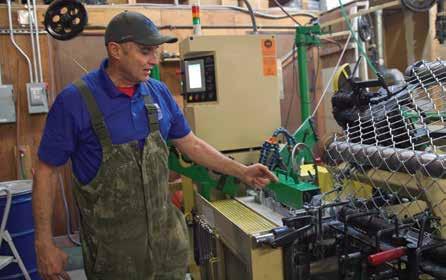

· The Alaska Native corporation for the Interior named a new leader for its tourism business lines.
As the President of Doyon Tourism, Jordan Sanford oversees investment opportunities in the visitor industry, especially transportation, lodging, and cultural tourism. Sanford has been with Doyon, Limited since 2010, most recently as general manager of Kantishna Roadhouse. Before that, she was general manager of Northern Laundry Services since 2016; she has led both subsidiaries jointly since 2021. Doyon’s tourism interests also include the Doyon Aramark Joint Venture and the Na-Dena` Joint Venture with Huna Totem Corporation.

· Cook Inlet Region, Inc. (CIRI) found a new President at one of its tribal affiliates. The corporation named Tabetha Toloff, a CIRI shareholder, to fill the position left vacant since October when Sarah Lukin stepped down after a year in the role; CIRI separated the president and CEO functions in 2023 upon the retirement of Sophie Minich, who held both positions for a decade. Toloff most recently served as chief administrative officer for Cook Inlet Tribal Council, one of CIRI’s three designated tribal organizations. In her new position, she spearheads stakeholder engagement and provides strategic oversight of shareholder and descendant programs and corporate affairs departments. Toloff holds a bachelor’s degree in organizational management from Alaska Pacific University and a master’s degree in
organizational leadership/certificate in servant leadership from Gonzaga University.

· Erica Drahozal, the Director of Sustainability at the Icy Strait Point (ISP) cruise ship destination in Hoonah, now serves that role for its parent company, Huna Totem Corporation. Promoted to a newly created position, Drahozal is responsible for environmental, health, and safety policies and procedures across the entire village corporation. Drahozal performed a similar role at ISP for five years. Before joining ISP, she served as the health, safety, and environmental officer for Norwegian Cruise Line’s private island destination Harvest Caye in Belize. Drahozal previously served in a civil affairs brigade for the US Army and deployed to Djibouti.
The law firm of Holland & Hart added new staff to support its Alaska services, including a pair of public policy pros fresh from a term on Capitol Hill.

· Former US Representative Mary Peltola joins Holland & Hart as Senior Director of Alaska Affairs. Peltola won the open election for Alaska’s At-Large seat in the US House of Representatives in August 2022 upon the passing of then-US Representative Don Young. She won re-election that November and served one term until she lost re-election last fall. Prior to her federal service, Peltola represented the Bethel area in the Alaska House for ten years, and she served for five years as the executive director of the Kuskokwim River Inter-Tribal Fish Commission.
MOVES IS BROUGHT TO YOU BY NORTHERN AIR CARGO



· Joining Peltola in Holland & Hart’s Federal Affairs team is her former chief of staff, Anton McParland, who plans to split his time between Anchorage and Washington, DC, as Senior Director of Federal Affairs. “Having one foot in the nation's capital and one foot in Anchorage allows me to help clients effectively maneuver in both political ecosystems while elevating the Alaska model of collaboration and bipartisanship in DC,” he says. McParland has more than fifteen years of experience as a political campaign strategist.

· The law firm also gains a new attorney as Of Counsel: Sarah Jane Shine most recently served as senior vice president and general counsel at Arctic Slope Regional Corporation. Shine earned her JD from the University of California Davis School of Law. She is admitted to practice law in Alaska and California.
Law firm Landye Bennett Blumstein (LBB) added a partner and an associate for 2025.

· Alexander J. Kubitz became a Partner effective January 1, 2025. He has been with LBB since 2019, serving clients in the areas of Alaska Native law, mergers and acquisitions, corporate law, and real estate development and transactions. Born and raised in Alaska, Kubitz graduated cum laude from Lewis & Clark Law School in Portland, Oregon in 2018. He clerked for Anchorage Superior Court Judge Yvonne Lamoureux. Prior to pursuing a career in law, Kubitz worked as a legislative aide in the Alaska Legislature.
· River E.M. Sterne joins LBB as an Associate Attorney, strengthening legal services in the areas of Alaska Native law, subsistence and natural resources law, transactional, and

litigation. Sterne was born and raised in Anchorage and graduated from Lewis & Clark Law School summa cum laude in 2023. As a law student, Sterne served as Submissions Editor of the Lewis & Clark Law Review. Sterne clerked for Alaska Supreme Court Justice Dario Borghesan.

· The Alaska Mental Health Trust Authority Board of Trustees hired Dr. Mary Wilson as CEO, overseeing advocacy, planning, and funding of services for Alaskans who experience mental illness, intellectual and developmental disabilities, substance use disorders, traumatic brain injuries, Alzheimer’s disease, and related dementia. Wilson grew up in Alaska and, in recent years, returned to the state following her medical career. She originally worked as a licensed pediatrician before advancing into leadership positions at Permanente Medical Group, including executive medical director and president of The Southeast Permanente Medical Group in Atlanta.

· Heather Tash joined ConocoPhillips Alaska as Vice President, Asset Development. Tash previously worked for ConocoPhillips in Texas’ Permian Basin. While there, she held roles in process, facilities, production, and reservoir engineering. Tash earned a bachelor’s degree in chemical engineering from the Colorado School of Mines. She began work in the oil and gas industry upon graduation in 2007. Her work in the field has included positions with ExxonMobil and Concho Resources, a Texas oil company acquired by ConocoPhillips in 2021.









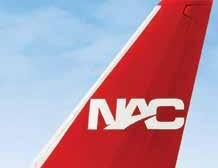
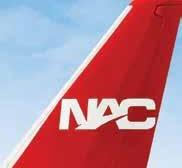



■ 1-7 Import/Exports Terminals
■ 8-15 Import/Exports Terminals
■ 44-50 Import/Exports Terminals
■ 1-7 Import Only Terminals
■ 8-15 Import Only Terminals
■ 44-50 Import Only Terminals
■ 1-7 Export Only Terminals
■ 8-15 Export Only Terminals
■ 16-22 Export Only Terminals
Funny thing about Alaska natural gas: the state has too much in the wrong place. Gas associated with North Slope oil fields has been, for the most part, stranded and isolated from the market. Meanwhile, so much gas used to bubble up from Cook Inlet wells that it could be sold to Japan. Lately, though, not so much; exports ended years ago, and Southcentral utilities are looking at imports to supplement the region’s energy supply.
As reported in this month's article "LNG In, LNG Out" by Terri Marshall, the idled export terminal in Nikiski is poised to become a lifeline for imported gas. Trans-Foreland Pipeline Company, a unit of Marathon Petroleum Corporation, sought federal permission in 2022 to reverse the valves, so to speak, by the end of 2025. Marathon announced the plan in 2023, and earlier this year the company agreed to hand the facility over to Harvest Alaska, an affiliate of Hilcorp, to finish the job.
Nikiski remains the planned endpoint for a pipeline to export North Slope gas, and in March the project received a major boost. Taiwan’s state-owned energy company, CPC Corporation, signed a letter of intent to buy Alaska gas and invest in development of the pipeline. It wasn’t a binding agreement, but it’s a show of confidence in a project that puts Alaska in competition with gas exporters around the globe.
This edition of Alaska Trends scouts the competition by studying Global Energy Monitor's tracker of liquefaction (export) and regasification (import) infrastructure cross-referenced with a 2024 report from the International Group of Liquified Natural Gas Importers.
SOURCES: “Global
19 LNG Terminals
5 Liquefaction Terminals
Australia (1), Mexico (1), Republic of Congo (1), Russia (1), USA (1)
14 Regasification Terminals
China (6), Brazil (3), Germany (1), Greece (1), Italy (1), South Korea (1), Vietnam (1)
Its strong growth is driven by a rebound in industrial production.
What book is currently on your nightstand?
Greenlights by Matthew McConaughey and Repurposed: How God Turns Your Mess into His Message by Noe Garcia.
What charity or cause are you passionate about?
Alaska Farmland Trust… and I’m extremely passionate about anything in the mental health space.
Is there a skill you’re currently developing or have always wanted to learn?
Health and fitness at 50 years old is something I’m trying to develop.
Dead or alive, who would you like to see perform live in concert?
Some of the old country greats like Waylon Jennings and Willie Nelson.
If you could domesticate a wild animal, what animal would it be?
[He laughs.] A lion or a tiger. The beauty and the power and their strength… Seems like it would be a great companion.

by Kerry Tasker
Farming is a full-time job for some, but for Scott Hamilton it became a hobby.
Raised on a farm across the street from the fairgrounds in Palmer, he studied business at UAA and worked in construction. From ironworker to regional manager, he climbed the ladder at JD Steel, a national fabrication and installation contractor.
“I would ruin a perfectly good pair of business pants in the shop,” he says of his hands-on management.
The employee-owned company set up its Alaska branch on the back acres of Hamilton Farms, and when the time came in 2022 to name its third-ever president, the Alaskan got the nod. Since the promotion, Hamilton splits his time between Palmer and corporate headquarters in Phoenix, where JD Steel is finishing one of its biggest jobs to date, a massive microchip factory.
Alaska Business: What’s the first thing you do when you get home after a long day at work?
Scott Hamilton: As soon as I arrive at Hamilton Farms… I’m either checking on the set-up or tear-down of an event or the dryness of hay or the irrigation pipes. Always roam around the grounds.
AB: What do you do in your free time?
Hamilton: All things related to farming, whether it’s harvest season and making hay or building fences… For us, it’s a family event.
AB: What vacation spot is on your bucket list?
Hamilton: You can probably count on one half-severed hand how many times I’ve taken vacations… I’ve been
blessed to work and tour all over the country, so I’d probably say Ireland is first on the list.
AB: What’s your favorite local restaurant?
Hamilton: Because I travel almost weekly, my favorite restaurant is my kitchen or my parents’ kitchen… what we used to call MGS: Mom’s Greasy Spoon.
AB: What’s the most daring thing you’ve ever done?
Hamilton: I’m a “hike anything, climb anything” type person, but I don’t have, like, this big daring thing. Lots of goals… pushing myself, but pretty vanilla.
AB: What’s your greatest extravagance?
Hamilton: [He laughs.] I am the most unextravagant human being, but I would say a fleet of blue tractors at Hamilton Farms… That would probably be another man’s SuperCub or another man’s Porsche.

AB: What are you superstitious about?
Hamilton: I’m too purpose driven and too guided by faith that there is not a superstition that I [practice anywhere] on the planet.
AB: What’s your best attribute and worst attribute?
Hamilton: No question, my best attribute is bigpicture vision, knowing for myself and for my team exactly who we serve… My worst is probably I’m way too driven, and I have not learned the art of rest and the art of standing still.
2 Mobius Technology Solutions, Inc.......................... 93 2mobius.com
Airport Equipment Rentals ................................. 127 airportequipmentrentals.com
Alaska Dreams Inc 19 alaskadreamsinc.com
Alaska Materials 45 alaskamaterials.com
Alaska Pacific University 11 alaskapacific.edu
Alaska Pump & Supply 83 alaskapump.com
Altman, Rogers & Co. 25 altrogco.com
Anchorage Convention Centers 109 anchorageconventioncenters.com
Anchorage Sand & Gravel ...... 51 anchsand.com
ARG Industrial ........................ 63 alaskarubber.com
ASRC Energy Services, LLC ..... 98 asrcenergy.com
Associated General Contractors of Alaska ................................. 89 agcak.org
Conam Construction Co 35 conamco.com
Conrad-Houston Insurance Agency 12
chialaska.com
Construction Machinery Industrial 2 cmiak.com
Cook Inlet Tug & Barge Inc 37 cookinlettug.com
Craig Taylor Equipment 49 craigtaylorequipment.com
Crowley Fuels 105 crowley.com
Cruz Companies 76 cruzconstruct.com
Davis Block & Concrete .......... 73 davisblock.com
Davis Constructors & Engineers Inc 21 davisconstructors.com
Denali Commercial 23 denalicommercial.com
DesertAir Alaska .................... 91 desertairalaska.com
Design Alaska 45 designalaska.com
Dorsey & Whitney LLP 70 dorsey.com/locations/anchorage
Doyon, Limited ....................... 11 doyon.com
Engineered Solutions Group 53 esgrp.net
Equipment Source, Inc ........... 47 esialaska.com
Exclusive Paving 45 colaska.com
First National Bank Alaska 5 fnbalaska.com
Frampton Opinsky, LLC ........ 117 officeak.com
Great Northwest Inc 31 grtnw.com
Greer Tank 35 greertank.com
Highmark Marine Fabrication, LLC ...................... 75 highmarkmarine.com
Holmes Weddle & Barcott 111 hwb-law.com
IMA Financial Group ............. 107 imacorp.com
JAG Alaska 33 jagalaska.com
Landye Bennett Blumstein LLP 27 lbblawyers.com
Lennon Crane & Equipment Co. ..................... 103 lennoncrane.com
LONG Building Technologies 67 long.com
Lynden 128 lynden.com
MICROCOM 3 microcom.tv
Mike Green Leadership 113 mikegreenleadership.com
MT Housing Inc. 55 mthousing.net
NCB 81 ncb.coop
NECA Alaska Chapter 65 alaskaneca.org
Nenana Heating Services, Inc 37 nenanaheatingservicesinc.com
Nortech Environmental & Engineering 57 nortechengr.com
North Star Behavioral Health System 12 northstarbehavioral.com
Northern Air Cargo ...... 120, 121 nac.aero
Northrim Bank ....................... 61 northrim.com
Oxford Assaying & Refining Inc ............................ 85 oxfordmetals.com
PeopleAK .............................. 113 peopleak.com
Personnel Plus Employment Agency .............. 29 perplus.com
Petro Marine Services 79 petromarineservices.com
PND Engineers Inc. 69 pndengineers.com
R & M Consultants Inc. 25 rmconsult.com
Resolve Marine 43 resolvemarine.com
Resource Development Council 95 akrdc.org
RESPEC 111 respec.com
Samson Tug & Barge .............. 81 samsontug.com
Schwabe, Williamson & Wyatt, P.C. ........................... 41 schwabe.com/locations-anchorage-alaska
Sheet Metal Inc 99 sheetmetalinc.com
Sourdough Express, Inc. 77 sourdoughexpress.com
Spenard Builders Supply 42 sbsalaska.com
Sprung Structures 7 sprung.com
Stellar Designs Inc 83 stellar-designs.com
T. Rowe Price 15 alaska529plan.com
The Plans Room ...................... 21 theplansroom.com
Think Office 97 thinkofficellc.com
TOTE Maritime Alaska LLC........ 9 totemaritime.com
Tutka, LLC 13 tutkallc.com
Two Friends Coaching & Consulting 17 2friendscoaching.com
Udelhoven Oilfield System Services, Inc 103 udelhoven.com
Umialik Insurance Company .. 90 umialik.com
United Way of Anchorage 87 liveunitedanc.org
Watterson Construction ........ 71 wattersonconstruction.com
Western Pacific Crane & Equipment .............................. 59 wpcrane.com
WillScot 93 willscot.com
Yukon Equipment Inc ............. 39 yukoneq.com








